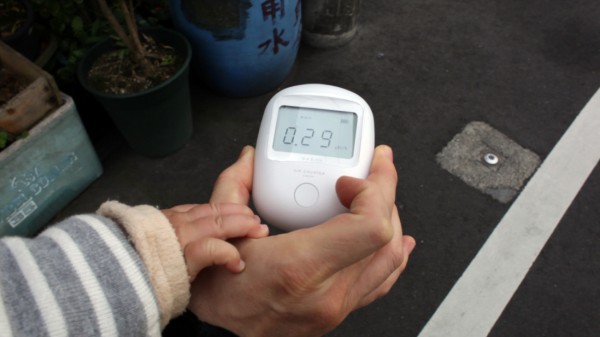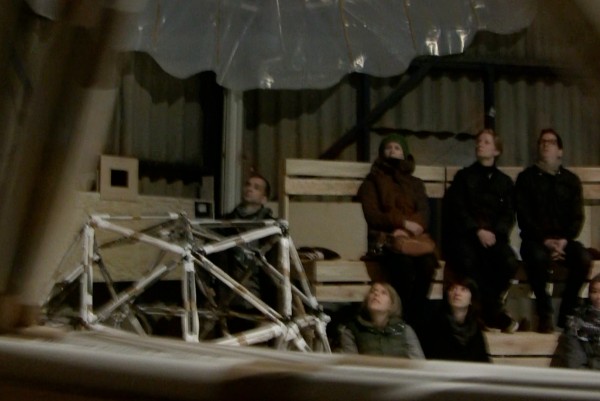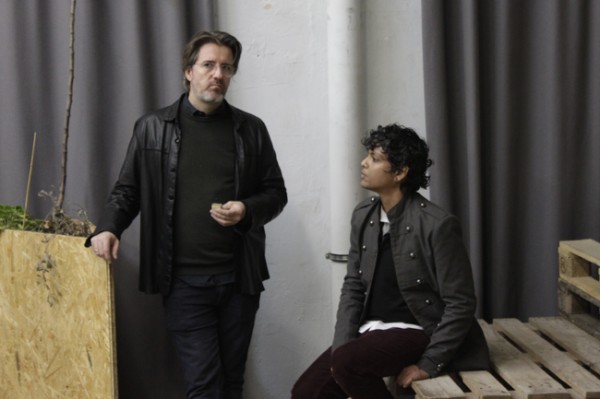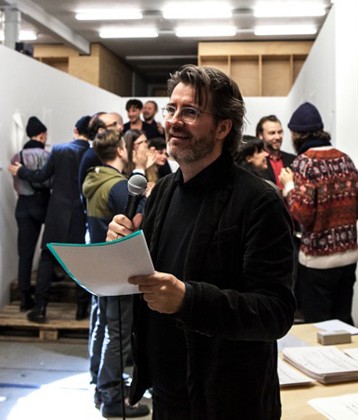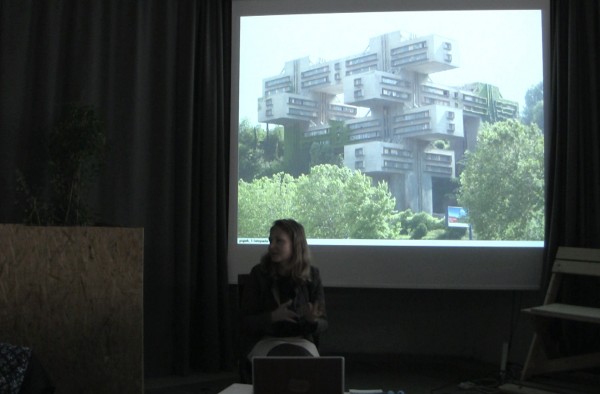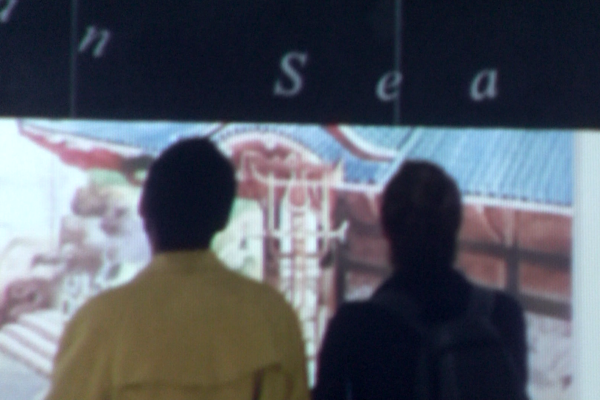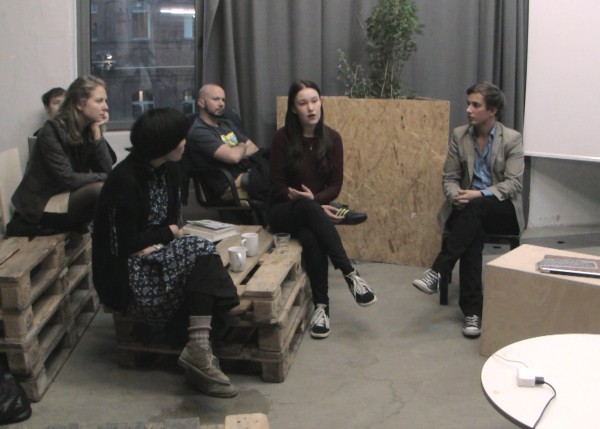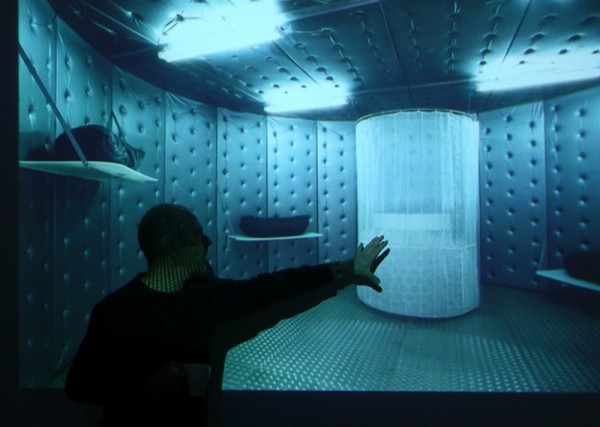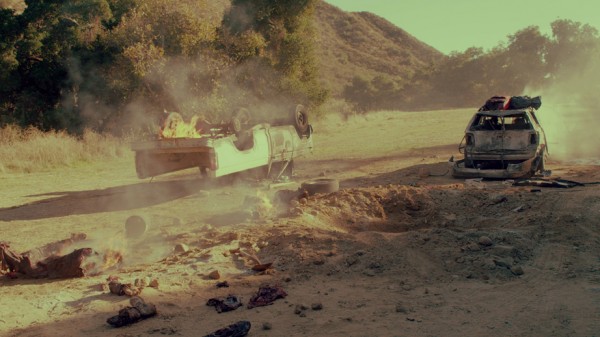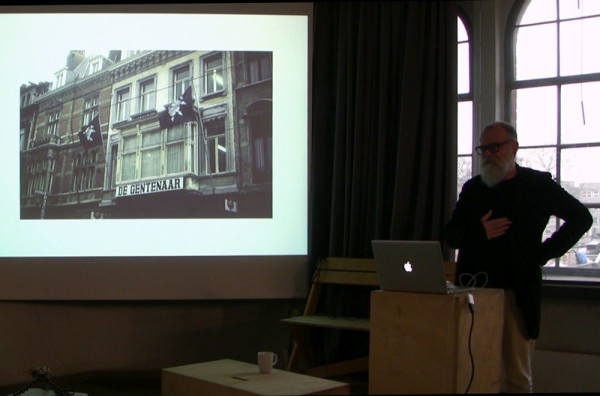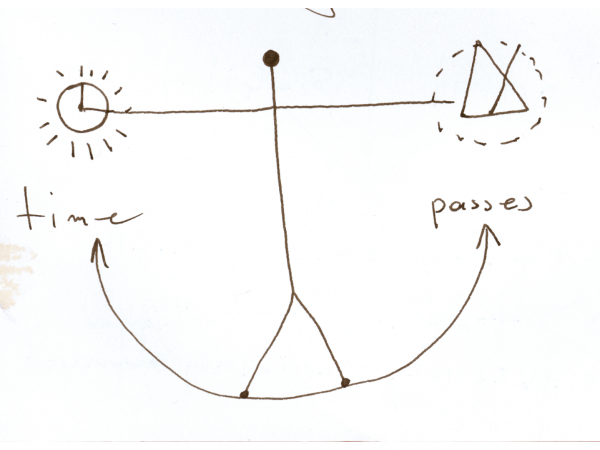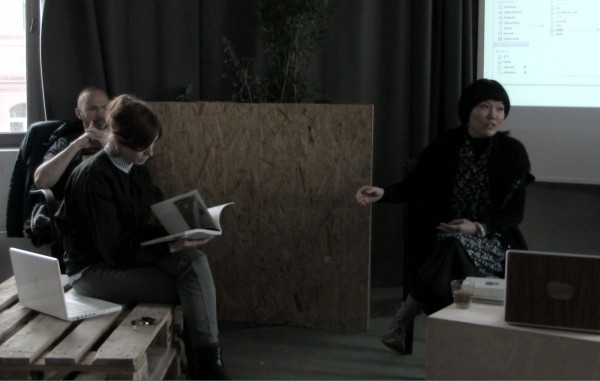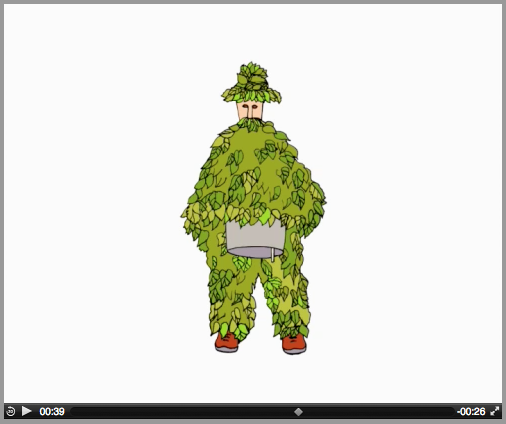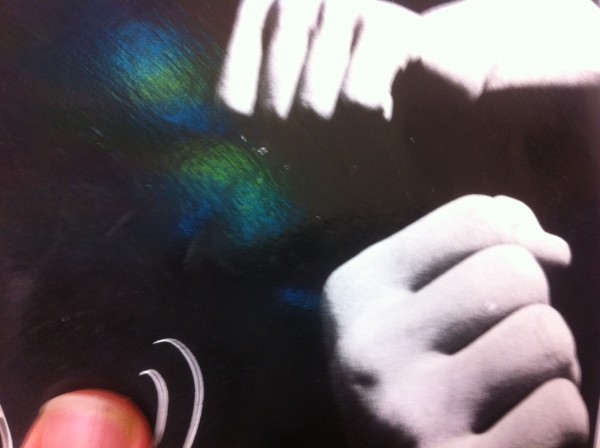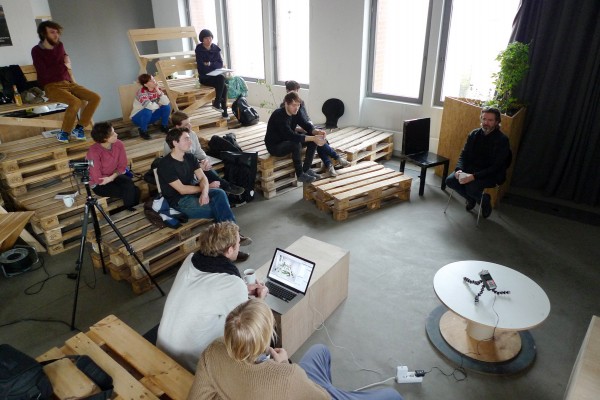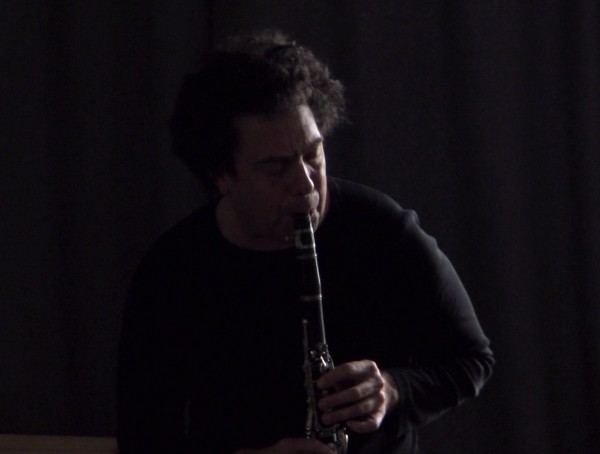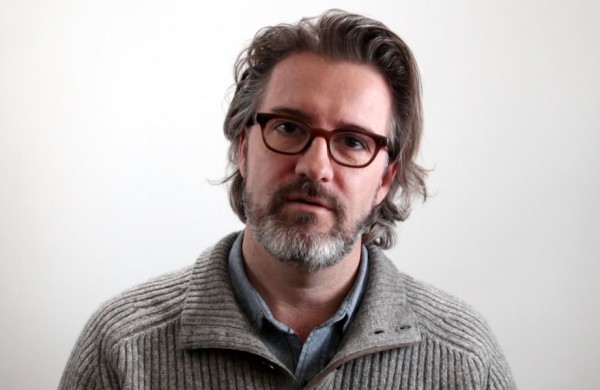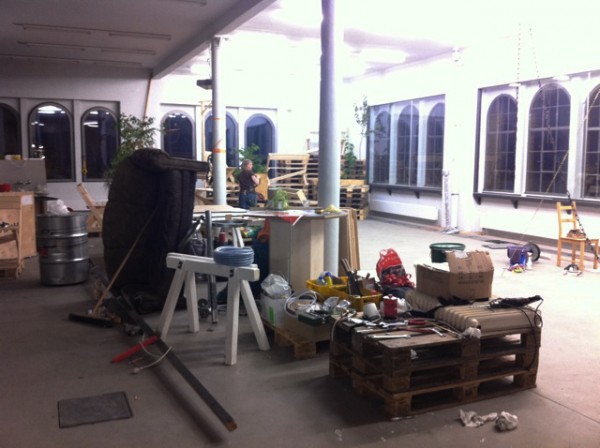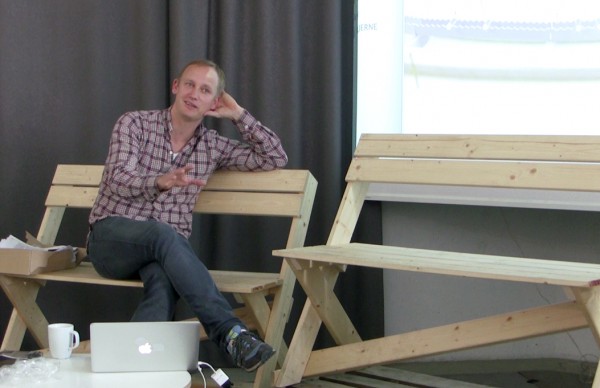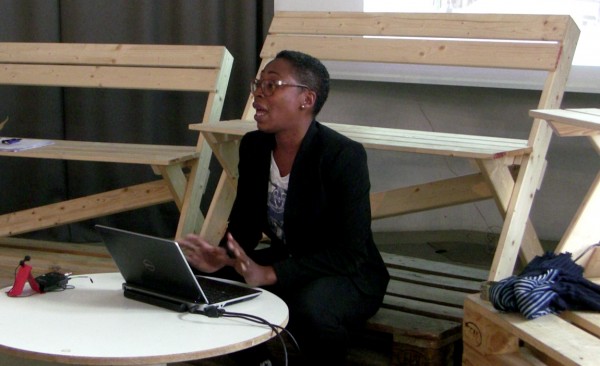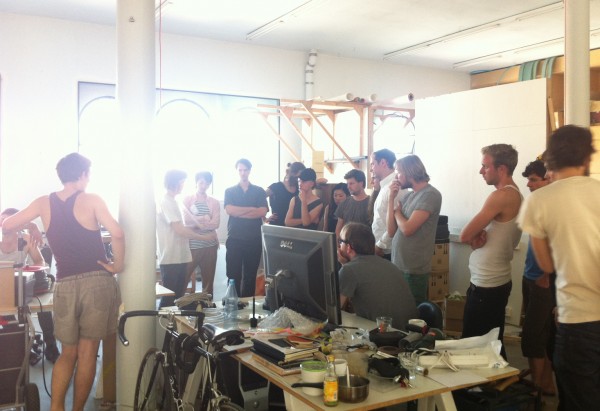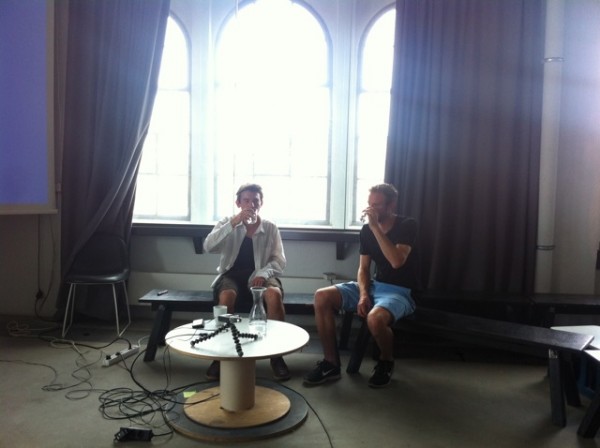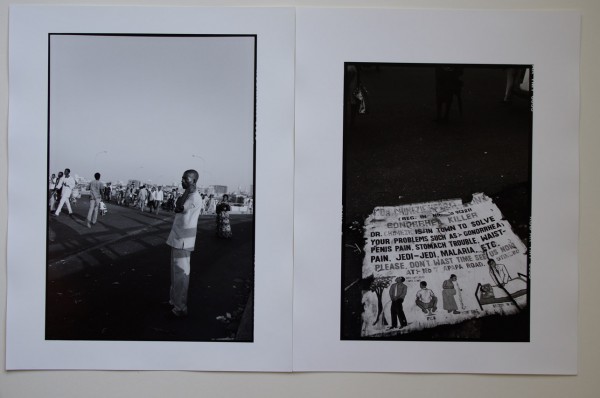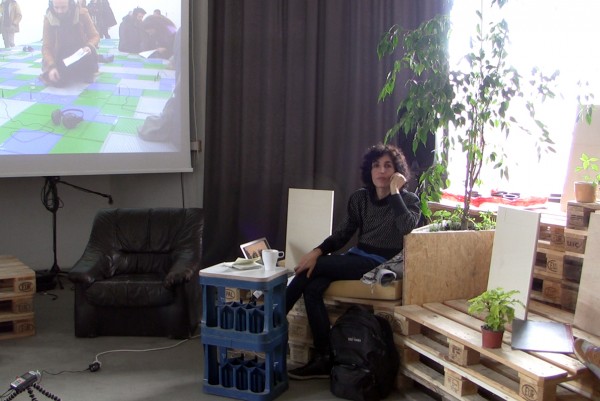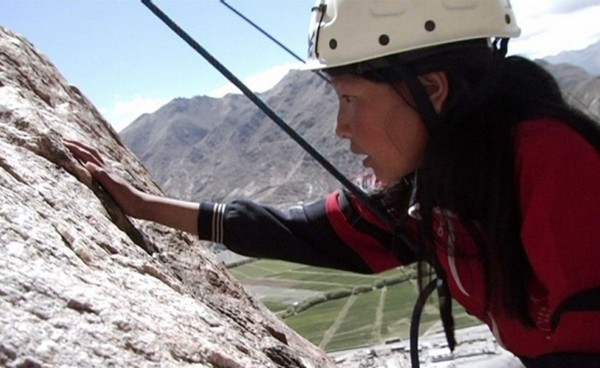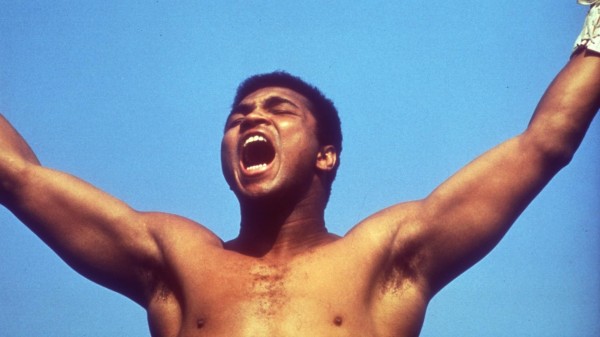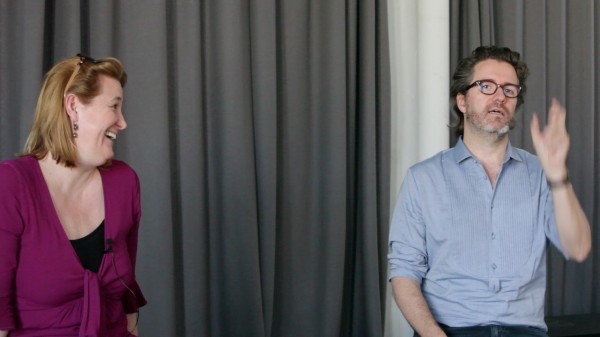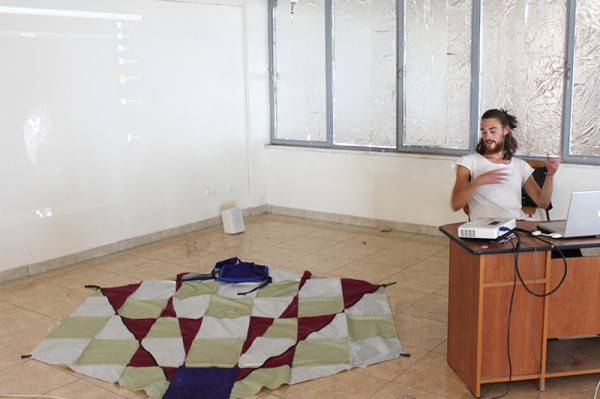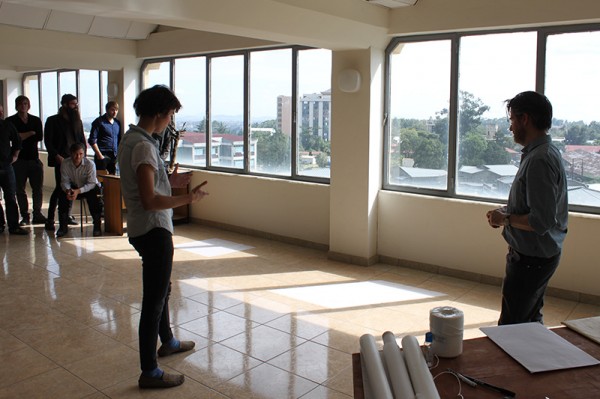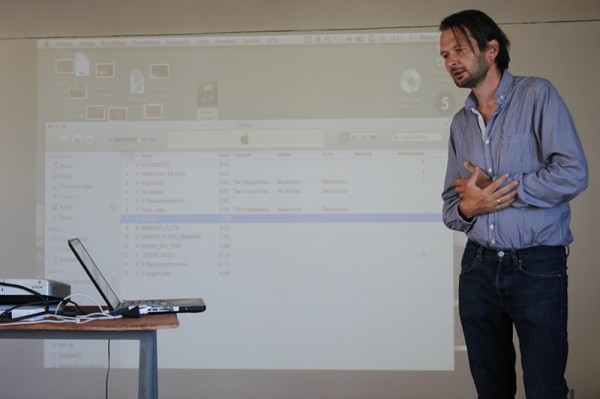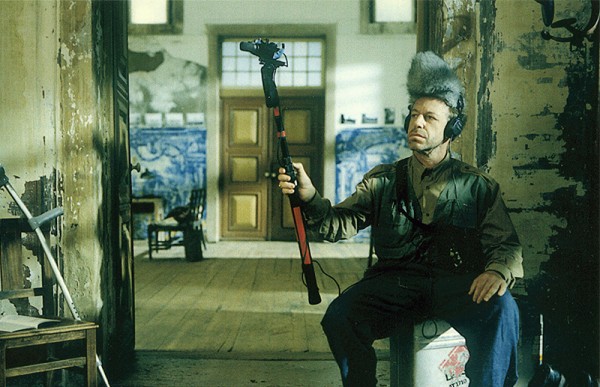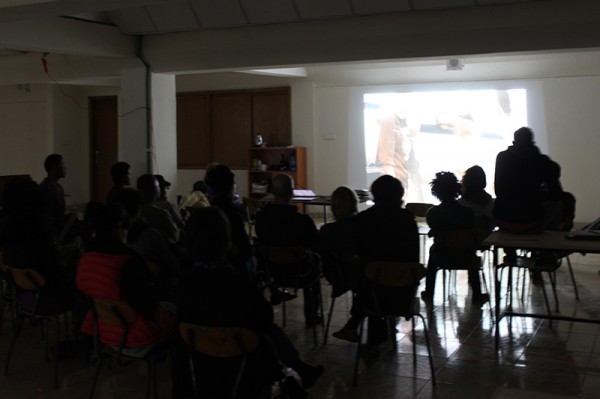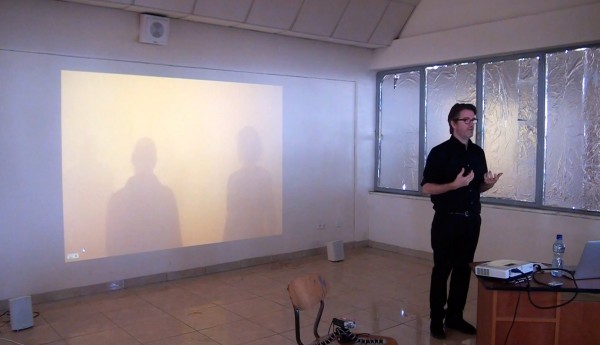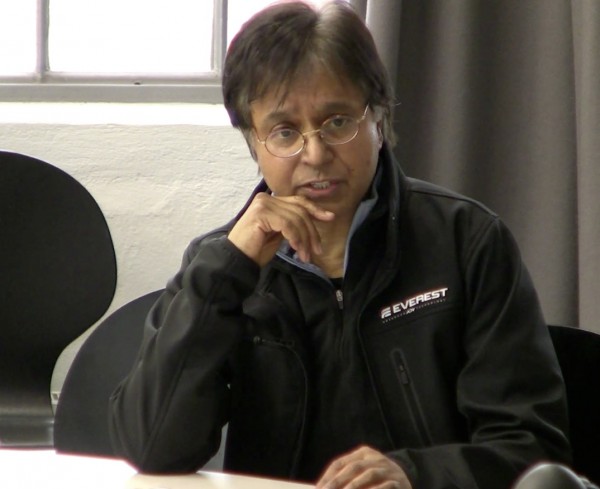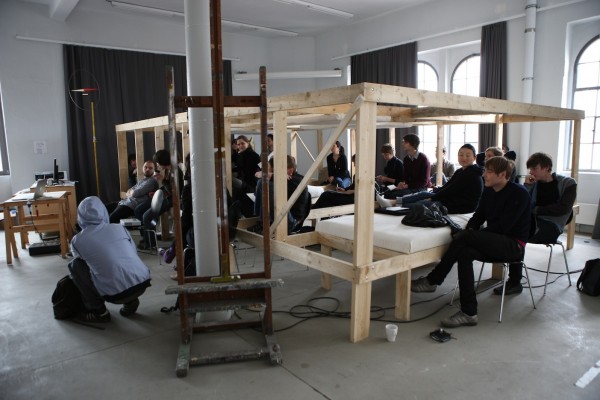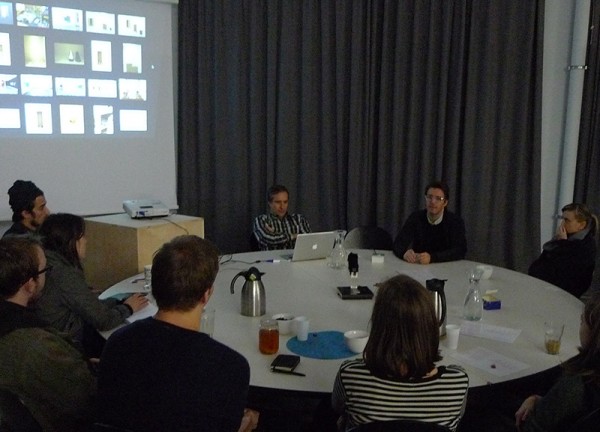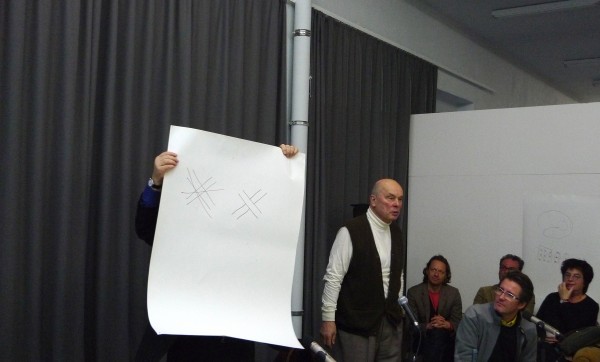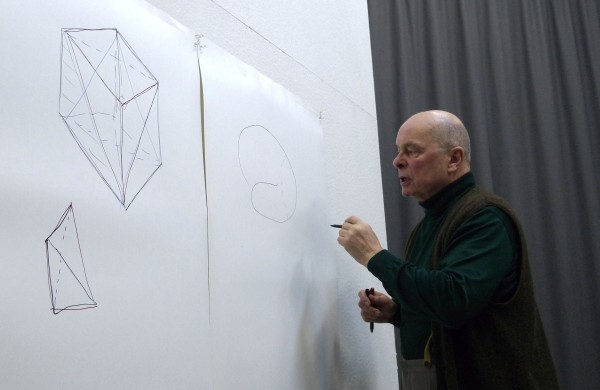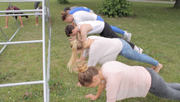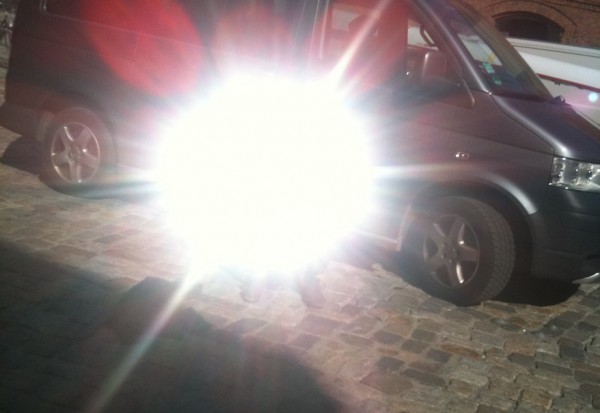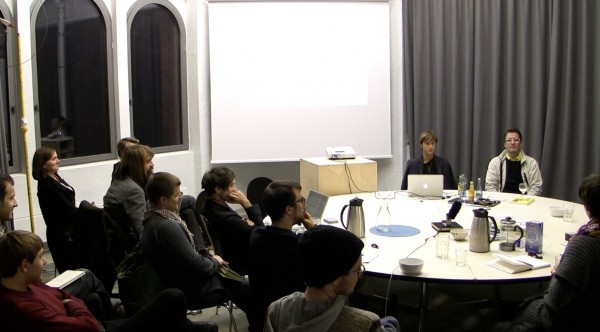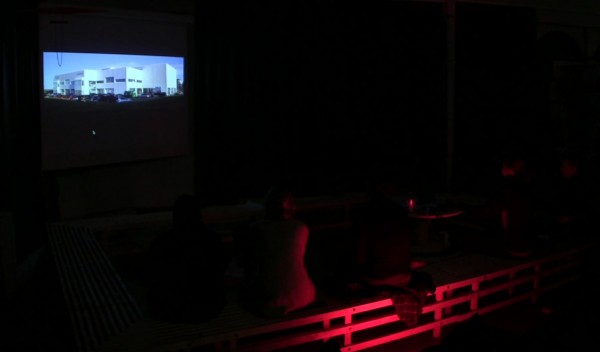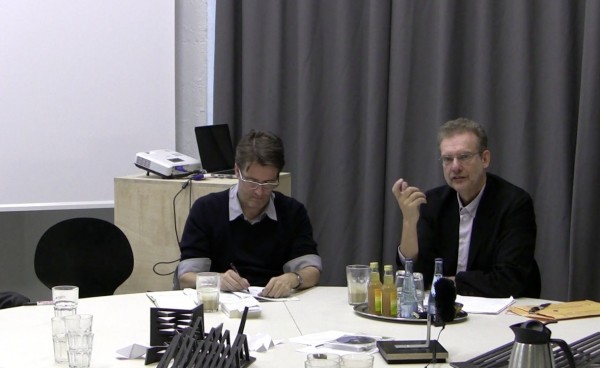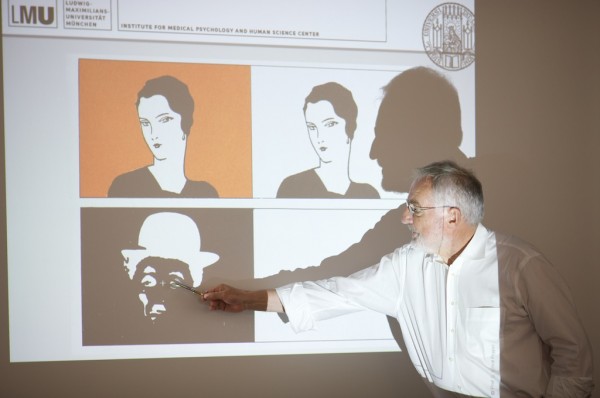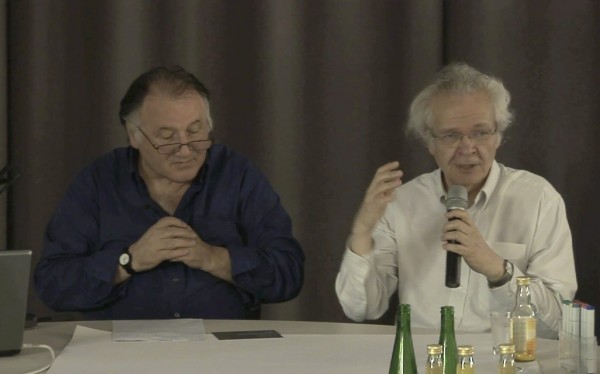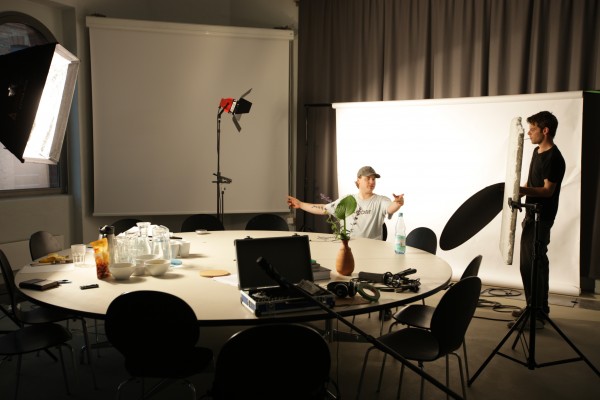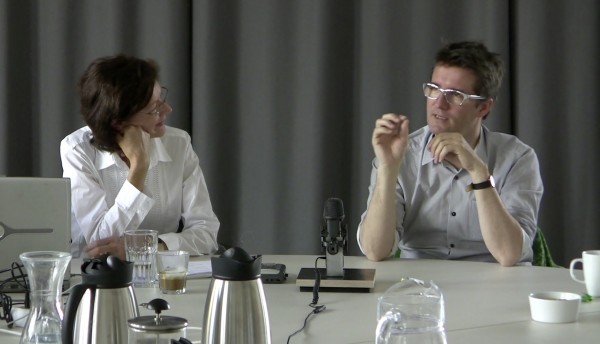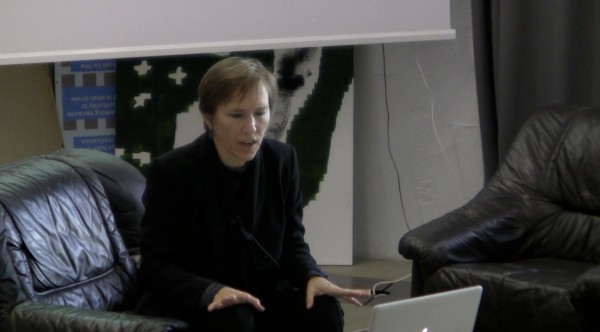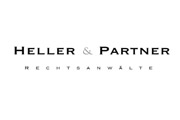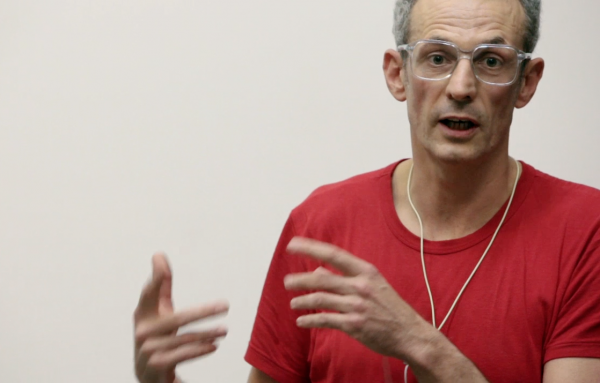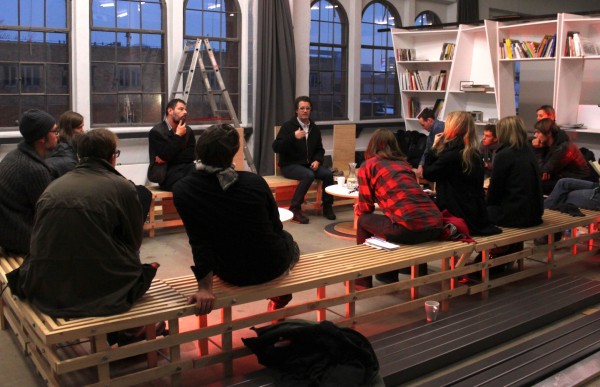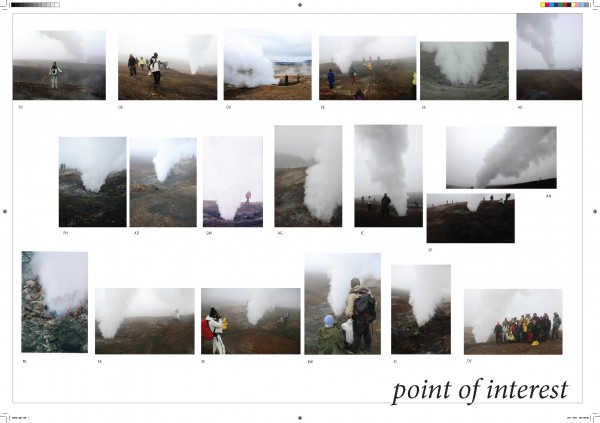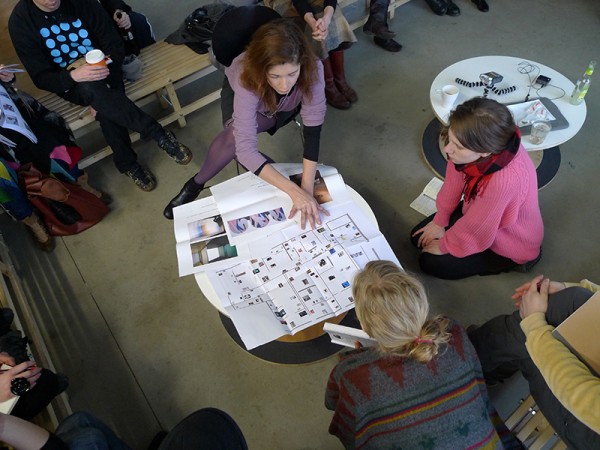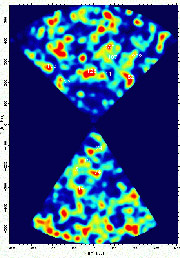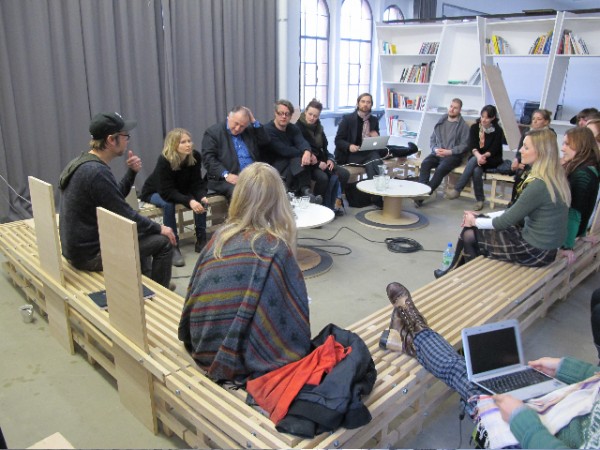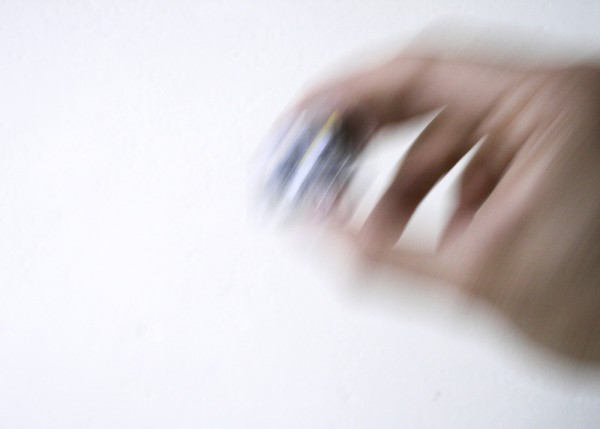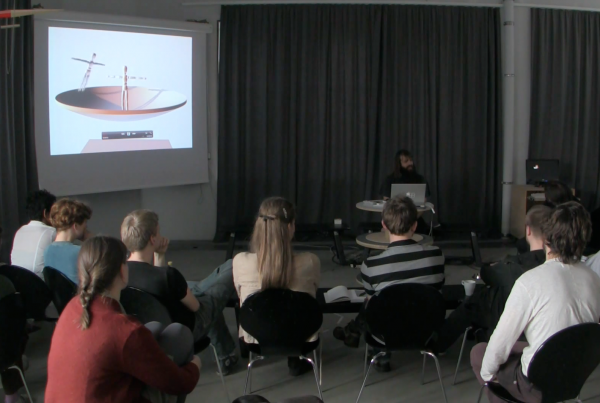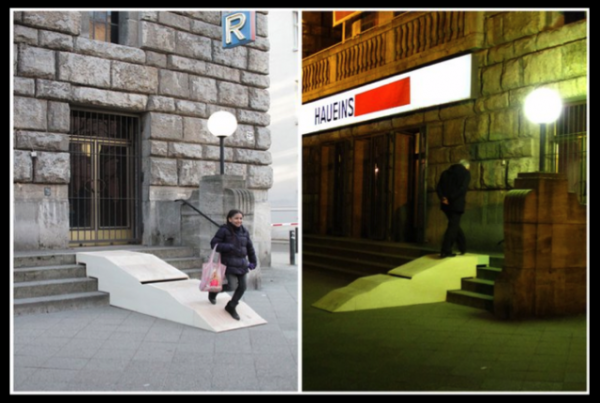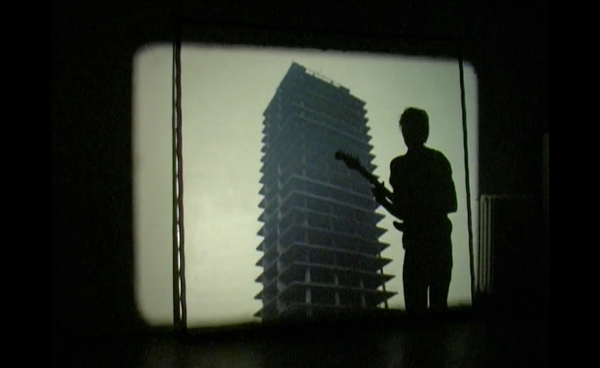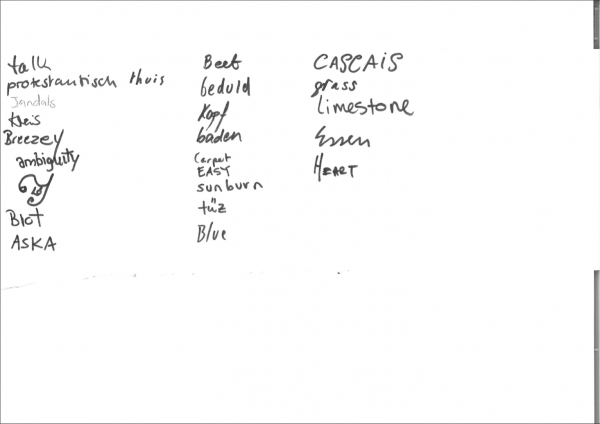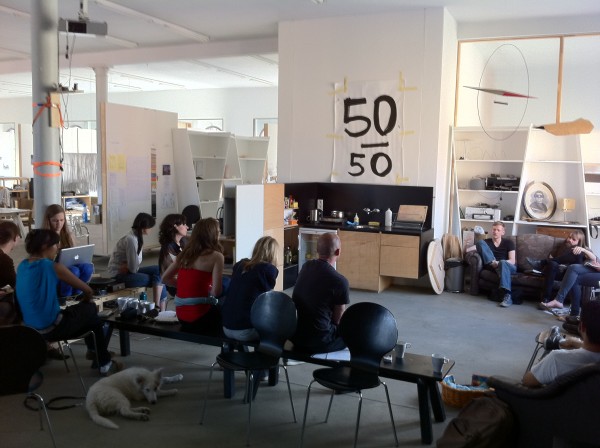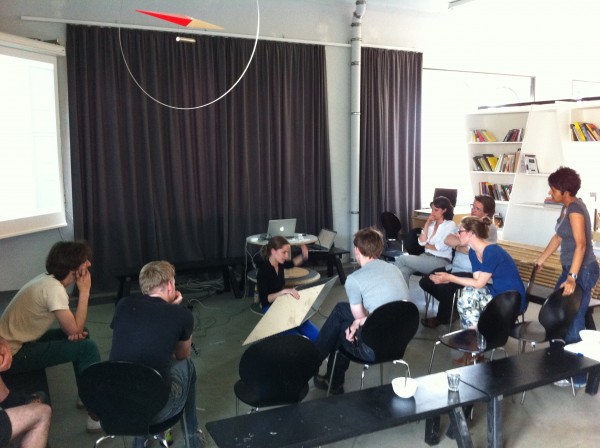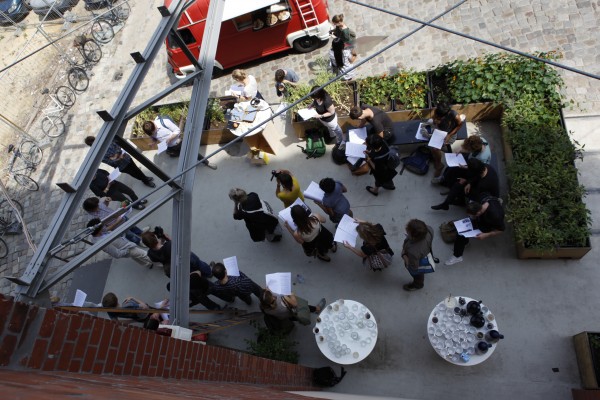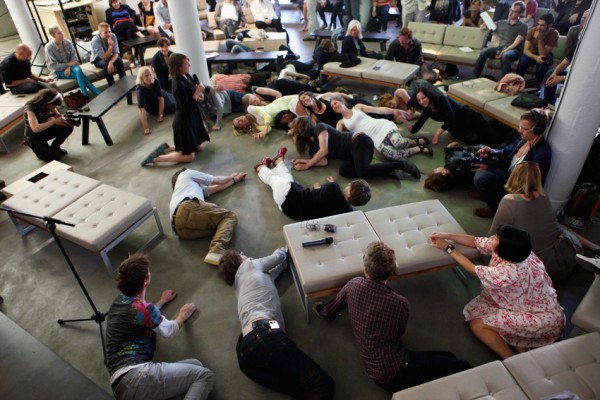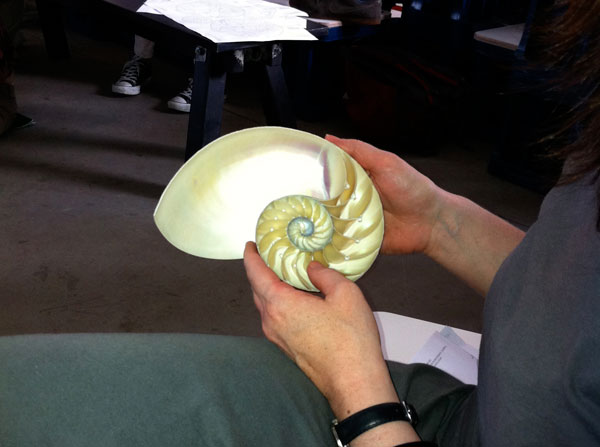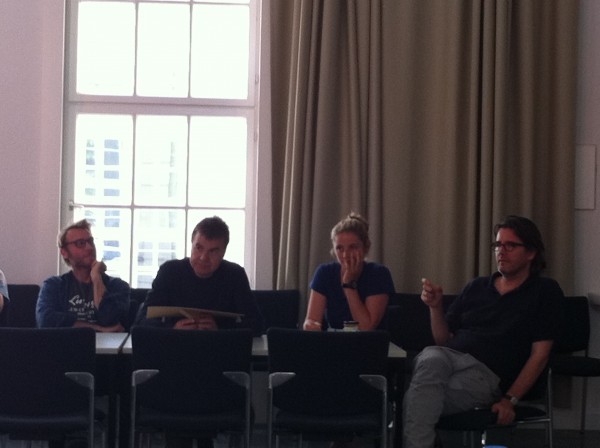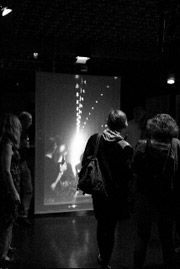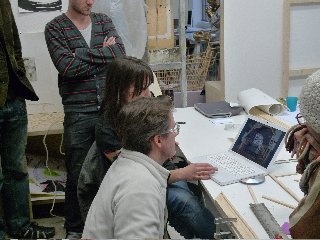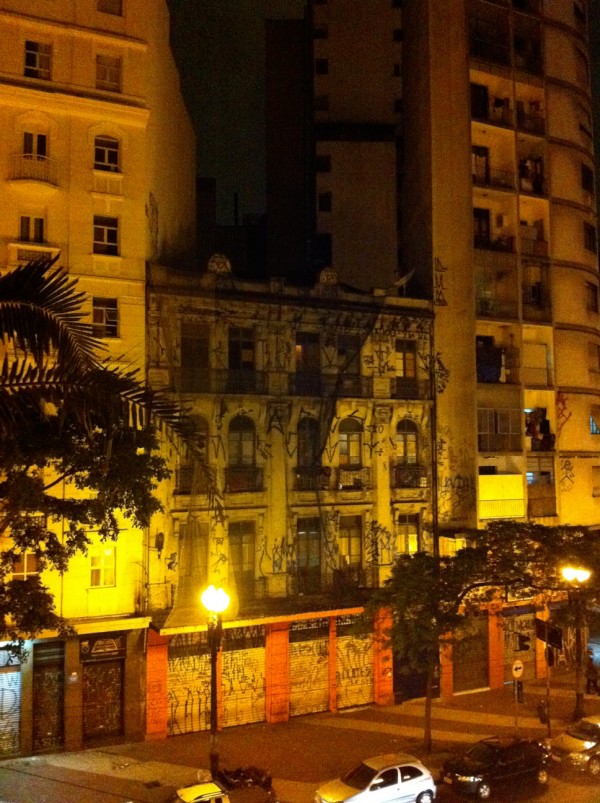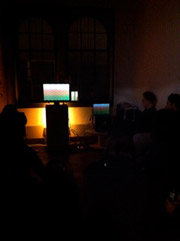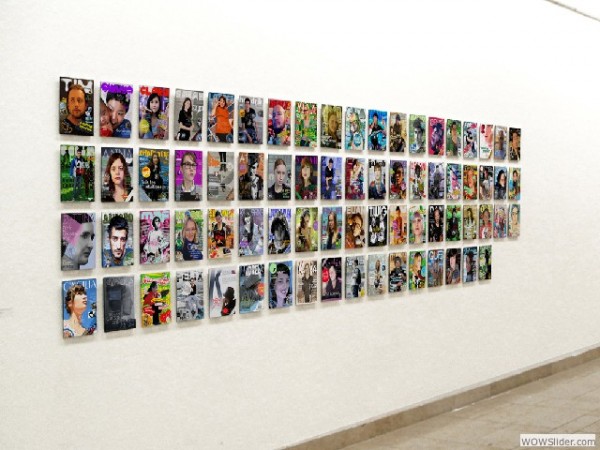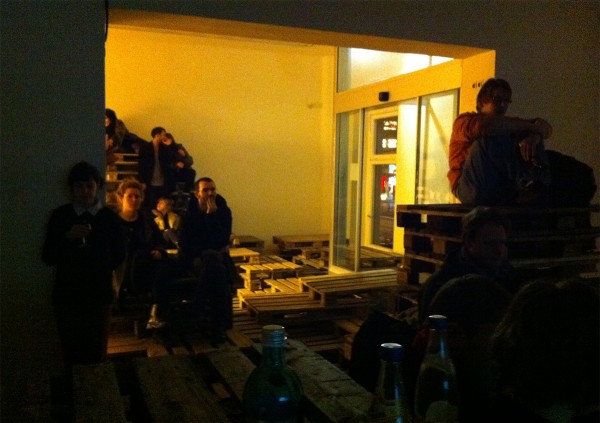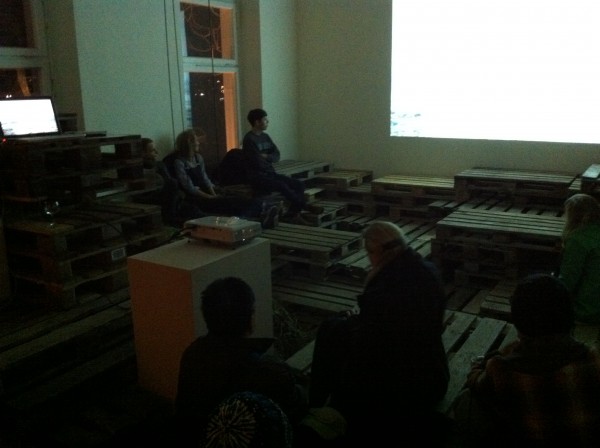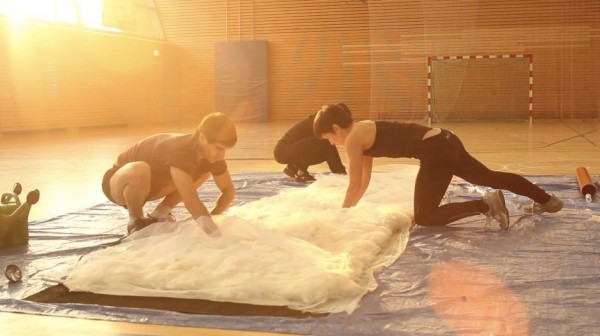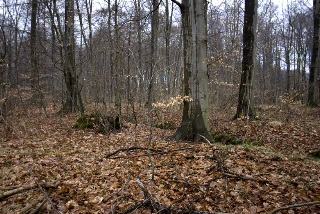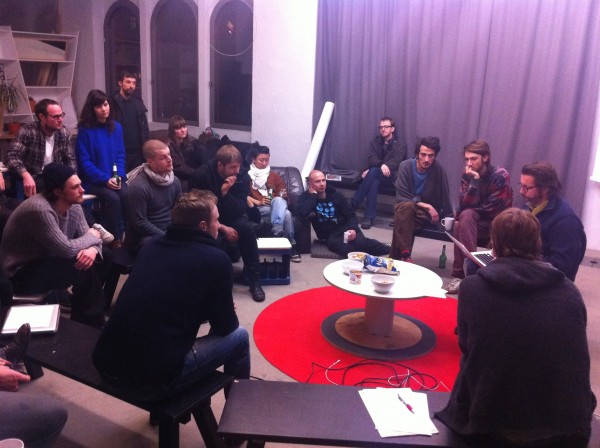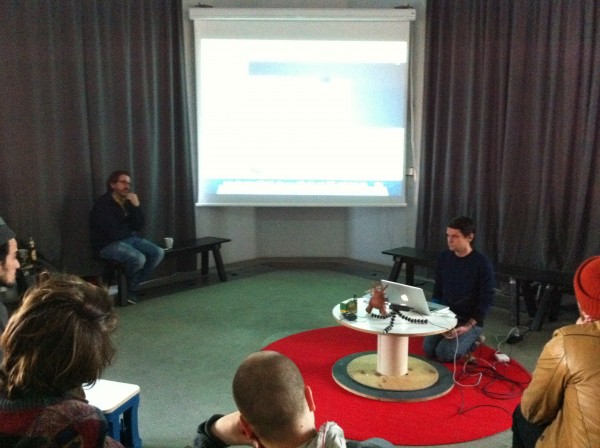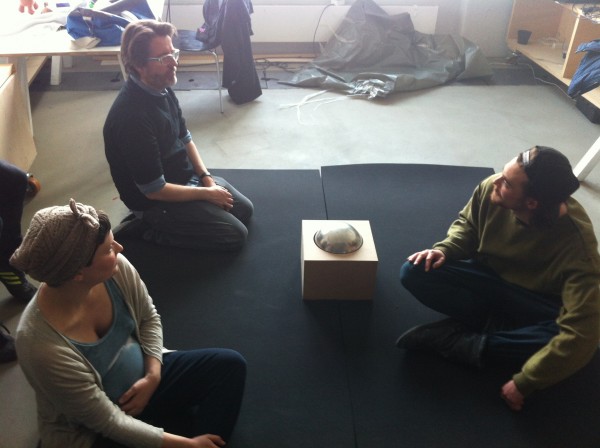11. - 13. Oktober 2019 / Kooperation, Dialog ⟶
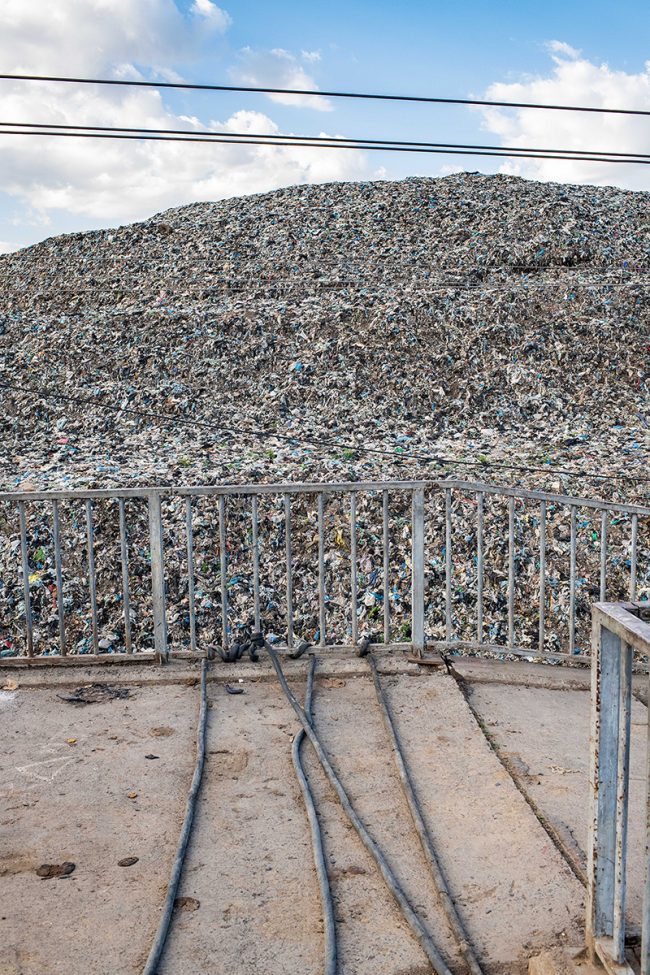
Workshop for „Atmospheres in the Urban Anthropocene – International and Cross-disciplinary Research Network“
Photo: Yero Adugna Eticha
Workshop in Addis Ababa, Ethiopia
The research project Atmospheres in the Urban Anthropocene – International and Cross-disciplinary Research Network was initiated and conceived by the Aarhus School of Architecture, established with the aim of developing an affective-sensory approach to the urban Anthropocene by bridging two strands of research which are hitherto unrelated: 1) research that has investigated the urban and the Anthropocene without much attention to affective and sensory issues, and 2) recent urban and architectural research into atmosphere that has investigated the sensory affective but most often fails to address the Anthropocene.
The network arranges three workshops in distinct climatic and sensory-affective atmospheres. The first one took place in Aarhus, Denmark, 2018; the second in Addis Ababa, Ethiopia, 2019 and the third will be take place in Tromsø, Norway, 2020.
The focus of the workshop in Addis Ababa was approaches to mapping and registering of atmospheres in the urban Anthropocene. The thematic sub-focus was on „Subnatures and Biodiversity“. The
workshop was centred around mapping-artworks produced in the week preceding the workshop by artists, Yero Adugna Eticha and Leikun Nahusenay, in collaboration with architects, Rasmus Hjortshøj and Asbjørn Jessen, as well as by Muluadam Adane, Michael Hailu, Gashahun Kassahun, Tewodros Kifle, Temesgen Mastewal, and Solomon Shifraw Abebe – students from the Alle School of Fine Arts that participated in the workshop Mapping the Invisible City led by Makeda Begashaw, Polina Chebotareva and Christina Werner. The mapping-artworks were exhibited at Guramayne Art Center for the duration of the workshop and incorporated in the workshop lectures and discussions.
–
Organisation: Polina Chebotareva (Aarhus School of Architecture) and Christina Werner (Institut für Raumexperimente / Studio Olafur Eliasson in Berlin)
Network partners: Suzel Balez (École nationale supérieure d’architecture de Grenoble), Peder Klith Bøcher (Aarhus University / Center for Biodiversity Dynamics in a Changing World (BIOCHANGE)), Thomas Juel Clemmensen (The Arctic University of Norway), Rasmus Hjortshøj (Aarhus School of Architecture), Asbjørn Jessen (University of Copenhagen, Section Landscape Architecture and Planning), Tom Nielsen (Aarhus School of Architecture), Martin Prominski (Leibniz University Hannover), Jean-Paul Thibaud (École nationale supérieure d’architecture de Grenoble)
Collaborators Addis Ababa: Yero Adugna Eticha (photographer), Makeda Begashaw (Alle School of Fine Arts and Design, Addis Ababa University), Leikun Nahusenay (artist), Robel Temesgen (Alle School of Fine Arts and Design, Addis Ababa University), Brook Teklehaimanot (Addis Ababa University, EiABC protoLAB), Mifta Zekele (Guramayne Art Center)
–
Thanks to the Alle School of Fine Arts and Design, Addis Ababa University and Guramayne Art Center.
–
Photo: Yero Adugna Eticha
Photo: Rasmus Hjortshøj
Photo: Yero Adugna Eticha
Workshop in Addis Ababa, Ethiopia
The research project Atmospheres in the Urban Anthropocene – International and Cross-disciplinary Research Network was initiated and conceived by the Aarhus School of Architecture, established with the aim of developing an affective-sensory approach to the urban Anthropocene by bridging two strands of research which are hitherto unrelated: 1) research that has investigated the urban and the Anthropocene without much attention to affective and sensory issues, and 2) recent urban and architectural research into atmosphere that has investigated the sensory affective but most often fails to address the Anthropocene.
The network arranges three workshops in distinct climatic and sensory-affective atmospheres. The first one took place in Aarhus, Denmark, 2018; the second in Addis Ababa, Ethiopia, 2019 and the third will be take place in Tromsø, Norway, 2020.
The focus of the workshop in Addis Ababa was approaches to mapping and registering of atmospheres in the urban Anthropocene. The thematic sub-focus was on „Subnatures and Biodiversity“. The
workshop was centred around mapping-artworks produced in the week preceding the workshop by artists, Yero Adugna Eticha and Leikun Nahusenay, in collaboration with architects, Rasmus Hjortshøj and Asbjørn Jessen, as well as by Muluadam Adane, Michael Hailu, Gashahun Kassahun, Tewodros Kifle, Temesgen Mastewal, and Solomon Shifraw Abebe – students from the Alle School of Fine Arts that participated in the workshop Mapping the Invisible City led by Makeda Begashaw, Polina Chebotareva and Christina Werner. The mapping-artworks were exhibited at Guramayne Art Center for the duration of the workshop and incorporated in the workshop lectures and discussions.
–
Organisation: Polina Chebotareva (Aarhus School of Architecture) and Christina Werner (Institut für Raumexperimente / Studio Olafur Eliasson in Berlin)
Network partners: Suzel Balez (École nationale supérieure d’architecture de Grenoble), Peder Klith Bøcher (Aarhus University / Center for Biodiversity Dynamics in a Changing World (BIOCHANGE)), Thomas Juel Clemmensen (The Arctic University of Norway), Rasmus Hjortshøj (Aarhus School of Architecture), Asbjørn Jessen (University of Copenhagen, Section Landscape Architecture and Planning), Tom Nielsen (Aarhus School of Architecture), Martin Prominski (Leibniz University Hannover), Jean-Paul Thibaud (École nationale supérieure d’architecture de Grenoble)
Collaborators Addis Ababa: Yero Adugna Eticha (photographer), Makeda Begashaw (Alle School of Fine Arts and Design, Addis Ababa University), Leikun Nahusenay (artist), Robel Temesgen (Alle School of Fine Arts and Design, Addis Ababa University), Brook Teklehaimanot (Addis Ababa University, EiABC protoLAB), Mifta Zekele (Guramayne Art Center)
–
Thanks to the Alle School of Fine Arts and Design, Addis Ababa University and Guramayne Art Center.
–
Photo: Yero Adugna Eticha
Photo: Rasmus Hjortshøj
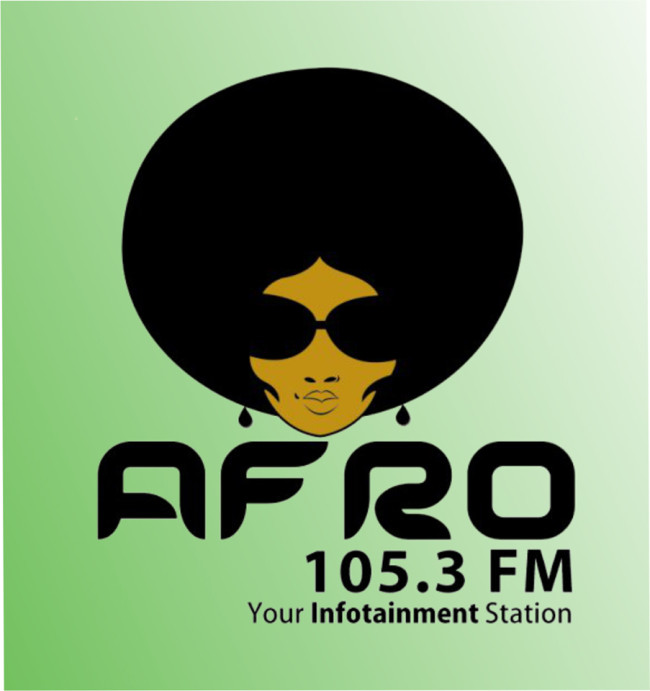
Radio interview at AFRO FM 105.3, Addis Ababa
On air: Justified Nature, radio program with Erica Licht and Clara Jo, Mihret Kebede, Robert Lippok, Rike Scheffler, Christina Werner
Justified Nature – a radio program hosted by Erica Licht in Addis Ababa on AFRO FM 105.3
Interview with Erica Licht and Clara Jo, Mihret Kebede, Robert Lippok, Rike Scheffler and Christina Werner
Justified Nature, 23.2.2015
Conversation on Poetry Jazz and A-B-A-B-A : from here to hear, the third experimental get-together of poets, musicians and translators based in Addis Ababa and in Berlin, who join in this exercise of styles. Testing new structures and methods in a dialogue, the workshop sets out to explore oral traditions in Amharic poetry culture, translations and interpretations between German, English and Amharic, and performative elements on stage, including music traditions from traditional Ethiopian music, jazz elements and contemporary electronic music. The concert takes place at the Alliance Ethio-Française d’Addis-Abeba on 27.2.2015, 20h.
Participating artist: Clara Jo (artist, Berlin), Mihret Kebede (poet, Addis Abeba), Erica Licht (poet, Addis Ababa), Robert Lippok (musician, Berlin), Bekele Mekonnen (poet, Addis Ababa), Nebiy Mekonnen (poet/translator, Addis Ababa), Abebaw Melaku (poet, Addis Abeba), Rike Scheffler (poet, Berlin), Misrak Terefe (poet, Addis Abeba), Moseb Traditional Music Band (Addis Ababa), and Christina Werner (Berlin).
—
Eine Veranstaltung, choreographiert von Mihret Kebede and Christina Werner, im Rahmen von Acting Archives, einem Projekt des Instituts für Raumexperimente der Universität der Künste Berlin und der Alle School of Fine Arts and Design, Addis Ababa University, unterstützt durch Studio Olafur Eliasson, gefördert im Fonds TURN der Kulturstiftung des Bundes.
On air: Justified Nature, radio program with Erica Licht and Clara Jo, Mihret Kebede, Robert Lippok, Rike Scheffler, Christina Werner
Justified Nature – a radio program hosted by Erica Licht in Addis Ababa on AFRO FM 105.3
Interview with Erica Licht and Clara Jo, Mihret Kebede, Robert Lippok, Rike Scheffler and Christina Werner
Justified Nature, 23.2.2015
Conversation on Poetry Jazz and A-B-A-B-A : from here to hear, the third experimental get-together of poets, musicians and translators based in Addis Ababa and in Berlin, who join in this exercise of styles. Testing new structures and methods in a dialogue, the workshop sets out to explore oral traditions in Amharic poetry culture, translations and interpretations between German, English and Amharic, and performative elements on stage, including music traditions from traditional Ethiopian music, jazz elements and contemporary electronic music. The concert takes place at the Alliance Ethio-Française d’Addis-Abeba on 27.2.2015, 20h.
Participating artist: Clara Jo (artist, Berlin), Mihret Kebede (poet, Addis Abeba), Erica Licht (poet, Addis Ababa), Robert Lippok (musician, Berlin), Bekele Mekonnen (poet, Addis Ababa), Nebiy Mekonnen (poet/translator, Addis Ababa), Abebaw Melaku (poet, Addis Abeba), Rike Scheffler (poet, Berlin), Misrak Terefe (poet, Addis Abeba), Moseb Traditional Music Band (Addis Ababa), and Christina Werner (Berlin).
—
Eine Veranstaltung, choreographiert von Mihret Kebede and Christina Werner, im Rahmen von Acting Archives, einem Projekt des Instituts für Raumexperimente der Universität der Künste Berlin und der Alle School of Fine Arts and Design, Addis Ababa University, unterstützt durch Studio Olafur Eliasson, gefördert im Fonds TURN der Kulturstiftung des Bundes.
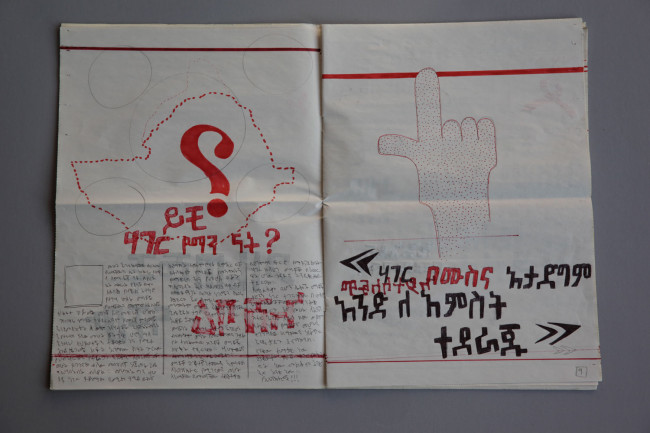
Poetry Jazz: Wax and Gold at Akademie der Künste Berlin
Uncertain States presents: Poetry Jazz: Wax and GoldFilmscreening / Lecture Demonstration / Panel
Wednesday, 26 October, 5 pm
Akademie der Künste, Hanseatenweg, Halle 2
Panel with Olafur Eliasson, Clara Jo, Robel Temesgen, Rike Scheffler, Christina Werner
in conjunction with Uncertain States – Artistic Strategies in States of Emergency
“Poetry Jazz” is the name for a particular style of performance poetry in Ethiopia fusing poetry and jazz, recitation and improvisation. The film A-B-A-B-A : from here to hear presents the eponymous experimental project series with artists from Berlin and Addis Abeba. Working together, they have created contemporary expressive styles in this tradition: Amharic, German and English poetry is combined with traditional Ethiopian music, jazz beats and contemporary electronic music. The film by Clara Jo follows the participating artists and traces their various influences as well as the challenges of reacting with the “Wax and Gold” principle of the spoken word to the issue of the free expression of opinion.
Trailer: A-B-A-B-A: from hear to here: A film by Clara Jo. 2016
A-B-A-B-A : from hear to here is part of Acting Archives, a project by the Institut für Raumexperimente, Berlin University of the Arts and the Alle School of Fine Arts and Design, Addis Ababa University, supported by Studio Olafur Eliasson, and funded by the TURN Fund of the German Federal Cultural Foundation.
Read the following article ‚Wax and Gold’. Poetry, jazz and politics, from Addis Ababa to Berlin by Mylène Palluel in Manifesto 21.
The film is followed by an experimental poetry performance by Rike Scheffler and Robel Temesgen. Exhibition artist Robel Temesgen (Visual Arts Fellow, Junge Akademie 2016) will present a series of works titled Old News that deploy the “Wax and Gold” approach in the field of visual arts. The “Wax and Gold” approach, which will be the topic of the discussion with Robel Temesgen, Rike Scheffler, Clara Jo and Christina Werner (Co-director, Instituts für Raumexperimente e.V.). Moderation: Olafur Eliasson.
Uncertain States präsentiert:
Poetry Jazz: Wax and GoldFilmscreening / Lecture-Demonstration / Diskussion
Mittwoch, 26 Oktober 2016, 17 Uhr
Akademie der Künste, Hanseatenweg, Halle 2
Diskussion mit Olafur Eliasson, Clara Jo, Robel Temesgen, Rike Scheffler, Christina Werner
im Kontext der Ausstellung Uncertain States – Künstlerisches Handeln in Ausnahmezuständen
„Poetry Jazz“ bezeichnet eine in Äthiopien geprägte Form der Lyrikperformance, die Einflüsse aus Poesie und Jazz, Rezitation und Improvisation zusammenbringt. Der Film A-B-A-B-A : from here to hear stellt die gleichnamige experimentelle Projektreihe zwischen Künstlern aus Berlin und Addis Abeba vor. Gemeinsam entstanden zeitgenössische Ausdrucksformen dieser Tradition: Amharische, deutsche und englische Dichtkunst wird mit traditioneller äthiopischer Musik, Jazz-Einflüssen und zeitgenössischer elektronischer Musik kombiniert. Der Film von Clara Jo folgt den beteiligten Künstlern und reflektiert die verschiedenen Einflüsse als auch die Herausforderung, mit dem lyrischen Prinzip von „Wachs und Gold“ auf die Problematik der freien Meinungsäußerung zu reagieren.
Trailer: A-B-A-B-A: from hear to here: A film by Clara Jo. 2016
A-B-A-B-A : from hear to here ist Teil von Acting Archives, einem Projekt des Instituts für Raumexperimente der Universität der Künste Berlin und der Alle School of Fine Arts and Design, Addis Ababa University, unterstützt durch Studio Olafur Eliasson, gefördert im Fonds TURN der Kulturstiftung des Bundes.
Eine Besprechung des Abends finden sich hier: ‚Wax and Gold’. Poetry, jazz and politics, from Addis Ababa to Berlin von Mylène Palluel in Manifesto 21.
Im Anschluss an den Film werden Rike Scheffler und Robel Temesgen eine experimentelle Poetry-Performance vorstellen. Ausstellungskünstler Robel Temesgen (Stipendiat Bildende Kunst, Junge Akademie 2016) wird anhand seiner Arbeiten aus der Serie Old News die Auseinandersetzung mit dem Prinzip „Wachs und Gold“ in der Bildenden Kunst vorstellen, das Prinzip wird Thema der Gesprächsrunde mit Robel Temesgen, Rike Scheffler, Clara Jo und Christina Werner (Geschäftsführerin des Instituts für Raumexperimente e.V.) sein. Moderation: Olafur Eliasson.
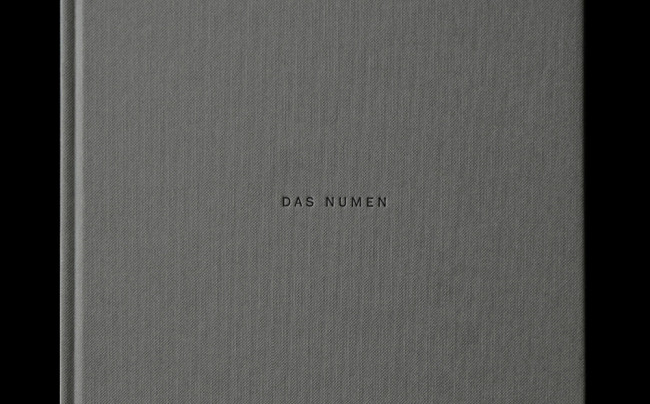
NOWs: Book Release by Das Numen
NOWs:
Das Numen, Berlin-based artists’ collective of Julian Charrière, Andreas Greiner, Markus Hoffmann, and Felix Kiessling, introduces its first mono-graphic publication by the same name, ‚Das Numen‘. The book includes recent and previous projects and a associative reflection on these by Melanie Franke, Carson Chan, Paul Feigelfeld and Otto E. Roessler. The reader is taken on a journey through interlocking references and his own individual experience.
The release is accompanied by a reading performance that will take place in the DAZ. ‚The Numen Chorus‘ de- and reconstructs the different text layers of the publication with a distinctive noise. The result is a tangible sound experience created by four overlaying reading voices. Readings by: Paul Feigelfeld, Lucas Töpfer, Melanie Franke, Toni Jessen and Anja Schwanhäußer.
A bar will offer local cocktails and a hub for the visitors to discuss both the publication and the ideas behind ‚Das Numen‘. The launch will be celebrated with specially transformed cocktails made with purified, site-specific water that has been sourced from the Spree river.
The evening will be held in German and English.
Meet Das Numen at Deutsches Architektur Zentrum DAZ, Friday, May 13, 2016, 7 p.m.
NOWs:
Das Numen, Berlin-based artists’ collective of Julian Charrière, Andreas Greiner, Markus Hoffmann, and Felix Kiessling, introduces its first mono-graphic publication by the same name, ‚Das Numen‘. The book includes recent and previous projects and a associative reflection on these by Melanie Franke, Carson Chan, Paul Feigelfeld and Otto E. Roessler. The reader is taken on a journey through interlocking references and his own individual experience.
The release is accompanied by a reading performance that will take place in the DAZ. ‚The Numen Chorus‘ de- and reconstructs the different text layers of the publication with a distinctive noise. The result is a tangible sound experience created by four overlaying reading voices. Readings by: Paul Feigelfeld, Lucas Töpfer, Melanie Franke, Toni Jessen and Anja Schwanhäußer.
A bar will offer local cocktails and a hub for the visitors to discuss both the publication and the ideas behind ‚Das Numen‘. The launch will be celebrated with specially transformed cocktails made with purified, site-specific water that has been sourced from the Spree river.
The evening will be held in German and English.
Meet Das Numen at Deutsches Architektur Zentrum DAZ, Friday, May 13, 2016, 7 p.m.
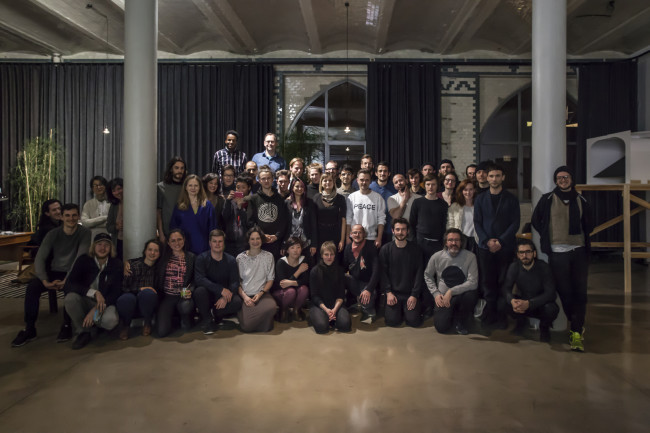
Get-Together
a conversation, an up-date, a check-in, a meeting and reunion, a dinner and a series of short interviews – two years after the Closing Ceremony took place:
eine Gespräch, ein Up-date, ein Check-in, ein Treffen und Wiedersehen, ein Abendessen und eine Reihe von Kurz-Interviews - zwei Jahre nachdem die ifrex Abschlussfeier stattfand:
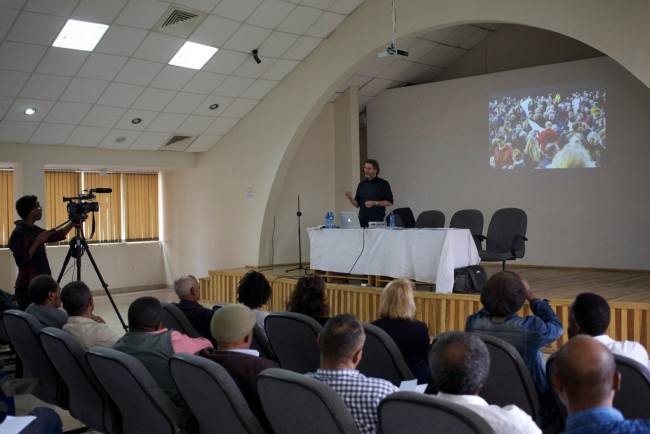
Olafur Eliasson: Vortrag und Buchvorstellung
„Turning Thinking into Doing into Art“: Lecture, project presentation and book launch by Olafur Eliasson
Alle School of Fine Arts and Design, Addis Ababa University
Olafur Eliasson talks about archives and archiving practices as methods and inspiration for artistic and educational practices. He introduces the project Acting Archives – Media Lab for Artistic Research and Education, shows video excerpts from the project archive and presents the technical infrastructure of the media container and the forthcoming accompanying guidebook. He then goes on to present the publication „Olafur Eliasson. Turning Thinking into Doing into Art. Four Lectures in Addis Ababa„, that contains four lectures that Olafur Eliasson delivered in Addis Abeba in 2012 in the context of a collaboration between the Institut für Raumexperimente and the Alle School of Fine Arts and Design in Addis Abeba.
„Turning Thinking into Doing into Art“: Vortrag, Projektpräsentation und Buchvorstellung von Olafur Eliasson
Alle School of Fine Arts and Design, Addis Ababa University
Olafur Eliasson spricht über Archive und archivarische Praxis als Methode und Inspiration für künstlerische und edukative Praxis. Er stellt das Projekt Acting Archives – Medienlabor für künstlerische Forschung und Bildung vor und zeigt filmische Beispiele aus dem Projektarchiv und stellt die technische Ausstattung des Medienkontainer und das zugehörige Handbuch vor. Darüberhinaus präsentiert er die Publikation „Olafur Eliasson. Turning Thinking into Doing into Art. Four Lectures in Addis Ababa„, die vier Vorträge zusammenfasst, die Olafur Eliasson im Rahmen einer Zusammenarbeit des Institutes für Raumexperimente mit der Alle School of Fine Arts and Design in Addis Abeba hielt.
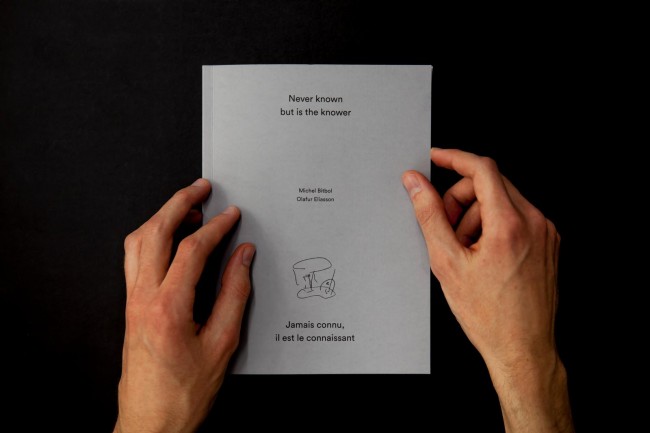
Never Known but Is the Knower / Jamais connu, il est le connaissant
A lecture exploring the blind spot of science, given by Michel Bitbol to open the winter semester 2013/14 at the Institut für Raumexperimente, Berlin University of the Arts, 14 October 2013. Olafur Eliasson created the drawings that appear between the pages while developing his solo exhibition Contact, held at Fondation Louis Vuitton, Paris, 17 December 2014 to 16 February 2015.
Author: Michel Bitbol
Drawings: Olafur Eliasson
Concept: Olafur Eliasson
Designer: Vina Rostomyan / Studio Olafur Eliasson
Text editors: William Stewart / Studio Olafur Eliasson (eng); Anne-Claire Juramie (fr)
Translator: Claire Debard
Publisher: Institut für Raumexperimente, Berlin
Language: English / French
ISBN: 978-3-00-048060-7
Michel Bitbols Vortrag, den er anlässlich der Eröffnung des Wintersemesters 2013/14 am 14. Oktober 2013 am Institut für Raumexperimente hielt, stellt den blinden Fleck der Wissenschaften in den Fokus seiner Betrachtungen. Olafur Eliasson schuf die zugehörigen Zeichnungen, die zwischen den Seiten zu finden sind, während er seine Einzelausstellung „Contact“ in der Fundation Louis Vuitton, Paris vorbereitete, die vom 17. Dezember 2014 bis zum 16. Februar 2015 statt fand.
Autor: Michel Bitbol
Zeichnungen: Olafur Eliasson
Konzept: Olafur Eliasson
Grafikdesign: Vina Rostomyan / Studio Olafur Eliasson
Lektorat: William Stewart / Studio Olafur Eliasson (eng); Anne-Claire Juramie (fr)
Übersetzung: Claire Debard
Herausgeber: Institut für Raumexperimente, Berlin
Sprachen: Englisch / Französisch
ISBN: 978-3-00-048060-7
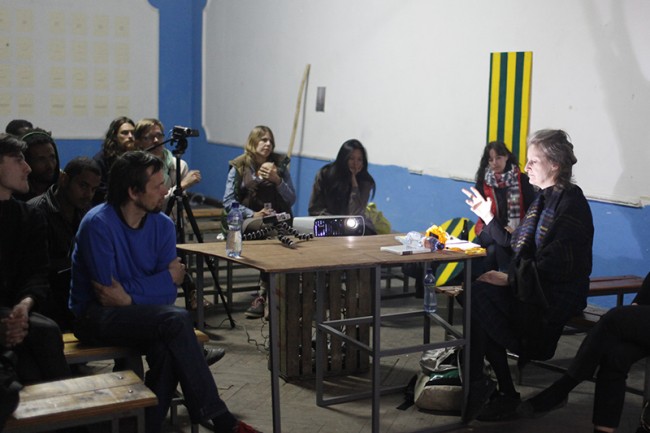
Molly Nesbit: Doubts and Habits of Actions in Time
part I
part II
Molly Nesbit presents a lecture on the project Utopia Station and her recently published The Pragmatism in the History of Art. The book examines the pragmatism of Charles Peirce, William James, and John Dewey, considering pragmatism as essentially a way of working that starts from the present. The book scrutinises the work of Meyer Schapiro, Henri Focillon, Alexander Dorner, George Kubler, Robert Herbert, T. J. Clark, and Linda Nochlin. She discusses the distinctly pragmatic effects found in the philosophy of Michel Foucault and Gilles Deleuze and the films of Chris Marker and Jean-Luc Godard. Artists discussed include Vincent Van Gogh, Isamu Noguchi, Lawrence Weiner and Gordon Matta-Clark.
Synthesis
Utopia Station – Venice · Sustainable Aesthetics · Sustainability – carrying things forward in time · Doing the work of history · Utopia Station: a mind bender · Ausklappen...
Utopia Station – Venice · Sustainable Aesthetics · Sustainability – carrying things forward in time · Doing the work of history · Utopia Station: a mind bender · Education is the moving of minds · Utopia Station could not be seen as a totality · It had many forms of manifestation · Difficult to define and categorise · Art brings some form of knowledge · Education is a process of dawnings · Teaching and art have a delay built into it · Chris Marker · Nicola Bouvier 1953 · The Pragmatists in America · Charles Sander Peirce, John Dewey, etc. · William James · Pragmatism – dense and modern · The pragmatists brought their own catalysts · Peirce produced the first draft of Pragmatism · Nothing new can be learned by analysing definitions · Habits of action · Posing physical problems for logic · Reality as independent of an individual person’s thoughts · How to know? · Dewey · Knowing is viewing from the outside · Art as tool and practice in service of life · Consciousness is not a separate mode of being · Their pragmatism is not our script · History can remain live · History brought through the present via writing
Short biography
Molly Nesbit, chair and professor in the Department of Art at Vassar College and contributing editor of Artforum. Ausklappen...
Molly Nesbit, chair and professor in the Department of Art at Vassar College and contributing editor of Artforum. She is the author of Atget’s Seven Albums (1992), Their Common Sense (2000), and The Pragmatism in the History of Art (2013), the first volume in a collection of her essays. Since 2002, together with Hans Ulrich Obrist and Rirkrit Tiravanija, she has tri-curated Utopia Station, an ongoing book, exhibition, seminar, website, and street project.
Teil I
Teil II
Molly Nesbit stellt das Projekt Utopia Station vor und hält einen Vortrag zu ihrer neuesten Publikation The Pragmatism in the History of Art. Das Buch untersucht den Pragmatismus von Charles Peirce, William James und John Dewey. Hierbei wird der Pragmatismus als eine Arbeitsweise verstanden, die von der Gegenwart ausgeht. Das Buch thematisiert unter anderem die Arbeiten von Meyer Schapiro, Henri Focillon, Alexander Dorner, George Kubler, Robert Herbert, T. J. Clark und Linda Nochlin. Molly Nesbit bespricht die eindeutigen Einflüsse des Pragmatismus auf die Philosophie von Michel Foucault und Gilles Deleuze sowie die Filme Chris Markers und Jean-Luc Godards. Künstler, die sie vorstellt, sind unter anderem Vincent Van Gogh, Isamu Noguchi, Lawrence Weiner und Gordon Matta-Clark.
Synthese
Utopia Station – Venedig · Nachhaltige Ästhetik · Nachhaltigkeit – Dinge in der Zeit voranbringen · Die Arbeit der Geschichte übernehmen · Utopia Station: biegt den Geist · Ausklappen...
Utopia Station – Venedig · Nachhaltige Ästhetik · Nachhaltigkeit – Dinge in der Zeit voranbringen · Die Arbeit der Geschichte übernehmen · Utopia Station: biegt den Geist · Bildung ist die Bewegung des Geistes · Utopia Station konnte nicht als Gesamtheit gesehen werden · Es gab viele Darstellungsformen · Schwierig zu definieren und kategorisieren · Kunst bringt eine Form des Wissens mit sich · Bildung ist eine prozesshafte Abfolge von Erkenntnissen · Lehre und Kunst haben eine intrinsische Verzögerung · Chris Marker · Nicola Bouvier 1953 · Die Pragmatiker in den USA · Charles Sander Peirce, John Dewey · William James · Pragmatism – dicht und modern · Die Pragmatiker brachten ihre eigenen Katalysatoren · Peirce schafft den ersten Entwurf des Pragmatismus · Durch die Analyse von Definition kann nichts neues erkannt werden · Handlungsgewohnheiten · Physische Fragestellungen auf Logik überprüfen · Realität als unabhägig von den Gedanken individueller Personen · Wie kann man wissen? · Dewey · Wissen ist von außen betrachten · Kunst als Werkzeug und Praxis im Dienste des Lebens · Bewusstsein ist keine unabhängige Art des Seins · Ihr Pragmatismus ist nicht unser Fahrplan · Geschichte kann live bleiben · Geschichte wird mittels Schreiben in die Gegenwart gebracht
Kurzbiografie
Molly Nesbit ist Vorsitzende und Professorin der künstlerischen Fakultät am Vassar College und Redakteurin für Artforum. Ausklappen...
Molly Nesbit ist Vorsitzende und Professorin der künstlerischen Fakultät am Vassar College und Redakteurin bei Artforum. Sie ist Autorin von Atget’s Seven Albums (1992), Their Common Sense (2000), und The Pragmatism in the History of Art (2013). Sie kuratierte seit 2002 gemeinsam mit Hans Ulrich Obrist und Rirkrit Tiravanija Utopia Station, ein fortlaufendes Projekt das aus einer Publikation, Seminar, Website und Straßenprojekt besteht.
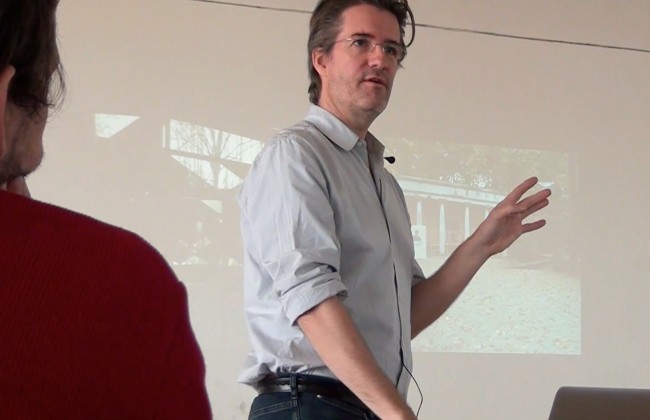
Olafur Eliasson: Fourth Lecture
part I
part II
part III
Olafur Eliasson discusses methods for turning thinking into doing. He reflects on connecting art production with art education and everyday life, the value and importance of microsystems, the proper role of a museum, the function of an art archive, and art’s need for collectivity and diversity. This is the last of four lectures given by the artist in Addis Ababa in the context of an education collaboration between the Institut für Raumexperimente and the Alle School of Fine Arts and Design.
Synthesis
How thinking about thinking can shape things • Making art as a kind of thinking: Umsetzung • From thinking to working to sharing art: one trajectory • A system’s ability to amplify thinking • Thinking as a kind of gathering or micro-parliament • Ausklappen...
How thinking about thinking can shape things • Making art as a kind of thinking: Umsetzung • From thinking to working to sharing art: one trajectory • A system’s ability to amplify thinking • Thinking as a kind of gathering or micro-parliament • Things are not static • Inner sense of responsibility in art education • Linking the art school, the art studio, and the street • Erosion at the 2nd Johannesburg Biennale • Producing meaning retroactively • What microsystems can achieve • Okwui Enwezor’s belief in microsystems as a way to combat the exclusion created by generalisation • Tossing space within a museum in contrast to the solidification celebrated in the museum’s more traditional form • Curating the documentation of an exhibition • The relationship between a museum and a work of art • Curatorial thinking • Hu Fang and Zhang Wei convincing people to live in a museum • Never Tired of Looking at Each Other – Only the Mountain and I • Flipping through a book like building a museum • Confidence in the potential in celebrating and defining a platform • This lecture as an execution of an archive • Louwrien Wijers’ living archive • Book as an archival transmitter • The meaning of shared space and the notion of public • Diversity as an asset in art • Addressing collectivity • Compromises • 121Ethiopia
Short biography
Olafur Eliasson, Danish-Icelandic artist, founded the Institut für Raumexperimente, an educational research project, Ausklappen...
Olafur Eliasson, Danish-Icelandic artist, founded the Institut für Raumexperimente, an educational research project, affiliated with the College of Fine Arts at the Berlin University of the Arts (UdK). The fundamental trajectory of the Institut für Raumexperimente is Eliasson’s interest in testing models of learning and cultivating experimental formats.
Teil I
Teil II
Teil III
Olafur Eliasson diskutiert Methoden, mit denen Denken in praktisches Tun überführt werden kann. Er denkt darüber nach, was es bedeutet, Kunstproduktion mit Kunststudien und dem alltäglichen Leben zu verbinden, dem Wert und der Wichtigkeit von Mikrosystemen, der richtigen Rolle eines Museums, der Funktion eines Kunstarchives und dem Bedürfnis der Kunst nach Kollektivität und Diversität. Der Vortrag ist der letzte von insgesamt vier Vorträgen, die der Künstler im Rahmen einer Zusammenarbeit des Institutes für Raumexperimente mit der Alle School of Fine Arts and Design in Addis Abeba hielt.
Synthese
Wie das Nachdenken über Denken Dinge formen kann • Kunstschaffen als eine Art des Denkens: Umsetzung • Von Denken zu Arbeiten zum Teilen von Kunst: Eine Richtung • Die Fähigkeit eines Systemes, Denken zu verstärken • Ausklappen...
Wie das Nachdenken über Denken Dinge formen kann • Kunstschaffen als eine Art des Denkens: Umsetzung • Von Denken zu Arbeiten zum Teilen von Kunst: Eine Richtung • Die Fähigkeit eines Systemes, Denken zu verstärken • Denken als eine Art des Sammelns oder als Mikroparlament • Dinge sind nicht statisch • Inneres Verantwortungsgefühl in der künstlerischen Bildung • Verbinden der Kunsthochschule, des künstlerischen Studios und der Straße • Erosion bei der 2. Johannesburg Biennale • Retroaktive Bedeutungsproduktion • Was Mikrosysteme erreichen können • Okwui Enwezors Glaube an Mikrosysteme als einem Weg zur Bekämpfung der ausschließenden Wirkung von Generalisierung • Den Raum im Museum durcheinanderwürfeln im Gegensatz zum erstarrten Raum in traditionellen musealen Formen • Kuratieren der Dokumentation einer Ausstellung • Die Beziehung zwischen einem Museum und einem Kunstwerk • Kuratorisches Denken • Hu Fang und Zhang Wei, die Menschen überzeugen in einem Museum zu leben • Never Tired of Looking at Each Other – Only the Mountain and I • Ein Buch so durchblättern als wenn man ein Museum baut • Vertrauen in das Potential darin, eine Plattform zu loben und zu definieren • Diese Vorlesung als Ausführung eines Archivs • Louwrien Wijers lebendiges Archiv • Bücher als Boten des Archivs • Die Bedeutung von geteiltem Raum und das Verständnis von Öffentlichkeit • Vielfältigkeit als Plus in der Kunst • Kollektivität ansprechen • Kompromisse • 121Ethiopia
Kurzbiografie
Olafur Eliasson, dänisch-isländischer Künstler, gründete das Institut für Raumexperimente, ein Studien- und Forschungsprojekt, Ausklappen...
Olafur Eliasson, dänisch-isländischer Künstler, gründete das Institut für Raumexperimente, ein Studien- und Forschungsprojekt, das Teil der Fakultät für Bildende Kunst an der Universität der Künste Berlin (UdK) ist. Eliassons Interesse, neue Lernmodelle zu testen und experimentelle Formate zu kultivieren, ist grundlegender Bestandteil des Institutsprogramms.
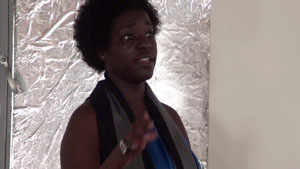
Elvira Dyangani Ose: Collective Art Practices
part I
part II
part III
Elvira Dyangani Ose presents a series of works by African artists as a basis for a discussion with a group of students from Addis Ababa and Berlin. Several questions and issues are raised in relation to curatorial practices such as how an artist’s biography influences the collection of his or her work; the building of public space; the role of art in society; ‘African-ness’; Jürgen Habermas’s concept of public space; the use of public space by artists; the breakdown between centre and periphery in the art world; the politics of labelling world art in order to make it collectible; and the Western artist as opposed to the non-Western artist.
Synthesis
Question of identity · Post-colonialism · Growing up in Spain and studying art history · How artists deal with public space · How artists use their own biography to deal with public space · Ausklappen...
Question of identity · Post-colonialism · Growing up in Spain and studying art history · How artists deal with public space · How artists use their own biography to deal with public space · What influences the collectability of art? · The influence of history and theory of architecture on Dyangani Ose’s curatorial career · Collective-ness is a central issue today · What is the role of the artist in society? · Do African artists present a notion of ‘African-ness’? · Researching African art · Dyangani Ose’s work with Tate Modern and her focus on African art · Can artists claim the public sphere as theirs? · Artist collectives around Africa · Cultural platforms that show what is happening in different African cities · Using borrowed spaces to show artists’ work · Using the public space to blur the boundaries between artist and viewer · Interdisciplinary approach to art production · Political awareness through art · First Festival of Black Art in Dakar 1966 · Initial cultural policy for African art · Raising the question of how to understand “African art” · Defining differences between how Africans see their own art in relation to how the West sees it · New internationalism · The breakdown between centre and periphery · A single mega show cannot fully represent what Africa is · Important to look at specific contexts · Who can judge “African-ness”?
Short biography
Elvira Dyangani Ose is a Lecturer in Visual Cultures at Goldsmiths, University of London, and curator of the eighth Göteborg International Biennial for Contemporary Art, GIBCA 2015. Ausklappen...
Elvira Dyangani Ose is a Lecturer in Visual Cultures at Goldsmiths, University of London, and curator of the eighth Göteborg International Biennial for Contemporary Art, GIBCA 2015. From 2011 to 2014, she served as Curator of International Art at Tate Modern. Prior to her work at Tate, she was curator from 2004 to 2006 at the Centro Atlántico de Arte Moderno (CAAM), Las Palmas la Gran Canaria, Spain, and from 2006 to 2008 at the Centro Andaluz de Arte Contemporáneo (CAAC), Seville. At the CAAM, she curated works by, among others, Nicholas Hlobo, Tracey Rose, Moshekwa Langa, Zanele Muholi, and Mikhael Sutbozky. She has curated the retrospective exhibition Carrie Mae Weems: Social Studies at CAAC (2010) and the interdisciplinary project Attempt to Exhaust an African Place at Centre d’Art Santa Mònica, Barcelona (2007–2008). She was also guest curator of the triennial SUD – Salon Urbain de Douala, Douala, Cameroon (2010), and the Artistic Director of the third Rencontres Picha: Lubumbashi Biennial, Democratic Republic of Congo (2013). Dyangani Ose has published and lectured on modern and contemporary African art and has contributed to art journals such as NKA and Atlántica.
Teil I
Teil II
Teil III
Elvira Dyangani Ose präsentiert eine Reihe von Arbeiten afrikanischer Künstler, die als Diskussionsgrundlage für die Gruppe der Studierenden der Alle School of Fine Arts and Design und des Instituts für Raumexperimente dienen. Es werden Fragen in Bezug auf kuratorische Praktiken gestellt, so etwa: Welchen Einfluss hat die Biographie eines Künstlers darauf, ob seine Werke gesammelt werden? Welchen Einfluss hat das Labeln von internationaler Kunst, um diese sammelbar zu machen? Desweiteren werden Fragen zum Entstehen öffentlichen Raums und der Rolle von Kunst in der Gesellschaft gestellt. Fragen, die ebenfalls diskutiert werden, lauten: Existiert Jürgen Habermas Konzept vom öffentlichen Raum? Wie nutzen Künstler öffentlichen Raum? Gibt es Afrikanizität? Gibt es Entkopplung von Zentrum und Peripherie in der Kunstwelt? Was ist ein westlicher, beziehungsweise nicht-westlicher Künstler?
Synthese
Identitätsfragen · Postkolonialismus · In Spanien aufwachsen, hat Kunstgeschichte studiert · Wie gehen Künstler mit öffentlichem Raum um? · Arten, auf die Künstler ihre eigenen Biographie in Interaktion mit öffentlichem Raum nutzen · Ausklappen...
Identitätsfragen · Postkolonialismus · In Spanien aufwachsen · Hat Kunstgeschichte studiert · Wie gehen Künstler mit öffentlichem Raum um? · Arten, auf die Künstler ihre eigenen Biographie in Interaktion mit öffentlichem Raum nutzen · Was beeinflusst die Sammelbarkeit von Kunst? · Geschichte und Architekturtheorie beeinflussen ihre kuratorische Laufbahn · Kollektivität ist heute ein zentrales Thema · Was ist die Rolle des Künstlers in der Gesellschaft? · Repräsentieren afrikanische Künstler eine Form von Afrikanizität? · Recherche zu afrikanischer Kunst · Beginnt bei Tate Modern zu afrikanischer Kunst zu arbeiten · Können Künstler öffentlichen Raum für sich beanspruchen? · Künstlerkollektive in Afrika · Kulturelle Plattformen, die zeigen was in afrikanischen Städten passiert · Geliehene Orte zur Ausstellung von Kunstwerken · Nutzung des öffentlichen Raums um die Grenzen zwischen Künstlern und Publikum zu verwischen · Interdisziplinärer Ansatz in Sachen Kunstproduktion · Politisches Bewusstsein durch Kunst · First Festival of Black Art in Dakar 1966 · Erste Kulturpolitik für afrikanische Kunst · Frage danach wie „afrikanische Kunst“ verstanden werden kann · Differenzen zwischen dem Verständnis von afrikanischer Kunst durch Afrikaner im Gegensatz zum Westen definieren · Neuer Internationalismus · Zusammenbruch der Trennung zwischen Zentrum und Peripherie · Eine einzige große Ausstellung kann nicht zeigen was afrikanische Kunst ist · Es ist wichtig spezifische Zusammenhänge zu betrachten · Wer legt fest was „afrikanisch“ bedeutet ?
Kurzbiografie
Elvira Dyangani Ose ist Lehrende für visuelle Kultur am Goldsmiths College der University of London und Kuratorin der achten Ausgabe der Göteborg International Biennial for Contemporary Art, GIBCA 2015. Ausklappen...
Elvira Dyangani Ose ist Lehrende für visuelle Kultur am Goldsmiths College der University of London und Kuratorin der achten Ausgabe der Göteborg International Biennial for Contemporary Art, GIBCA 2015. Sie war von 2011 bis 2014 Kuratorin für Internationale Kunst an der Tate Modern. Zuvor war sie Kuratorin des Centro Atlántico de Arte Moderno (2004 – 2006) und am Centro Andaluz de Arte Contemporáneo (2006 – 2008). Am CAAM kuratierte sie die wegweisende Ausstellung Olvida Quien Soy / Erase Me From Who I Am (2006) und zeigte hier unter anderem Werke von Nicholas Hlobo, Tracey Rose, Moshekwa Langa, Zanele Muholi und Mikhael Sutbozky. Sie kuratierte die retrospektive Ausstellung Carrie Mae Weems: Social Studies (2010) und das interdisziplinäre Projekt Attempt to Exhaust an African Place (2007–2008). Sie war außerdem Kuratorin von Arte Invisible (2009–2010), Gastkuratorin der Triennale SUD-Salon Urbain de Douala (2010) und künstlerische Leiterin der dritten Ausgabe von Rencontres Picha: Lubumbashi Biennial (2013), Demokratische Republik Kongo. Dyangani Ose publiziert zu moderner und zeitgenössischer afrikanischer Kunst, hält Vorträge und verfasst regelmäßig Beiträge für Kunstmagazine wie NKA und Atlántica.
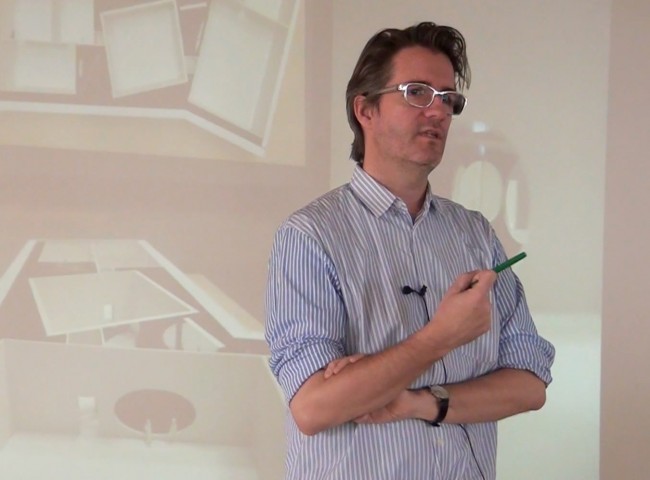
Olafur Eliasson: Third Lecture
Teil I
Teil II
Teil III
Olafur Eliasson continues his discussion of the challenges confronting contemporary artists, framed in a retrospective on his career so far. Eliasson speaks of the power and effect of environments, the way those environments are constructed and conditioned, and the need to understand one’s environment as a subjective and negotiable event. This is the third of four lectures given by the artist in Addis Ababa in the context of an education collaboration between the Institut für Raumexperimente and the Alle School of Fine Arts and Design.
Synthesis
Marathon: compilation of independent things that still overlap • Getting into the flow • Navigation is the artists’ challenge • The effect of context on a work of art • Belief • Ausklappen...
Marathon: compilation of independent things that still overlap • Getting into the flow • Navigation is the artists’ challenge • The effect of context on a work of art • Belief • Passion • Noticing emotions reminds us that we are not alone • Unconscious mirroring of emotional environments • Confidence • Glass creating an inside and an outside • Glass as highly alienating and excluding • Looking through walls • Borrowed views in Chinese gardens • Lalibela void • Artists’ ability to see an ‘invisible’ space • Omgivelser, an exhibition in-between walls • Separating artworks from consumer goods • A space where our subconscious can be explored • Your house • The notion of negative spaces as positive spaces • Being so busy making sense of what we see that we don’t see most of what’s out there • Simulating various light conditions to re-exercise our vision • The influence of lighting on our perception of colour • The historical conditioning of white • Associating white with purity: the use of lime in hospitals and the whitewashing of Protestant churches during the Reformation • Experimental set-ups with light: Your relativity of white, The light setup • Room for one colour • Broadening one’s point of view • The feeling that we are not the centre of the universe • Light is not without context • Light as a discursive practice • How a work of art evolves in the world • Art and artists as part of and bound up with an often invisible system
Short biography
Olafur Eliasson, Danish-Icelandic artist, founded the Institut für Raumexperimente, an educational research project, Ausklappen...
Olafur Eliasson, Danish-Icelandic artist, founded the Institut für Raumexperimente, an educational research project, affiliated with the College of Fine Arts at the Berlin University of the Arts (UdK). The fundamental trajectory of the Institut für Raumexperimente is Eliasson’s interest in testing models of learning and cultivating experimental formats.
part I
part II
part III
Olafur Eliasson führt seine Überlegungen zu den Herausforderungen vor denen zeitgenössische Künstler stehen weiter aus. Er setzt dies in Bezug zu einer Retrospektive seiner bisheriger Arbeiten. Eliasson spricht über die Kraft und den Einfluss, die unsere Umwelt auf uns hat, die Art auf die diese Umgebungen konstruiert und konditioniert sind und das Bedürfnis die eigene Umgebung als subjektives und verhandelbares Ereignis zu verstehen. Der Vortrag ist der dritte von insgesamt vier Vorträgen, die der Künstler im Rahmen einer Zusammenarbeit des Institutes für Raumexperimente mit der Alle School of Fine Arts and Design in Addis Abeba hielt.
Synthese
Marathon: Zusammenstellung unabhängiger Dinge, die immer noch Schnittpunkte haben • In den Flow kommen • Navigation ist die Herausforderung des Künstlers • Der Effekt von Kontext auf ein Kunstwerk • Glaube • Ausklappen...
Marathon: Zusammenstellung unabhängiger Dinge die immer noch Schnittpunkte haben • In den Flow kommen • Navigation ist die Herausforderung des Künstlers • Der Effekt von Kontext auf ein Kunstwerk • Glaube • Leidenschaft • Gefühle zu bemerken erinnert uns daran, dass wir nicht allein sind • Unbewusstes spiegeln von emotionalen Umgebungen • Zutrauen • Glas, das ein Innen und ein Außen schafft • Glas als zutiefst entfremdend und ausschließend • Durch Wände sehen • "borrowed view" in chinesischen Gärten • Lalibela void • Die Fähigkeit des Künstlers, einen ‘unsichtbaren’ Ort zu sehen • Omgivelser, eine Ausstellung zwischen Wänden • Kunstwerke von Konsumgütern trennen • Ein Ort, an dem unser Unterbewusstes erforscht werden kann • Your house • Das Verständnis von negativen Räumen als positiven Räumen • So beschäftigt damit sein, den Dingen die wir sehen einen Sinn zu geben, dass wir das meiste gar nicht sehen • Simulation verschiedener Lichtverhältnisse um unser Sehen neu zu trainieren • Der Einfluss von Beleuchtung auf unsere Farbsicht • Die historische Konditionierung von Weiß • Assoziation von Weiß mit Reinheit: Der Gebrauch von Kalk in Krankenhäusern und das Weißen evangelischer Kirchen während der Reformation • Experimentelle Aufbauten mit Licht: Your relativity of white, The light setup • Room for one colour • Erweiterung des eigenen Blickwinkels • Das Gefühl, dass wir nicht das Zentrum des Universums sind • Licht ist nicht ohne Kontext • Licht als diskursive Praxis • Wie sich ein Kunstwerk in der Welt entwickelt • Kunst und Künstler als Teil eines oft unsichtbaren Systems, in dem sie verstrickt sind
Kurzbiografie
Olafur Eliasson, dänisch-isländischer Künstler, gründete das Institut für Raumexperimente, ein Studien- und Forschungsprojekt, Ausklappen...
Olafur Eliasson, dänisch-isländischer Künstler, gründete das Institut für Raumexperimente, ein Studien- und Forschungsprojekt, das Teil der Fakultät für Bildende Kunst an der Universität der Künste Berlin (UdK) ist. Eliassons Interesse, neue Lernmodelle zu testen und experimentelle Formate zu kultivieren, ist grundlegender Bestandteil des Institutsprogramms.
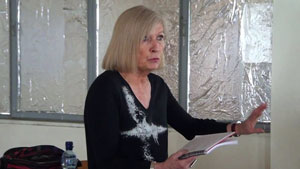
Chantal Mouffe: Agonistic Spaces
part I
part II
Chantal Mouffe presents a lecture on the basic tenets of her theory of politics and how artistic practices can intervene in political processes. She first lays the philosophical ground for her lecture: the critique of Essentialism and an introduction to a discursive approach, touching on the work of Freud, Lacan, Wittgenstein, and Gadamer. Secondly, she introduces and discusses her theory of an agonistic model of democracy. In this framework, she explores the role of artistic practice within the political process and its ability to intervene and help change established hegemonies through antagonistic positioning.
Synthesis
Where can artistic practice intervene? · Some philosophical concepts that are important to have as a basis · Sigmund Freud · The subject is a given, an idea questioned by critical essentialism · The concept of the divided subject between the conscious and the unconscious · Psychoanalysis can help to reach the unconscious but can never master it · Ludwig Wittgenstein – the subject cannot be the source of linguistic meaning · Ausklappen...
Where can artistic practice intervene? · Some philosophical concepts that are important to have as a basis · Sigmund Freud · The subject is a given, an idea questioned by critical essentialism · The concept of the divided subject between the conscious and the unconscious · Psychoanalysis can help to reach the unconscious but can never master it · Ludwig Wittgenstein – the subject cannot be the source of linguistic meaning · It is by participating in a variety of practices that the world is revealed to us · Hans-Georg Gadamer · It is by participating in languages that the world is disclosed to us · Pragmatism · There is no identity already there · Identity is constructed · Jacques Lacan · The subject is like an onion, constructed by layers of identification · The discursive approach – reality is always constructed through various discourses or signifying practices · Reality is only a product of discourse · Discourse is an articulation between linguistic things and material things · The object is always given to us by discursive articulation · The meaning of things is always constructed through a system of relations · Kicking a ball only becomes playing football when it is within a particular system of relations · Antonio Gramsci · The category of hegemony · A system of relations is always a system of power · There is no society without power · The structures can be changed but not eliminated · Every type of order is an hegemonic structure · Counter-hegemonic practices offer alternatives · There is always an alternative to the existing order · That is where artistic practices can act · Two main concepts – hegemony and antagonism · The aim of democracy is to establish a rational consensus · This is impossible, because if every order is hegemonic then there can be no reconciliation, only alternatives through antagonism · What are the consequences of this approach to democracy? · The task for political institutions is to aggregate interests and establish consensus · The pursuit of self-interest · Rational choice · John Rawls · Jürgen Habermas · To act as a citizen is to act towards the common good · Must differentiate between instrumental and communicative rationality · The role of passion in creating a collective form of identification · Affect is not irrational · We can accept a democratic model that encompasses antagonism · Democratic institutions within this model do not seek a rational consensus · Antagonism is a very specific form of conflict, one which can never reach a consensus · Antagonism in this democratic model can exist as a conflict between adversaries instead of enemies · They accept the legitimacy of their opponents · Not with the aim of destroying the other · The democratic process is accepted within the agonistic model · The opponent is treated as an equal · A process of persuasion to win over the opponent · There are competing views of the common good · Different agonistic spaces allow for different types of individualities to exist · The hegemonic model is particularly good to understand the relation between art and politics · Gramsci posited that hegemonies are created through civil society · Through a multiplicity of practices · The importance of culture in the creation and reproduction of the common sense · Our subjectivity is dependent on the types of practices in which we participate · Art and politics not separate from each other · They either contribute to the existent hegemony or they critique it · How can artistic practices have a critical position within traditional institutions today?
Short biography
Chantal Mouffe, political theorist educated at the universities of Louvain, Paris, and Essex, is professor of political theory at the University of Westminster. Ausklappen...
Chantal Mouffe, political theorist educated at the universities of Louvain, Paris, and Essex, is professor of political theory at the University of Westminster. She has taught at many universities in Europe, North America, and Latin America and has held research positions at Harvard, Cornell, the University of California, the Institute for Advanced Study in Princeton, and the Centre National de la Recherche Scientifique in Paris. Between 1989 and 1995, she was Directrice de Programme at the College International de Philosophie in Paris. Professor Mouffe is module leader of the CSD MA modules The State, Politics and Violence and Current Issues in Democratic Theory at the University of Westminster.
Teil I
Teil II
Chantal Mouffe hält einen Vortrag über die Grundlagen ihrer politischen Theorie und darüber wie künstlerische Praktiken in politische Prozesse eingreifen können. Zuerst legt sie die philosophische Grundlage für ihren Vortrag: Eine Kritik des Essentialismus und eine Einführung in die diskursive Theorie mit Erwähnung der Werke von Freud, Lacan, Wittgenstein und Gadamer. Danach führt sie in ihre Theorie eines agonistischen Demokratiemodells ein und diskutiert diese. Sie hinterfragt die Rolle künstlerischer Praxis innerhalb von politischen Prozessen und deren Fähigkeit einzugreifen und zur Veränderung von etablierten Herrschaftssystemen durch antagonistische Positionierung beizutragen.
Synthese
Wo kann künstlerische Praxis eingreifen? · Einige philosophische Konzepte die als Basis wichtig sind · Sigmund Freud · Dass das Subjekt gegeben ist wird vom kritischen Essentialismus in Frage gestellt · Konzept des geteilten Subjektes zwischen Bewusstsein und Unbewusstsein · Psychoanalyse kann helfen das Unbewusste zu erreichen, es aber nie beherrschen · Ludwig Wittgenstein – Das Subjekt kann keine Quelle linguistischer Bedeutung sein · Ausklappen...
Wo kann künstlerische Praxis eingreifen? · Einige philosophische Konzepte die als Basis wichtig sind · Sigmund Freud · Dass das Subjekt gegeben ist wird vom kritischen Essentialismus in Frage gestellt · Konzept des geteilten Subjektes zwischen Bewusstsein und Unbewusstsein · Psychoanalyse kann helfen das Unbewusste zu erreichen, es aber nie beherrschen · Ludwig Wittgenstein – Das Subjekt kann keine Quelle linguistischer Bedeutung sein · Die Welt erschließt sich uns durch die Teilnahme an einer Vielzahl von Praktiken · Hans-Georg Gadamer · Durch Sprache eröffnet sich uns die Welt · Pragmatismus · Es gibt keine Identität von vornherein · Identität ist konstruiert · Jacques Lacan · Das Subjekt gleicht einer Zwiebel · Das Subjekt setzt sich aus Identifikationslagen zusammen · Der diskursive Ansatz – Realität wird durch verschiedene Diskurse oder bedeutungssetzende Praktiken geschaffen · Realität ist lediglich ein Produkt von Diskursen · Diskurs ist eine Artikulation zwischen linguistischen Dingen und materiellen Dingen · Das Objekt erhalten wir immer durch diskursive Artikulation · Die Bedeutung von Dingen wird immer durch ein Beziehungssystem geschaffen · Einen Ball zu treten wird erst dann zum Fußball spielen wenn es Teil eines besonderen Beziehungssystems ist · Chantal Mouffes Ansatz · Antonio Gramsci · Hegemonie als Kategorie · Soziale Beziehungen werden immer durch Artikulation, durch Beziehungen geschaffen · Dieses Beziehungssystem ist immer ein Machtsystem · Es gibt keine Gesellschaft ohne Macht · Strukturen können geändert werden, aber nicht ausgelöscht · Jede Art von Ordnung ist eine hegemonische Ordnung · Gegenhegemonische Praktiken bieten eine Alternative · Es gibt immer eine Alternative zur bestehenden Ordnung · Dort können künstlerische Praktiken agieren · Zwei Hauptkonzepte – Hegemonie und Antagonismus · Ziel der Demokratie ist die Etablierung eines rationale Konsens · Das ist unmöglich denn wenn jede Ordnung eine Hegemonie ist kann es keine Übereinstimmung geben, nur Alternativen durch Antagonismus · Was sind die Konsequenzen aus diesem Demokratieverständnis? · Die Aufgabe für politische Institutionen ist es Interessen anzusammeln und einen Konsens zu etablieren · Das Verfolgen eines Eigennutzes · Rationale Entscheidung · John Rawls · Jürgen Habermas · Als Bürger zu handeln bedeutet für das Gemeinwohl zu handeln · Es muss zwischen rein funktionaler und kommunikativer Rationalität unterschieden werden · Die Rolle von Leidenschaft bei der Erschaffung einer kollektiven Identifikationsform · Affektive Dimension · Affekt ist nicht irrational · Wir können ein demokratisches Modell das Antagonismen einschließt akzeptieren · Demokratische Institutionen innerhalb dieses Modells suchen nicht nach einem rationalen Konsens · Die Rolle von demokratischen Institutionen ist demnach sich zu etablieren um so Antagonismen zulassen zu können ohne dabei die demokratische Ordnung zu zerstören · Antagonismus ist eine sehr spezifische Form des Konflikts, die nie einen Konsens erreichen kann · In diesem demokratischen Modell kann Antagonismus als Konflikt zwischen Gegenspielern statt Feinden bestehen · Eine antagonistische Beziehung ist die Art von Konflikt die zwischen Gegenspielern besteht · Sie akzeptieren die Legetimität ihres Gegenüber · Ohne das Ziel den anderen zu zerstören · Der demokratische Prozess wird im agonistischen Modell akzeptiert · Im liberalen Modell ist der Gegenspieler ein Konkurrent · Der Gegenüber wird als gleichwertig behandelt · Ein Überzeugungsprozess um über den Gegenspieler zu siegen · Es gibt Ansichten über das Allgemeinwohl, die miteinander im Wettstreit stehen · Unterschiedliche antagonistische Räume ermöglichen die Existenz unterschiedlicher Arten von Individualitäten · Das hegemonistische Modell ist besonders gut um die Beziehung zwischen Kunst und Politik zu verstehen · Gramsci postulierte, dass Hegemonien durch die Zivilgesellschaft geschaffen werden · Durch eine Vielzahl an Praktiken · Die Wichtigkeit von Kultur für die Schaffung und Reproduktion gesunden Menschenverstandes · Unsere Subjektivität hängt von den Praktiken an denen wir teilhaben ab · Kunst und Politik sind nicht voneinander getrennt · Sie tragen entweder zur bestehenden Hegemonie bei oder kritisieren sie · Wie kann künstlerische Praxis innerhalb traditioneller Institutionen heute eine kritische Position haben?
Kurzbiografie
Chantal Mouffe, Politikwissenschaftlerin mit Ausbildung an den Universitäten Louvain, Paris und Essex ist Professorin für politische Theorie an der University of Westminster. Ausklappen...
Chantal Mouffe, Politikwissenschaftlerin mit Ausbildung an den Universitäten Louvain, Paris und Essex. Sie ist Professorin für politische Theorie und Modulleiterin des CSD MA Moduls ‘The State, Politics and Violence and Current Issues in Democracy Theory’ an der University of Westminster. Sie lehrte an zahlreichen Universitäten in Europa, Nordamerika und Lateinamerika und hatte Forschungspositionen in Harvard, Cornell, der University of California, dem Institute for Advanced Studies in Princeton und am Centre National de la Recherche Scientifique in Paris inne. Zwischen 1989 und 1995 war sie Programmdirektorin des College International de Philosophie in Paris.
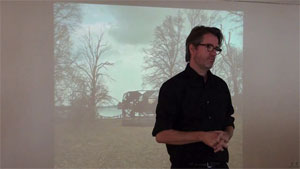
Olafur Eliasson: Second Lecture
part I
part II
part III
Olafur Eliasson discusses the role of light and colour in his work as a starting point for phenomenological investigations. The lecture explores questions of authorship, the artist’s position within a network, and the potential to reach out and encounter other groups and people through an artwork. This is the second of four lectures given by the artist in Addis Ababa in the context of an education collaboration between the Institut für Raumexperimente and the Alle School of Fine Arts and Design.
Synthesis
Life and energy • Collective experience of watching a film • Light pollution and the experience of stars from earth • The incomprehensibility of scale • Ausklappen...
Life and energy • Collective experience of watching a film • Light pollution and the experience of stars from earth • The incomprehensibility of scale • The impact of human activity • Energy inherent in colour • The role of colour and pigment in the evolutionary development of cyanobacteria • Painting: light, colour, and evolution • Experiment with colour and light: after-image film • Your uncertainty of colour matching experiment • Fundamental co-production of art • Reality not only about evaluating what we see, but also how we see it • The variety of depiction, detection, and perception of colour across language and culture • Goethe’s colour theory • Sight and the world • Gaining and losing confidence through the experience of an artwork • The mediated motion • Encountering others within an artwork • Who is the author in an artwork? • Removing the artist from the artwork • Using glaciers to create a physical relation with the environment • Creating an explicit understanding of temporality • Dynamics and vulnerability of a landscape • Destabilising what we think of as solid • Literal and figurative blindness • Denmark’s political exclusivity and The blind pavilion • Obsidian, black mirrors, and our ability to see ourselves within a context • Disconnection of the artist from the artwork • The artist is responsible for everything • Bruno Latour’s interobjectivity • Compassion and empathy • Artists’ responsibility and the spectators’ share in it
Short biography
Olafur Eliasson, Danish-Icelandic artist, founded the Institut für Raumexperimente, an educational research project, Ausklappen...
Olafur Eliasson, Danish-Icelandic artist, founded the Institut für Raumexperimente, an educational research project, affiliated with the College of Fine Arts at the Berlin University of the Arts (UdK). The fundamental trajectory of the Institut für Raumexperimente is Eliasson’s interest in testing models of learning and cultivating experimental formats.
Teil I
Teil II
Teil III
Olafur Eliasson spricht über die Rolle von Licht und Farbe in seinem Werk als Ausgangspunkte für phänomenologische Forschung. Der Vortrag berührt Fragen von Autorschaft, der Position des Künstlers innerhalb von Netzwerken und dem Potential, die Hand auszustrecken und andere Gruppen und Menschen durch ein Kunstwerk zu berühren. Der Vortrag ist der zweite von insgesamt vier Vorträgen, die der Künstler im Rahmen einer Zusammenarbeit des Institutes für Raumexperimente mit der Alle School of Fine Arts and Design in Addis Abeba hielt.
Synthesis
Leben und Energie • Kollektive Erfahrung einen Film zu sehen • Lichtverschmutzung und das Erleben der Sterne von der Erde aus • Ausklappen...
Leben und Energie • Kollektive Erfahrung einen Film zu sehen • Lichtverschmutzung und das Erleben der Sterne von der Erde aus • Die Unverständlichkeit von Größenordnungen • Der Einfluss menschlicher Aktivität • Energie die in Farbe steckt • Die Rolle von Farbe und Pigment in der evolutionären Entwicklung von Cyanobakterien • Malerei: Licht, Farbe und Evolution • Experiment mit Farbe und Licht: Nachbild-Film • Your uncertainty of colour matching experiment • Fundamentale Koproduktion von Kunst • In der Realität geht es nicht nur darum einzuschätzen was wir sehen sondern auch wie wir es sehen • Die unterschiedliche Abbildung, Erkennung und Wahrnehmung von Farbe in Sprachen und Kulturen • Goethes Farblehre • Sehen und die Welt • Gewinn und Verlust von Selbstvertrauen durch das Erfahren eines Kunstwerkes • The mediated motion • Andere in einem Kunstwerk treffen • Wer ist im Kunstwerk der Autor? • Den Künstler aus dem Kunstwerk entfernen • Mit Gletschern eine physische Beziehung zur Umgebung herstellen • Ein konkretes Verständnis von Zeitlichkeit schaffen • Dynamik und Verletzlichkeit einer Landschaft • Destabilisierung dessen, was wir als fest ansehen • Wörtliche und figurative Blindheit • Dänemarks politische Exklusivität und The blind pavilion • Obsidian, schwarze Spiegel und unsere Fähigkeit uns selbst in einem Zusammenhang zu sehen • Trennung des Künstlers vom Kunstwerk • Der Künstler ist für alles verantwortlich • Bruno Latour’s Interobjektivität • Mitgefühl und Empathie • Die Verantwortung des Künstlers und der Anteil des Betrachters daran
Kurzbiografie
Olafur Eliasson, dänisch-isländischer Künstler, gründete das Institut für Raumexperimente, ein Studien- und Forschungsprojekt, Ausklappen...
Olafur Eliasson, dänisch-isländischer Künstler, gründete das Institut für Raumexperimente, ein Studien- und Forschungsprojekt, das Teil der Fakultät für Bildende Kunst an der Universität der Künste Berlin (UdK) ist. Eliassons Interesse, neue Lernmodelle zu testen und experimentelle Formate zu kultivieren, ist grundlegender Bestandteil des Institutsprogramms.
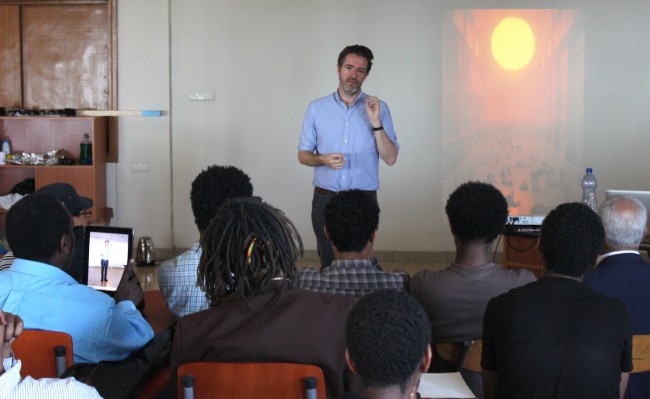
Olafur Eliasson: First Lecture
part I
part II
part III
Olafur Eliasson discusses the potential of art education, the importance of connectivity and engagement for art, and art’s responsibility to social involvement. This is the first of four lectures given by the artist in Addis Ababa in the context of an education collaboration between the Institut für Raumexperimente and the Alle School of Fine Arts and Design.
Synthesis
Reconsidering what a school has the potential to be • The idea of a journey, a trajectory, a progression, and their relation to an art school • Ausklappen...
Founder Director of the Institut für Raumexperimente in Berlin • Reconsidering what a school has the potential to be • The idea of a journey, a trajectory, a progression, and their relation to an art school • The need to focus on what is done without becoming obsessed with explanations • Traditional ‘stages of art production’ and how the institute has attempted to circumvent them • ProCoKnow Parliament and artwork production, communication, and knowledge • Artwork is relative to its engagement with the world • Artwork begins with the first feeling • The importance of having the school in Studio Olafur Eliasson and travelling with the school • Connectivity and art • Embodied and felt knowledge • The weather project • The value of collective experience • The ability to see oneself in a context is related to our ability to see oneself from the outside • Models and the relativity of reality • Model room • Your rainbow panorama • Body-artwork and body-environment relationship • Physical knowledge versus mediated knowledge • Erosion • Interventions and changing urban spaces • Artists’ responsibility for involvement and engagement • Movement and surroundings • Demystifying art for politics • Engaging critically with the art market • Double sunset and doing the impossible • Studio-school-museum interaction • Tickling experiment • Institut für Raumexperimente: vibration, connectivity, intersubjectivity • Little Sun and global shared needs
Short biography
Olafur Eliasson, Danish-Icelandic artist, founded the Institut für Raumexperimente, an educational research project, Ausklappen...
Olafur Eliasson, Danish-Icelandic artist, founded the Institut für Raumexperimente, an educational research project, affiliated with the College of Fine Arts at the Berlin University of the Arts (UdK). The fundamental trajectory of the Institut für Raumexperimente is Eliasson’s interest in testing models of learning and cultivating experimental formats.
Teil I
Teil II
Teil III
Olafur Eliasson spricht über das Potential künstlerischer Bildung, die Wichtigkeit von Verbundenheit und Engagement für Kunst sowie die Veranwortung der Kunst, sich sozial einzubringen. Der Vortrag ist der erste von insgesamt vier Vorträgen, die der Künstler im Rahmen einer Zusammenarbeit des Institutes für Raumexperimente mit der Alle School of Fine Arts and Design in Addis Abeba hielt.
Synthese
Überdenken, welches Potential in einer Schule steckt; was sie sein kann • Die Vorstellung einer Reise, einer Kurve, einer Entwicklung und deren Beziehung zur Kunsthochschule • Ausklappen...
Gründer und Leiter des Institut für Raumexperimente in Berlin • Überdenken, welches Potential in einer Schule steckt; was sie sein kann • Die Vorstellung einer Reise, einer Kurve, einer Entwicklung und deren Beziehung zur Kunsthochschule • Die Notwendigkeit, sich auf das zu konzentrieren was getan wird ohne besessen von Erklärungen zu werden • Traditionelle Bühnen der Kunstproduktion und wie das Institut versucht hat, diese zu umgehen • ProCoKnow Parliament und Kunstproduktion, Kommunikation und Wissen • Das Kunstwerk steht in Relation zu seinem Engagement in der Welt • Das Kunstwerk beginnt mit einem ersten Gefühl • Die Wichtigkeit, die Schule im Studio Olafur Eliasson zu haben und mit ihr reisen zu können • Vernetzbarkeit und Kunst • Verkörpertes und empfundenes Wissen • The weather project • Der Wert einer kollektiven Erfahrung • Die Fähigkeit, uns in einem Kontext zu sehen ist abhängig von unserer Fähigkeit, uns von außen zu betrachten • Modelle und die Relativität der Realität • Model room • Your rainbow panorama • Körper-Kunstwerk und Körper-Umgebung Beziehungen • Physisches Wissen versus vermitteltes Wissen • Erosion • Erfindungen und sich verändernde urbane Räume • Die Verantwortung von Künstlern für Engagement und Einmischung • Bewegung und Umgebung • Kunst für die Politik entmystifizieren • Kritische Auseinandersetzung mit dem Kunstmarkt • Your new bike • Double sunset und das Unmögliche tun • Interaktionen zwischen Studio, Schule und Museum • Kitzelexperiment • Institut für Raumexperimente: Vibration, Konnektivität, Intersubjektivität • Little Sun und global geteilte Bedürfnisse
Kurzbiografie
Olafur Eliasson, dänisch-isländischer Künstler, gründete das Institut für Raumexperimente, ein Studien- und Forschungsprojekt, Ausklappen...
Olafur Eliasson, dänisch-isländischer Künstler, gründete das Institut für Raumexperimente, ein Studien- und Forschungsprojekt, das Teil der Fakultät für Bildende Kunst an der Universität der Künste Berlin (UdK) ist. Eliassons Interesse, neue Lernmodelle zu testen und experimentelle Formate zu kultivieren, ist grundlegender Bestandteil des Institutsprogramms.
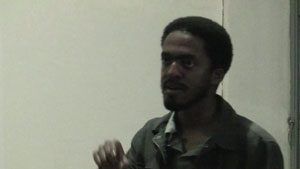
Brook Teklehaimanot: Addis and its Urbanism
part I
part II
part III
Brook Teklehaimanot delivers a detailed technical presentation on the urban development of Addis Ababa from its beginnings in the 19th century up to the present day. After a series of maps that detail the growth patterns of the city, he then moves to a number of photographs of modern-day Addis Ababa that examine different social and urban issues. The discussion also focuses on the relationship between neoliberal capitalism and contemporary city growth.
Synthesis
Addis Ababa and urbanism • Demographics and history of the city • Historical influences on the city’s development • Ethnic versus geographic boundaries • Ausklappen...
Addis Ababa and urbanism • Demographics and history of the city • Historical influences on the city’s development • Ethnic versus geographic boundaries • Roads and transportation infrastructure: organic • Zoning and functional division of the city • Population density • Living conditions across Addis • Mixed forms of transportation in the city with very dense transit corridors • Idiosyncrasies affecting urban development: Ethiopian shoppers
Short biographyBrook Teklehaimanot, a professor in the chair of Architecture and Design at Addis Ababa University, is director of the EiABC protoLAB, a centre with interests in design and fabrication techniques and on the urban development of Addis Ababa.
Teil I
Teil II
Teil III
Brook Teklehaimanot hält einen technisch detaillierten Vortrag zur Stadtentwicklung Addis Abebas, angefangen im 19. Jahrhundert bis in die Gegenwart. Nach einem Einstieg mit einer Reihe von Karten die die Wachstumsmuster der Stadt zeigen, geht er zu einer Serie Fotografien über, die Addis Abeba heute zeigen und verschiedene soziale und urbane Gegebenheiten untersuchen. Die Diskussion bezieht sich außerdem auf die Beziehung zwischen neoliberalem Kapitalismus und zeitgenössischem Stadtwachtum.
Synthese
Addis Abeba und Urbanismus • Demographie und Geschichte der Stadt • Geschichtliche Einflüsse auf die Stadtentwicklung • Ausklappen...
Addis Abeba und Urbanismus • Demographie und Geschichte der Stadt • Geschichtliche Einflüsse auf die Stadtentwicklung • Ethnische vs. geographische Grenzen • Straßen- und Beförderungsinfrastruktur: organisch • Aufteilung und funktionale Einteilung der Stadt • Bevölkerungsdichte • Lebensbedingungen in allen Teilen von Addis • Gemischte Art der Beförderung in der Stadt mit sehr dichten Routen • Empfindlichkeiten beeinflussen die Entwicklung urbanen Raums: Äthiopier sind nicht gewohnt, Läden in oberen Stockwerken zu suchen • Informelle wirtschaftliche Aktivitäten: Märkte im Freien • Gebäude dienen oft nur zu Werbezwecken und als Lagerräume während Handel fast ausschließlich draußen stattfindet • Die Käuflichkeit von allem in Addis • Verschwommene Grenzen zwischen ‘Innen’ und ‘Außen’ auf dem Markt • Fahrzeuge dienen als temporäre Lagerräume • ‘Bettenmakler’ – Betten für eine Nacht an müde Reisende vermitteln • Denkmäler und Ereignisse in Addis • Beispiele für Gebäude die nicht mit Passanten interagieren oder in Kontakt treten • Parks und grüner urbaner Raum • Kirche in Addis von einem Park mit Bäumen umgeben • Vielfalt und Diversität des Wohnens in der Stadt • Wohnprojekte • Wohnbauprojekte für die nahe Zukunft • Für die Stadt typische Gebäudearten • Einfluss durch westliche Architektur in den 1960er Jahren • Gut sichtbare Fassaden beliebt als Werbeflächen • Häuser für Reiche und Privilegierte • Typische Baumaterialien in urbanen, vorstädtlichen und ländlichen Gegenden • Baugerüste aus natürlichen Materialien • Informelle Beförderungsmittel, einschließlich Tiere • Zeitgenössische urbane Struktur in Addis
KurzbiografieBrook Teklehaimanot, Professor des Rates für Architektur und Design an der Addis Abeba University, ist Leiter des EiABC protoLAB, einem Zentrum mit Fokus auf Design, Produktionstechniken und Stadtentwicklung in Addis Abeba.

Helen Zeru
Helen Zeru presents a selection of her visual and video work, which is followed by a general discussion about the work.
Short biographyHelen Zeru studied economics at Bahir Dar University before enrolling at Addis Ababa University’s Alle School of Fine Arts and Design, where she was awarded a BFA in 2008. After graduating, she studied photography with D.E.S.T.A. for Africa. She is an active member of Netsa Art Village and works as a studio artist, freelance photographer, and as an art-therapist for several local NGOs. She has participated in group exhibitions at the Alliance Ethio-Française, the Goethe Institute, the National Museum of Ethiopia, the National Theatre Art Gallery, Netsa Art Village, the Addis Foto Fest, the Museum of Yugoslav History in Belgrade, and the Neue Nationalgalerie in Berlin. Her works in photography, video art, performance, painting, and charcoal drawings often start as reflections of personal and emotional themes before entering a broader social context, touching upon relevant and pressing social issues.
Helen Zeru stellt eine Auswahl ihrer visuellen Arbeiten und ihrer Videoarbeiten vor, gefolgt von einer generellen Diskussion über ihrer Arbeit.
KurzbiografieHelen Zeru studierte Wirtschaftswissenschaft an der Bahir Dar University bevor sie ein Studium an der Alle School of Fine Arts and Design an der Universität Addis Abeba begann. Hier schloss sie im Jahr 2008 ihren BFA ab. Nach dem Abschluss studierte sie Fotografie im Rahmen von D.E.S.T.A. for Africa. Sie ist aktives Mitglied des Netsa Art Village und arbeitet als Studiokünstlerin, freie Fotografin und Kunsttherapeutin für mehrere NGOs vor Ort. Sie nahm an Gruppenausstellungen der Alliance Ethio-Française, des Goethe-Instituts, des National Museum of Ethiopia, der National Theatre Art Gallery, des Netsa Art Village, des Addis Foto Fest, des Museum für Jugoslawische Geschichte in Belgrad, und der Neuen Nationalgalerie in Berlin teil. Ihre fotografischen Arbeiten, Videoarbeiten, Performances, Malereien und Kohlezeichnungen beginnen oft als Reflektion persönlicher und emotionaler Themen bevor sie einen breiteren sozialen Kontext öffnen und relevante, dringliche soziale Themen berühren.
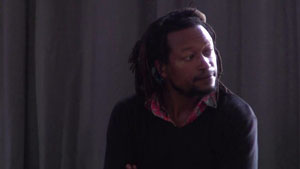
Tamrat Gezahegne
Tamrat Gezahegne presents a series of drawing and painted works done in the studio and outdoors. He shows these and other large paintings, which he then discusses with the group.
Short biographyTamrat Gezahegne holds a BFA in painting from the Alle School of Fine Arts and Design. He has had several solo and group exhibitions in Ethiopia, and has participated in group exhibitions at the Museum of Yugoslav History in Belgrade, at Tana Sachau Gallery in Frankfurt am Main, and the Neue Nationalgalerie in Berlin. He is one of the founders of NAS (New Art Space) and Netsa Art Village in Addis Ababa. His painting and drawings take inspiration from the physical and spiritual surroundings he encounters.
Tamrat Gezahegne präsentiert eine Serie von Zeichnungen und Malereien, die im Studio sowie im Freien entstanden. Er zeigt diese und weitere Gemäldeserien, die er mit der Gruppe diskutiert.
KurzbiografieTamrat Gezahegne hat einen BFA der Alle School of Fine Arts and Design. Er blickt auf mehrere Einzelausstellungen sowie Gruppenausstellungen in Äthiopien zurück und nahm an Gruppenausstellungen teil, u.a. am Museum für Jugoslawische Geschichte in Belgrad, in der Tana Sachau Galerie in Frankfurt am Main und der Neuen Nationalgalerie Berlin. Er ist Mitbegründer von NAS (New Art Space) und dem Netsa Art Village in Addis Abeba. Seine Gemälde und Zeichnungen sind inspiriert von seinen Begegnungen mit seinen physischen und spirituellen Umgebungen.
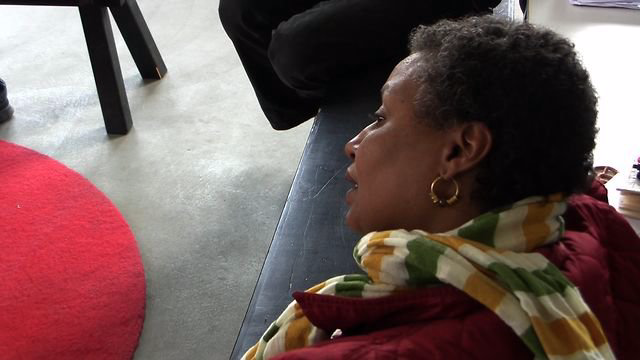
Konjit Seyoum
Konjit Seyoum gives a short talk about her art centre and gallery in Addis Ababa. The discussion centres on ways that the space is structured as an independent project and how it manages to survive and operate within the context of Addis Ababa.
Short biographyKonjit Seyoum is a freelance conference interpreter who was trained in the Department of Interpretation and Translation Studies at the University of Trieste, Italy. In 1996, she opened the Asni Gallery in Addis Ababa with the aim of promoting contemporary Ethiopian art, with a focus on experimentation and young and emerging artists. She conceived Asni as an independent alternative space that runs with no predefined programs and maintains a low budget, avoiding whenever possible aid, sponsorship, funds, and even art sales. She has curated numerous solo and group shows and has organised talks, workshops, residencies, and community projects. Seyoum also promotes innovative vegetarian cooking, drawing on traditional Ethiopian cuisine and nutrition while exploring notions of hospitality, womanhood, the personal, and spirituality.
Konjit Seyoum hält einen Kurzvortrag über ihren Kunstraum in Addis Abeba. Die Diskussion konzentriert sich auf die Strukturen dieses Ortes als unabhängiges Projekt und darauf, wie es gelingt ein solches Projekt in Addis Abeba zu leiten und sein Überleben zu sichern.
KurzbiografieKonjit Seyoum ist freiberufliche Konferenz-Dolmetscherin. Sie studierte am Dolmetscher- und Übersetzerinstitut der Universität Triest in Italien. Im Jahr 1996 eröffnete sie die Asni Gallery in Addis Abeba. Die Galerie setzt sich für zeitgenössische äthiopische Kunst ein, vor allem für experimentell arbeitende und junge Künstler. Sie schuf Asni als einen unabhängigen alternativen Ort, der ohne vorgefertigtes Programm und mit kleinem Budget arbeitet, wobei sie soweit möglich externe Hilfen, Sponsoring, Finanzierung und sogar Kunstverkäufe meidet. Sie kuratierte zahlreiche Einzel- und Gruppenausstellungen und organisierte Talks, Workshops, Residencies und Gemeinschaftsprojekte. Seyoum ist Verfechterin einer innovativen vegetarischen Küche, die auf traditionellen äthiopischen Rezepten und Ernährungsweisen basiert und untersucht mit ihren Projekten das Verständnis von Gastlichkeit, Weiblichkeit sowie dem Persönlichen und Spirituellen.
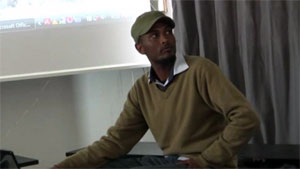
Berhanu Ashagrie Deribew
Berhanu Ashagrie Deribew presents his work with an emphasis on its relation to Addis Ababa. The discussion begins by examining his photographic work as a process for collecting information on Addis Ababa’s changing landscapes, and then moves on to discuss the video works that resulted from the photographs.
Short biographyBerhanu Ashagrie Deribew, artist, head of Addis Ababa University Alle School of Fine Arts and Design, within the Skunder Boghossian College of Performing and Visual Arts. His interests focus on process-based creative practices and time-based art education. He has exhibited in Ethiopia as well as abroad in the Netherlands, Georgia, Greece, and France, with physical art formations and creative documentations.
Berhanu Ashagrie Deribew stellt seine Zusammenarbeit mit dem Institut für Raumexperimente vor und legt dabei den Fokus auf Addis Abebas urbane Strukturen. Die Diskussion beginnt mit einer Untersuchung seiner fotografischen, prozessorientierten Arbeit, bei dem er Informationen über die sich verändernde Stadtlandschaft Addis Abebas sammelt. Schließlich präsentiert er Videoarbeiten die aus diesen Fotografien entstanden.
KurzbiografieBerhanu Ashagrie Deribew, Künstler, Leiter der Alle School of Fine Arts and Design am Skunder Boghossian College of Performing and Visual Arts an der Addis Abeba University. Seine Interessen konzentrieren sich auf prozessbasierte kreative Praktiken und zeitbasierte Medien im Bereich der Kunstausbildung. Seine Kunstinstallationen und kreativen Dokumentationen wurden sowohl in Äthiopien als auch in den Niederlanden, Georgien, Griechenland und Frankreich ausgestellt.

Poetry Jazz Night in Awash
Poetry Jazz Night in Awash National Park near Addis Ababa with contributions by Mihret Kebede (poet, Addis Abeba), Erica Licht (poet, Addis Ababa), Nebiy Mekonnen (poet/translator, Addis Ababa), Abebaw Melaku (poet, Addis Abeba), Rike Scheffler (poet, Berlin), Misrak Terefe (poet, Addis Abeba), Moseb Traditional Music Band (Addis Ababa), and others. Hosted by Tobiya Poetic Jazz, Addis Ababa in collaboration with NTO, Addis Ababa and Institut für Raumexperimente, Berlin.
—
This event is part of Acting Archives, a project by the Institut für Raumexperimente, Berlin University of the Arts and the Alle School of Fine Arts and Design, Addis Ababa University, supported by Studio Olafur Eliasson, and funded by the TURN Fund of the German Federal Cultural Foundation.
Poetry Jazz Night im Awash National Park nahe Addis Abebas mit Beiträge von: Mihret Kebede (Dichterin, Addis Abeba), Erica Licht (Dichterin, Addis Ababa), Nebiy Mekonnen (Dichterin/Übersetzerin, Addis Ababa), Abebaw Melaku (Dichter, Addis Abeba), Rike Scheffler (Dichterin, Berlin), Misrak Terefe (Dichterin, Addis Abeba), Moseb Traditional Music Band (Addis Ababa), und andere.
Tobiya Poetic Jazz, Addis Ababa in Zusammenarbeit mit NTO, Addis Ababa und Institut für Raumexperimente, Berlin.
—
Eine Veranstaltung im Rahmen von Acting Archives, einem Projekt des Instituts für Raumexperimente der Universität der Künste Berlin und der Alle School of Fine Arts and Design, Addis Ababa University, unterstützt durch Studio Olafur Eliasson, gefördert im Fonds TURN der Kulturstiftung des Bundes.
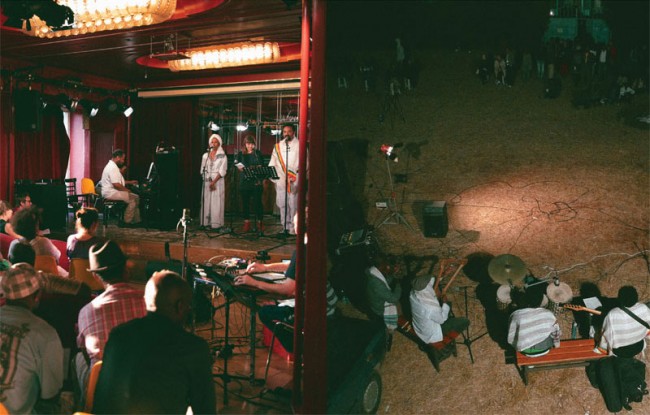
Poetry Jazz Night, Concert, CD & Film Release in Addis Ababa
Poetry Jazz Night, Concert & CD Release and Filmscreening
27 February 2015, 20:00
Alliance Ethio-Française d’Addis-Abeba
Wavel street
Addis Ababa, Ethiopia
A-B-A-B-A : from here to hear is an experiment with rhythms of poetry, soundings, in-voicing, performing, rehearsing, translating and playing together. It is the third experimental get-together of poets, musicians and translators based in Addis Ababa and in Berlin, who join in this exercise of styles.
Spoken poetry has a long history in Ethiopia, with Poetic Jazz being one of its contemporary expressions. Poetic Jazz crosses genetic material from music and poetry in a way that discovers a style and form based in listening. Rhythms, styles, and modes of playing are created between the musicians and the poets and reflect the specific quality of the poems being performed.
Contemporary expressions of this tradition are tested in an artistic dialogue by Gashaw Abateneh (musician, Addis Ababa), Mihret Kebede (poet, Addis Abeba), Erica Licht (poet, Addis Ababa), Robert Lippok (musician, Berlin), Bekele Mekonnen (poet, Addis Ababa), Nebiy Mekonnen (poet/translator, Addis Ababa), Abebaw Melaku (poet, Addis Abeba), Rike Scheffler (poet, Berlin), Misrak Terefe (poet, Addis Abeba), and Moseb Traditional Music Band (Addis Ababa).
On the occasion a new album is launched, featuring recordings of the latest experimental live performances which took place in Berlin in July 2014. Spanning Amharic, English and German, the album A-B-A-B-A : from hear to here includes poems, performances, translations and sounds by Eric Ellingsen (poet/writer, Berlin/US), Mihret Kebede (poet, Addis Abeba), Robert Lippok (musician, Berlin), Abebaw Melaku (poet, Addis Abeba), Jorga Mesfin (musician, Addis Abeba), Rike Scheffler (poet, Berlin), Misrak Terefe (poet, Addis Abeba), Uljana Wolf (poet, Berlin). The release is accompanied by a documentary and short film by artist and film maker Clara Jo (Berlin/US).
About the participating artists, poets and musicians
Gashaw Abateneh is a renowned musician and performer, known for his patriotic recitals and performances of Ethiopian battle songs in traditional acting style. He regularly stars at the Ethiopian National Theatre.
Mihret Kebede is an artist, poet, and the founding director of the Netsa Art Village artist collective in Addis Ababa. Renowned for her poetry readings and experimental artworks, Kebede is also a founding member of Tobiya Poetic Jazz Group and is featured on the Tobiya poetic jazz DVD, Vol.1.
Erica Licht focuses her research and work on creating bridges between community members and stakeholders, through dialogue and holistic environmentally conscious curriculum. Her practice has spanned leadership development, radio production, and anti-violence programs, including sites of the African Diaspora and Sub-Saharan Africa, with long-term posts in Trinidad, Jamaica, Uganda, Nigeria, Ethiopia, and the United States. Erica holds a B.A. in Africana Studies and Geography from Vassar College, where she was the recipient of the Paul Robeson Prize for the best senior thesis in the Department of Africana Studies, and the Frederic C. Wood Prize for excellence in morals and ethics.
Robert Lippok is a musician and artist based in Berlin. He is a cofounder of the music groups Ornament und Verbrechen and To Rococo Rot. Recent works include ηχώ at the Festival of Future Nows, Neue Nationalgalerie Berlin (2014); the album Instrument with To Rococo Rot (City Slang, 2014); Daylightastronomy, music performance, Mutek, Montreal, Canada (2014); 24h Dahlem, music for a video installation by Clara Jo (2012–14); The Persistence of Memory, music performance with Nino Errera, Ethnologisches Museum, Berlin (2014); and Betón Brut, with Ronald Lippok, music for an exhibition by Arno Brandlhuber, NBK, Berlin (2014).
Abebaw Melaku is a poet and journalist. He is a founding member of Tobiya Poetic Jazz Group and a radio journalist affiliated with the Ethiopian radio show ‘Addis Zema’. He published a volume of poetry called Keradion in 2007 and an audio poetry CD in 2008.
The Moseb Traditional Music Band was established in 2013 with musicians playing basic traditional music instruments like base and lead kirar, drum, flute and masinko. They have been performing at different stages, cultural institutes, theatres, and jazz clubs, and have also collaborated with other established musicians in the country on various occasions. The band includes members: Tewodros Alemu (Saxophone), Solomon Betre Mariyam (Trumphet), Biniam Dagnachew (Lead kirar), Abu Gebre (Flute), Yigerem Gulilat (Bass kirar), Dawit Lisanu (Masinko), Robel Solomon (Drums).
Bekele Mekonnen is a visual artist, poet, and educator. He has had numerous critically acclaimed exhibitions in Ethiopia, Europe and the USA, and has been awarded a number of residencies, fellowships, and awards both at home and abroad, including the Chicago Artists International Program, the Scholar Rescue Fund, and at the Maryland Institute College of Art in Baltimore, Maryland, USA. Bekele earned a Masters degree in Fine Arts from Moscow State Institute of Fine Arts in 1993. He served two terms (2000-2004 and 2009-2011) as the director of Ale School of Fine Arts and Design in Addis Ababa, where he is currently teaching as an Assistant Professor. From 2008-2010 he was director of the Modern Art Museum / Gebre Kristos Desta Center in Addis Ababa.
Rike Scheffler, based in Berlin, creates work at the intersection of poetry and music. She has published work in many journals and anthologies, and has set them in song, text, and tone collages for the stage. She studied creative writing at the Deutschen Literaturinstitut in Leipzig and psychology at the Freie Universität in Berlin. Her poetry collection der rest ist resonanz appeared in the fall of 2014 from kookbooks Verlag. Rike Scheffler was a finalist at the 20th Open Mike and a grant recipient of the Stiftung Brandenburger Tor in Copenhagen. She helped found the poetry collective G13, a group of writers who bring together poetry with experimental stage productions and regularly organise open writing workshops in Berlin in an effort to encourage solidarity and a critical exchange among authors. She enjoys challenging common perceptions through small words and sounds and creating spaces through language.
Misrak Terefe is an Ethiopian poet and the first female poet to publish a poetry VCD. She has contributed to different group publications with other writers and is featured on the Tobiya poetic jazz DVD, Vol.1. She is also a founding member of Tobiya Poetic Jazz Group, having been involved with the organization since 2008.
In dialogue with:
Nebiy Mekonnen is a renowned poet, journalist, playwright and translator who has published poetry books and various essays. Nebiy is best known for “Negem lela ken new”, a translation into Amharic of the novel “Gone with the Wind”, which he wrote on 3000 cigarette paper pieces while in prison for a decade during the Derge Regime. He is also editor-in-chief of the popular weekly newspaper Addis Admass.
Christina Werner is a curator and educator based in Berlin. She is co-director of the Institut für Raumexperimente and co-initiator and coordinator of the project Acting Archives–Media Lab for Artistic Research and Education developing collaboration and education formats between artists and educators based in Addis Ababa and Berlin on the subject of artistic translation and proactive archiving.
—
This event is part of Acting Archives, a project by the Institut für Raumexperimente, Berlin University of the Arts and the Alle School of Fine Arts and Design, Addis Ababa University. It is choreographed by Mihret Kebede and Christina Werner and hosted by the Alliance Ethio-Française d’Addis-Abeba; supported by Studio Olafur Eliasson, and funded by the TURN Fund of the German Federal Cultural Foundation.
Poetry Jazz Night, Concert & CD Release and Filmscreening
27. Februar 2015, 20:00
Alliance Ethio-Française d’Addis-Abeba
Wavel street
Addis Ababa, Ethiopia
A-B-A-B-A : from here to hear ist die dritte experimentelle Lyrikveranstaltung, die Dichter, Musiker und Übersetzer aus Addis Abeba und Berlin im Rahmen dieser Stilübungen zusammenbringt. Der Workshop findet an der Alle School of Fine Arts and Design statt. Dort werden neue Strukturen und Methoden im gemeinsamen Dialog getestet: der Workshop lädt ein, sich mit der Tradition mündlicher Überlieferung in der amharischen Poesie-Kultur zu befassen, mit Übersetzungen und Interpretationen zwischen Deutsch, Englisch und Amharisch als auch mit performativen Aufführungselementen, mit Musiktraditionen der traditionellen äthiopischen Musik, Jazz-Elementen und zeitgenössicher elektronischen Musik. Die gemeinsamen Proben finden ihren Höhepunkt in einem Poesie-Konzert-Abend, der in der Alliance Ethio-Française d’Addis-Abeba stattfindet und von einer CD-Vorstellung und der Premiere des Dokumentarfilms von Clara Jo begleitet wird.
Teilnehmende Künstler sind Gashaw Abateneh, Mihret Kebede, Erica Licht, Robert Lippok, Bekele Mekonnen, Nebiy Mekonnen, Abebaw Melaku, Rike Scheffler, Misrak Terefe und die Moseb Traditional Music Band.
Über die teilnehmenden Künstler, Poeten und Musiker:
Clara Jo ist Künstlerin, lebt und arbeitet in Berlin.
Gashaw Abateneh ist ein renommierter Musiker und Performer, bekannt für seine patriotischen Vokalstücke und den performativen Vortrag von traditionellen äthiopischen Krieg- und Kampflieder. Er tritt regelmäßig im Äthiopischen Nationaltheater auf.
Mihret Kebede ist eine Künstlerin, Dichterin und Gründungsdirektorin des Netsa Art Village Künstlerkollektivs in Addis Abeba. Sie ist für ihre Gedichtlesungen und experimentellen Kunstwerke bekannt und außerdem Gründungsmitglied der Tobiya Poetic Jazz Group, auf deren Platte Tobiya Poetic Jazz DVD, Vol.1. sie zu hören ist.
Erica Licht ist Beraterin und Mediatorin, die im Bereich der Entwicklung von Führungsqualitäten, von Radioproduktionen und von Gewaltpräventionsprogrammen arbeitet. Sie ist Fulbright Scholar und der Schwerpunkt ihrer Forschung und Arbeit ist es, zwischen Community- Mitgliedern und verschiedenen Interessengruppen durch Dialog und ganzheitliche umweltbewusste Themensetzung zu vermitteln. Die afrikanischen Diaspora und Afrika südlich der Sahara sind Teil ihrer Forschung, verbunden mit langfristigen Aufenthalten in Trinidad, Jamaika, Uganda, Nigeria, Äthiopien und den Vereinigten Staaten. Erica schloss mit einem B.A. in African Studies und Geographie von Vassar College ab, sie erhielt den Paul Robeson Preis für die beste Abschlussarbeit im Fachbereich African Studies und den Frederic C. Wood-Preis für Spitzenleistungen im Bereich Moral und Ethik.
Robert Lippok ist ein in Berlin lebender Musiker und Künstler. Er ist Mitbegründer der Bands Ornament und Verbrechen und To Rococo Rot. Aktuelle Arbeiten umfassen ηχώ im Rahmen des Festival of Future Nows an der Neuen Nationalgalerie Berlin (2014), das Album Instrument mit To Rococo Rot (City Slang, 2014), die Musikperformance Daylightastronomy, Mutek, Montreal, Canada (2014), ein Musikvideo zu einer Installation von Clara Jo (2012–14); Die Musikperformance The Persistence of Memory gemeinsam mit Nino Errera, Ethnologisches Museum Berlin (2014); sowie Betón Brut gemeinsam mit Ronald Lippok, Musik für eine Ausstellung von Arno Brandlhuber, NBK, Berlin (2014).
Bekele Mekonnen ist bildender Künstler, Dichter und Pädagoge. Er hat zahlreiche Ausstellungsbeteilungen in Äthiopien, Europa und den USA und eine Reihe von Residenzen, Stipendien und Auszeichnungen im In- und Ausland, darunter am Maryland Institute College of Art in Baltimore, Maryland, US, das Chicago Artists International Program, und Scholar Rescue Fund. Bekele erwarb 1993 seinen Master-Abschluss Kunst an der Moskauer Hochschule für Malerei, Bildhauerei und Architektur. Er diente zwei Amtszeiten (2000 – 2004 und 2009 – 2011) als Direktor der Alle School of Fine Arts and Design, wo er derzeit als Professor lehrt. Von 2008 – 2010 war er Direκtor des Museums für Moderne Kunst / Gebre Kristos Desta Center in Addis Abeba.
Abebaw Melaku ist Dichter und Journalist. Er ist Gründungsmitglied der Tobiya Poetic Jazz Goup und arbeitet als Radiojournalist.Er hat im Jahr 2007 einen Gedichtband mit dem Titel Keradion herausgegeben sowie eine Audio- CD mit Gedichten im Jahr 2008.
Misrak Terefe ist äthiopische Dichterin und die erste weibliche Dichterin die eine VCD mit Gedichten herausbrachte. Sie trug zu verschiedenen Gruppenpublikationen bei und ist auf der Tobiya Poetic Jazz DVD, Vol.1. zu hören. Außerdem ist sie Gründungsmitglied der Tobiya Poetic Jazz Group mit der sie seit dem Jahr 2008 zusammenarbeitet.
Rike Scheffler lebt in Berlin und arbeitet auf der Grenze zwischen Dichtung und Musik. Sie hat in verschiedenen Journals und Anthologien veröffentlicht und ihre Arbeiten als Lieder, Texte und Klangcollagen für die Bühne adaptiert. Sie studierte Kreatives Schreiben am Deutschen Literaturinstitut in Leipzig und Psychologie an der Freien Universität Berlin. Ihre Gedichtsammlung der rest ist resonanz erschien im Herbst 2014 bei kookbooks. Rike Scheffler war eine Finalistin des 20. Open Mike und Stipendiantin der Stiftung Brandenburger Tor in Kopenhagen. Sie ist Mitbegründerin des Lyrikkollektivs G13, einer Autorengruppe Gruppe die Dichtung mit experimenteller Bühnenproduktion zusammenbringt und in regelmäßigen Abständen offene Schreibworkshops in Berlin veranstaltet, um Solidarität und kritischen Austausch zwischen KünstlerInnen zu unterstützen. Sie hinterfragt mit Vorliebe als gegeben vorausgesetzte Wahrnehmung durch kleine Wortinterventionen, Klänge und Sprachräume.
Moseb Traditional Music Band wurde vor zwei Jahren gegründet, die Mitglieder spielen traditionelle Musikinstrumente wie Kirar, Trommel, Flöte und Masink. Die Band etablierte sich mit ihrem Programm und spielt in Kulturinstituten, Theatern und Jazz-Clubs. Die Band kooperiert regelmäßig mit anderen äthiopischen Musikern. Moseb Traditional Music Band (Addis Abeba): Tewodros Alemu (Saxophon), Solomon Betre Mariyam (Trompete), Biniam Dagnachew Poesie-Workshop und Veranstaltung A-B-A-B-A : from here to hear (Lead Kirar), Abu Gebre (Flöte), Yigerem Gulilat (Bass Kirar), Dawit Lisanu (Masinko), Robel Solomon (Schlagzeug).
Im Gespräch mit:
Nebiy Mekonnen ist ein bekannter Dichter, Journalist, Dramatiker und Übersetzer, der Poesie-Bücher und verschiedene Aufsätze veröffentlicht hat. Nebiy Mekonnen ist bekannt für “Negem lela ken neu”, eine Übersetzung des Buches “Vom Winde verweht” ins Amharische, die er auf 3000 einzelnen Zigarettenpapierstücke während seiner Jahre im Gefängnis während des Derge Regimes schrieb. Er ist darüber hinaus Chefherausgeber der beliebten Wochenzeitung “Addis admass”.
Christina Werner kuratierend und lehrend in Berlin tätig. Sie ist Co-Direktorin des Instituts für Raumexperimente und Co-Initiatorin des Projekts Acting Archiv – Media Lab für künstlerische Forschung und Bildung, das die Entwicklung von Kooperationen für Kunst- und Bildungsformate zwischen Künstlern und Lehrenden aus Addis Ababa und Berlin zu Themen von Übersetzung und proaktiver Archivierung mit künstlerischen Mitteln verfolgt.
—
Eine Veranstaltung im Rahmen von Acting Archives, einem Projekt des Instituts für Raumexperimente der Universität der Künste Berlin und der Alle School of Fine Arts and Design, Addis Ababa University. Die Veranstaltung ist choreographiert von Mihret Kebede and Christina Werner, in Zusammenarbeit mit der Alliance Ethio-Française d’Addis-Abeba; unterstützt durch Studio Olafur Eliasson, gefördert im Fonds TURN der Kulturstiftung des Bundes.

Vladimir Miller
conversation on dance, choreography and space with Vladimir Miller and guests Philipp Gehmacher and Stephanie Rauch
Philipp Gehmacher, Vladimir Miller and Stephanie Rauch presenting their collaborative projects
presentation and conversation with Vladimir Miller about his artistic practice
Gespräch über Tanz, Choreographie und Raum mit Vladimir Miller und den Gästen Philipp Gehmacher und Stephanie Rauch
Vladimir Miller, Philipp Gehmacher und Stephanie Rauch präsentieren ihre Projekte
Vortrag und Gespräch mit Vladimir Miller über seine künstlerische Praxis

Digestion dinner
Post-Ethiopia digestion dinner with invited guests Bonaventure Ndikung, Ellen Blumenstein, Annette Schemmel and Michaela Meise. Dinner prepared in collaboration with Lynn Peemoeller and Fotini Lazaridou-Hatzigoga.
Post-Ethiopia digestion dinner mit: Bonaventure Ndikung, Ellen Blumenstein, Annette Schemmel und Michaela Meise. Dinner vorbereitet in Kollaboration mit Lynn Peemoeller und Fotini Lazaridou-Hatzigoga.
Semir Zeki & Anton Burdakov. Zu Gast bei den Neuroesthetics Talk Series
NEUROESTHETICS TALKS SERIES
„The forms of space“ – A dialogue between Semir Zeki, and Anton Burdakov
Abstract:
Space is a loosely defined term and so offers many working definitions to many fields. The dialogue will consider whether neuroscientific insights and definitions relevant to ’space‘ could find currency in other fields, such as art and architecture. It will touch on perception of form, colour and movement as the basis of establishing the nature of relationships between yourself and other entities in the world. It will also consider more specifically what it means to perceive yourself to be inside a particular space, discussing contributions of memory, non-visual factors in space perception, and the crucial but neglected role of peripheral vision in creating a sense of enveloping spatiality and embedding the subject in space.
Location:
Berlin School of Mind and Brain
Luisenstraße 56, Haus 1, 2nd Floor, FESTSAAL
10117 Berlin

Vlado Velko: Projekttreffen
Meeting with Vlado Velkov to discuss invitation to competition at Kunstverein Arnsberg and proposal critique, invited by Christina Werner
Friederike Horbrügger & Fabian Knecht, Sky Paintings, Arnsberg, 2010
Arbeitstreffen mit Vlado Velkov: Einladung zum Wettbewerb für den Kunstverein Arnsberg und Kritik von Projektvorschlägen, eingeladen von Christina Werner
Friederike Horbrügger & Fabian Knecht, Sky Paintings, Arnsberg, 2010
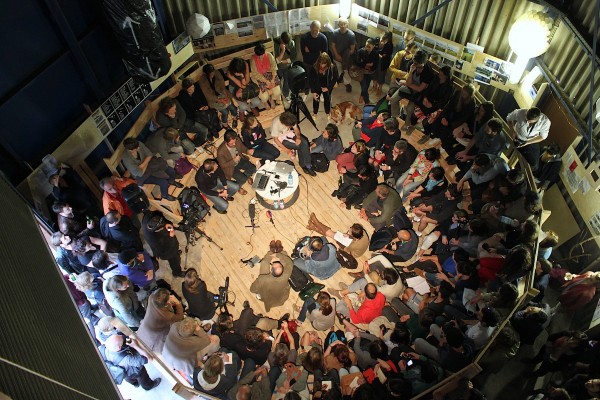
Caring is Acting
Artistic Engagement in Public Space, Conversation with Olafur Eliasson, Eric Ellingsen, Guido Brendgens, Benjamin Foerster-Baldenius, Joanna Warsza, Christina Werner, e.a.
Part I: Introduction by Olafur Eliasson and presentation by Guido Brendgens
Part II: presentation by Olafur Eliasson
Part II: presentation by Joanna Warsza
Part IV: presentation by Benjamin Foerster-Baldenius
Künstlerisches Engagement im öffentlichen Raum, Gespräch mit Olafur Eliasson, Eric Ellingsen, Guido Brendgens, Benjamin Foerster-Baldenius, Joanna Warsza, Christina Werner, e.a.
Teil I: Einführung von Olafur Eliasson und Präsentation von Guido Brendgens
Teil II: Präsentation von Olafur Eliasson
Teil II: Präsentation von Joanna Warsza
Teil IV: Präsentation von Benjamin Foerster-Baldenius
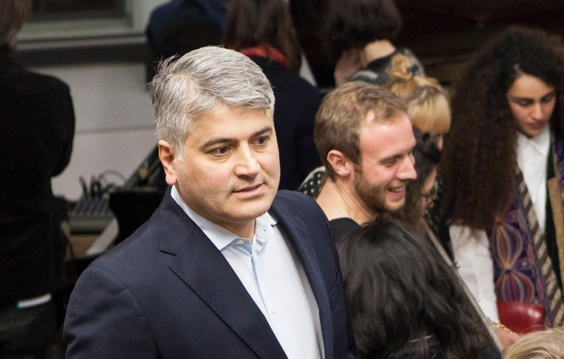
Mehmet Daimagüler: Über den NSU Prozess
Conversation with Mehmet Daimagüler and Antonia von der Behrens
Over the course of 10 years Germany’s security services, politicians and media failed to link a series of murders to the right wing extremist group, the NSU. The alleged neo-Nazi terrorist Beate Zschäpe and her four co-accused are currently on trail in Munich, a trial followed by international media attention.
Mehmet Gürcan Daimagüler is a lawyer representing families of two of the of the NSU’s victims – the right wing terrorist group National Socialist Underground. Mehmet G. Daimagüler was born in 1968 in West Germany and is the son of Turkish immigrants. He studied law, economics and philosophy at German and American universities. He was selected as one of Yale University’s World Fellows and as a Litauer Fellow at Harvard. He worked in the offices of two members of the German Bundestag and was the first person of Turkish origin to be voted into the executive board of a German political party when he was elected to the federal executive committee of the liberal FDP. He resigned from the party in 2007. Daimagüler has also worked for Boston Consulting Group. He is the author of a book on identity and he also spearheads inter-religious dialogue in Germany, bridging, in particular, the Muslim-Jewish divide.
Gespräch mit Mehmet Daimagüler und Antonia von der Behrens
Im Laufe von 10 Jahren versagten Deutschlands Sicherheitsdienste, Politiker und Medien eine Reihe von Morden mit der rechtsradikalen Gruppe NSU in Verbindung zu bringen. Die mutmaßliche Neonazi-Terroristin Beate Zschäpe und ihre vier Mitangeklagten stehen derzeit in München vor Gericht. Der Strafprozess wird von den internationaler Medien mit Aufmerksamkeit verfolgt.
Mehmet Gürcan Daimagüler ist Anwalt, der Familien von zwei der Opfer der NSU, der rechtsradikalen Terrorgruppe Nationalsozialistischen Untergrund, vertritt. Mehmet G. Daimagüler wurde 1968 in der Bundesrepublik Deutschland geboren und ist der Sohn türkischer Einwanderer. Er studierte Rechtswissenschaften, Wirtschaftswissenschaften und Philosophie an deutschen und amerikanischen Universitäten. Er wurde als einer der Yale University World Fellows und Litauer Fellow der Harvard University ausgezeichnet. Er arbeitete in den Büros von zwei Mitgliedern des Deutschen Bundestages und war die erste Person türkischer Herkunft, die in den Vorstand eines deutschen politischen Partei aufgenommen wurde, als er in den Bundesvorstand der FDP gewählt wurde. Er trat 2007 aus der Partei aus. Daimagüler war auch für die Boston Consulting Group tätig. Er ist Autor eines Buches über Identitätsfragen und er setzt sich aktiv für einen interreligiösen Dialog in Deutschland ein, insbesondere um muslimisch-jüdische Differenzen zu überbrücken.
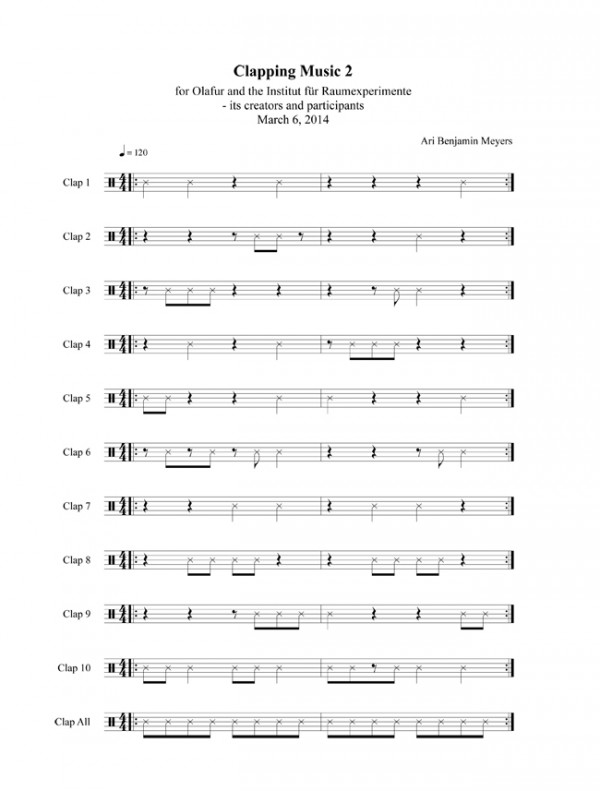
Abschlusszeremonie
6.3.2014
Closing Ceremony with closing addresses by Martin Rennert, president of the Berlin University of the Arts and Olafur Eliasson
Certificates and „Your Effort Compass“ gifted to all participants
Music and more by Hildur Guðnadóttir, Hauschka, Ari Benjamin Meyers, Robert Lippok, Jan Werner
Reception and Drinks
The Institut für Raumexperimente celebrated, together with all the participants, peers, friends, guests, partners and collaborators, the closing of the Institute and the past five years of learning together. We would like to thank everyone thank you thank you thank you thank you for your generous support, participation, and accompaniment throughout the experiment. You shaped and shape who we are. We celebrate with you from the positions in the futures from which we now take a stand looking back through the coming pasts to now. We have only just begun.
6.3.2014
Abschlusszeremonie mit Schlussworten von Martin Rennert, Präsident der Universität der Künste Berlin, und Olafur Eliasson.
Übergabe des „Your Effort Compass“ und Zertifikate an alle Teilnehmer
Musikprogramm mit Hildur Guðnadóttir, Hauschka, Ari Benjamin Meyers, Robert Lippok und Jan Werner
Empfang und Drinks
Mit den Teilnehmern, Gästen, Freunden, Partnern und Kollegen feiert das Institut für Raumexperimente das Schließen des Instituts und die vergangenen 5 Jahre gemeinsamen Lernens. Wir möchten euch allen danken danken danken für eure großzügige Unterstützung, Teilnahme und Vertrauen in unser Experiment. Ihr habt uns Gestalt gegeben. Wir feiern mit euch von jenen Zukünften her, von denen aus wir durch die kommenden Vergangenheiten auf das Jetzt schauen. Wir haben gerade erst begonnen.

Andreas Roepstorff: Experimenting with Interactions
Experimenting with InteractionsLecture by Andreas Roepstorff
Lecture by Andreas Roepstorff, part 1
Lecture by Andreas Roepstorff, part 2
Experimenting with InteractionsVortrag von Andreas Roepstorff
Vortrag von Andreas Roepstorff, Teil 1
Vortrag von Andreas Roepstorff, Teil 2
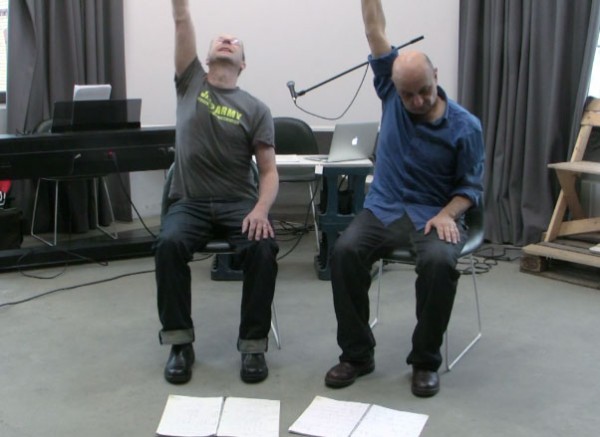
Jonathan Burrows & Matteo Fargion
Talk, performance and lecture with Jonathan Burrows & Matteo Fargion
Introduction and performance by Jonathan Burrows & Matteo Fargion
Talk with Jonathan Burrows & Matteo Fargion after the performance
Concert lecture by Jonathan Burrows & Matteo Fargion
Gespräch, Performance und Vortrag von Jonathan Burrows & Matteo Fargion
Einführung und Performance von Jonathan Burrows & Matteo Fargion
Gespräch mit Jonathan Burrows & Matteo Fargion nach der Performance
Concert lecture von Jonathan Burrows & Matteo Fargion

Hans Ulrich Obrist und Olafur Eliasson
Hans Ulrich Obrist in conversation with Olafur Eliasson with guests Ho Rui An and Julie Boukobza
Hans Ulrich Obrist, Part 1
Hans Ulrich Obrist, Part 2
Hans Ulrich Obrist im Gespräch mit Olafur Eliasson und Gästen Ho Rui An und Julie Boukobza
Hans Ulrich Obrist, Teil 1
Hans Ulrich Obrist, Teil 2
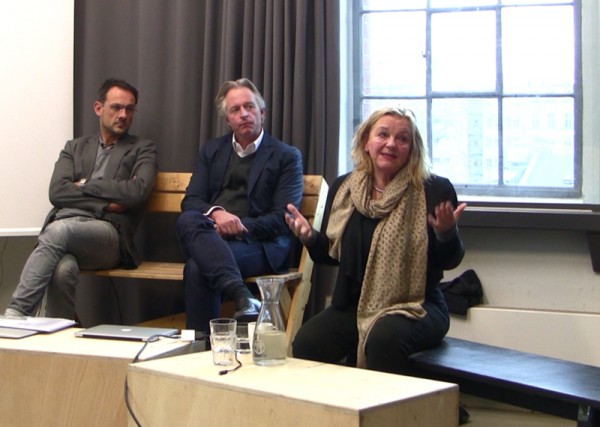
VideoArtMarket InfoTalk mit Kristine Huschka, Natasha Mendonca, Olaf Stüber und Stephan Urbaschek
Conversation with Olaf Stüber, Stephan Urbaschek, Kristine Huschka & Natasha Mendonca
talk with Kristine Huschka
presentation by Stephan Urbaschek
talk with Natasha Mendonca
Olaf Stüber presented the film Money and the Video Artist by Björn Perburg
listen to the VideoArtMarketInfoTalk discussion with Olaf Stüber, Stephan Urbaschek, Kristine Huschka & Natasha Mendonca
Gespräch mit Olaf Stüber, Stephan Urbaschek, Kristine Huschka & Natasha Mendonca
Gespräch mit Kristine Huschka
Präsentation von Stephan Urbaschek
Gespräch mit Natasha Mendonca
Olaf Stüber präsentierte den Film Money and the Video Artist von Björn Perburg
VideoArtMarketInfoTalk - Diskussion mit Olaf Stüber, Stephan Urbaschek, Kristine Huschka & Natasha Mendonca
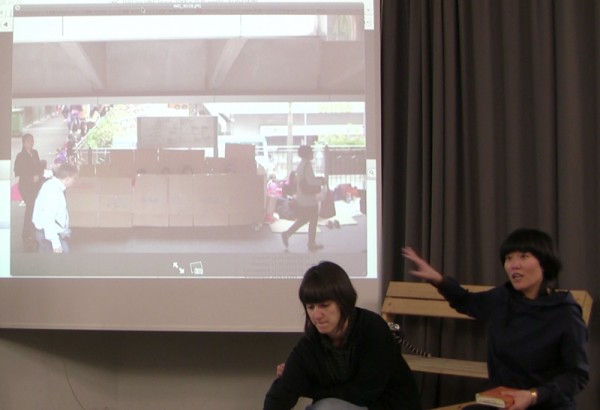
Elaine W. Ho & Fotini Lazaridou-Hatzigoga
Hong Kong / Shenzhen Bi-City Biennale of Urbanism / ArchitectureConversation with Elaine W. Ho & Fotini Lazaridou-Hatzigoga
watch presentation by Elaine W. Ho & Fotini Lazaridou-Hatzigoga
Hong Kong / Shenzhen Bi-City Biennale of Urbanism / ArchitectureGespräch mit Elaine W. Ho & Fotini Lazaridou-Hatzigoga
Vortrag von Elaine W. Ho & Fotini Lazaridou-Hatzigoga
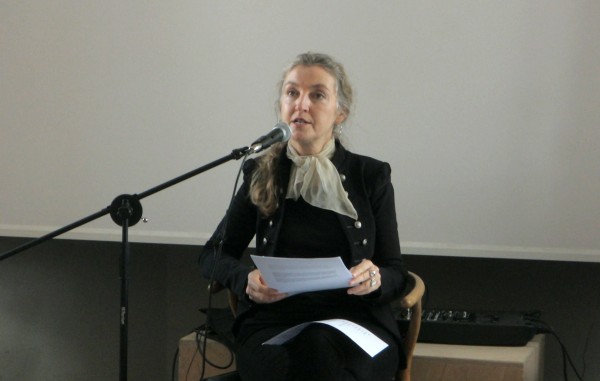
Rebecca Solnit: On Walking
A meandering conversation on walking, activism, and embodiment
watch talk with Rebecca Solnit, Part I
watch talk with Rebecca Solnit, Part II
Ein Gespräch über Laufen, Aktivismus und Embodiment
Gespräch mit Rebecca Solnit, Teil I anschauen
Gespräch mit Rebecca Solnit, Teil II anschauen
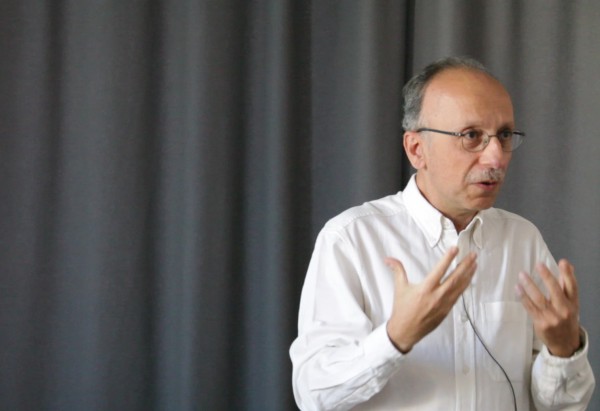
Michel Bitbol: Der blinde Fleck der Wissenschaft
Michel Bitbol: Overcoming the blind spot of scienceLecture by Michel Bitbol and conversation with Michel Bitbol and Olafur Eliasson
Lecture by Michel Bitbol
Conversation with Michel Bitbol and Olafur Eliasson
Michel Bitbol: Overcoming the blind spot of scienceVortrag von Michel Bitbol und Gespräch mit Michel Bitbol und Olafur Eliasson
Vortrag von Michel Bitbol
Gespräch mit Michel Bitbol und Olafur Eliasson
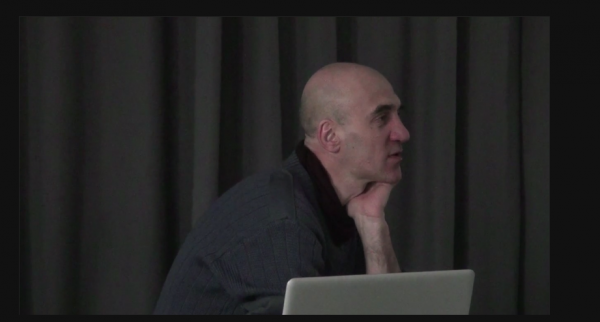
Künstlergespräch: Armin Linke
watch Artist Talk with Armin Linke, Part I
watch Artist Talk with Armin Linke, Part II
watch Artist Talk with Armin Linke, Part III
Künstlergespräch mit Armin Linke, Teil I anschauen
Künstlergespräch mit Armin Linke, Teil II anschauen
Künstlergespräch mit Armin Linke, Teil III anschauen
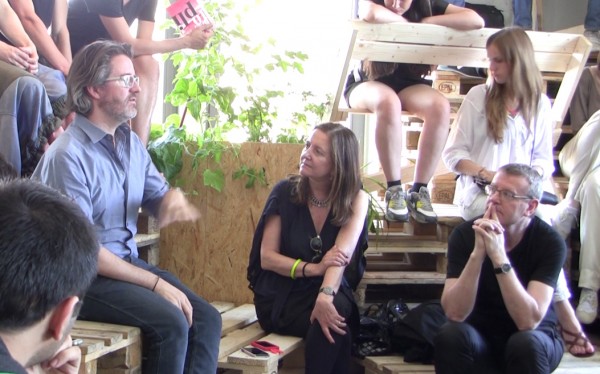
Beatriz Colomina & Mark Wigley: An Accidental Accomplishment
An Accidental AccomplishmentBeatriz Colomina & Mark Wigley in conversation with Olafur Eliasson
watch conversation between Beatriz Colomina, Mark Wigley and Olafur Eliasson
An Accidental AccomplishmentBeatriz Colomina & Mark Wigley im Gespräch mit Olafur Eliasson
Gespräch zwischen Beatriz Colomina, Mark Wigley und Olafur Eliasson anschauen
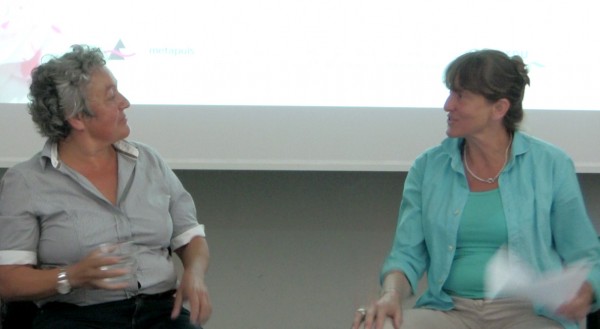
Regula Langemann & Suna Yamaner: Nonviolent Communication
Nonviolent Communication (NVC) - A Language of CompassionConversation with Regula Langemann, Suna Yamaner & Olafur Eliasson
watch Regula Langemann & Suna Yamaner: Nonviolent Communication, Part 1
watch Regula Langemann & Suna Yamaner: Nonviolent Communication, Part 2
Nonviolent Communication (NVC) - A Language of CompassionGespräch mit Regula Langemann, Suna Yamaner & Olafur Eliasson
Regula Langemann & Suna Yamaner: Nonviolent Communication, Teil I anschauen
Regula Langemann & Suna Yamaner: Nonviolent Communication, Teil II anschauen
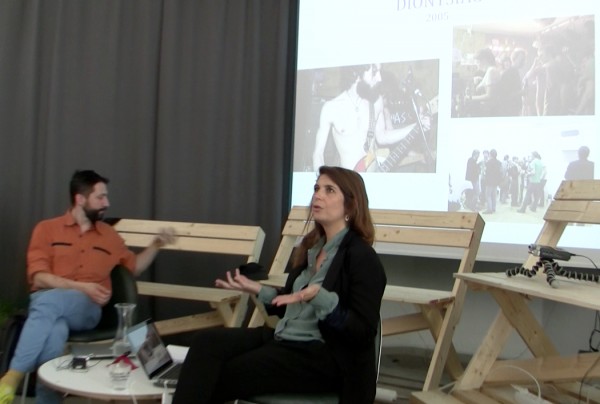
Christine Macel & Yorgos Sapountzis: Performance & Material
Conversation and Presentations by Christine Macel & Yorgos Sapountzis followed by Parachute Presentations and critiques focusing on performative works
watch artist talk by Yorgos Sapountzis
Gespräch mit und Vorträge von Christine Macel & Yorgos Sapountzis gefolgt von Parachute Präsentationen and Kritiken performativer Arbeiten
Künstlergespräch mit Yorgos Sapountzis

Molly Nesbit: Der Erzähler
June 19: PreparationInspiration and conversation with Christina Werner & Eric Ellingsen;
Reading practice: Walter Benjamin: The Storyteller;
Film secession: Chris Marker: Sans Soleil
June 20: Molly Nesbit: The Storyteller. Part Iin conversation with Olafur Eliasson;
Experiencing travel and narration. A Follow-up Conversation started in Addis Ababa;
Referencing Walter Benjamin: The Storyteller and Chris Marker: Sans Soleil
watch The Storyteller. Part I with Molly Nesbit, part I
watch The Storyteller. Part I with Molly Nesbit, part II
June 21: Molly Nesbit: The Storyteller. Part IIExperiencing travel and narration. A Follow-up Conversation started in Addis Abeba
Referencing Walter Benjamin: The Storyteller and Chris Marker: Sans Soleil
Film secession: Notes for an African Orestaia by Pier Paolo Pasolini
watch The Storyteller. Part II with Molly Nesbit, part I
watch The Storyteller. Part II with Molly Nesbit, part II
June 21: Molly Nesbit: The Storyteller. Part IIIFilm Night and Korean barbecue
Film screening of Nightless by Yuichiro Tamura and barbecue by Lynn Peemoeller and Anne Duk Hee Jordan at FIT (Freie Internationale Tankstelle)
Barbecue by Lynn Peemoeller & Anne Duk Hee Jordan
Film screening of Nightless by Yuichiro Tamura
Molly Nesbit leads a three-day seminar The Storyteller, discussing various artistic methods for sharing experiences of travel through narration. Topics of discussion include Walter Benjamin’s essay The Storyteller: Observations on the Works of Nikolai Leskov as well as Chris Marker’s film Sans Soleil and Pier Paolo Pasolini’s film Notes Towards an African Orestes. Nesbit examines the aspects of narrating and storytelling found in these examples. The conversation with Olafur Eliasson, Christina Werner, Eric Ellingsen, and the participants draws on experiences from living and working in Addis Ababa from October to December 2012.
Short biography
Ausklappen...
Molly Nesbit, chair and professor in the Department of Art at Vassar College and contributing editor of Artforum. She is the author of Atget’s Seven Albums (1992), Their Common Sense (2000), and The Pragmatism in the History of Art (2013), the first volume in a collection of her essays. Since 2002, together with Hans Ulrich Obrist and Rirkrit Tiravanija, she has tri-curated Utopia Station, an ongoing book, exhibition, seminar, website, and street project.
RELATED READING MATERIAL
Benjamin, Walter, „The Storyteller. Observations on the Works of Nikolai Leskov“, in: Michael W. Jennings u. a., Walter Benjamin. Selected Writing, 3, 1935–1938, Cambridge 2002, S. 144–166.
19. Juni: VorbereitungEinstimmung und Gespräche mit Christina Werner & Eric Ellingsen;
Lektürepraxis: Walter Benjamin: Der Erzähler - Betrachtungen zum Werk Nikolai Lesskows;
Filmvorführung: Chris Marker: Sans Soleil
20. Juni: Molly Nesbit: Der Erzähler. Teil Iim Gespräch mit Olafur Eliasson;
Reisen erfahren und erzählen. Fortsetzung eines Gesprächs begonnen in Addis Abeba mithilfe von Walter Benjamins Der Erzähler und Chris Markers Sans Soleil
Molly Nesbit: Der Erzähler. Teil I, ersten Teil anschauen
Molly Nesbit: Der Erzähler. Teil I, zweiten Teil anschauen
21. Juni: Molly Nesbit: Der Erzähler. Teil IIReisen erfahren und erzählen. Fortsetzung eines Gesprächs begonnen in Addis Abeba mithilfe von Walter Benjamins Der Erzähler und Chris Markers Sans Soleil
Filmvorführung: Notes for an African Orestaia von Pier Paolo Pasolini
Molly Nesbit: Der Erzähler. Teil II, ersten Teil anschauen
Molly Nesbit: Der Erzähler. Teil II, zweiten Teil anschauen
21. Juni: Molly Nesbit: Der Erzähler. Teil IIIFilmabend und Koreanisches Barbecue
Vorführung von Nightless von Yuichiro Tamura und Barbecue von Lynn Peemoeller und Anne Duk Hee Jordan in der FIT (Freie Internationale Tankstelle)
Barbecue von Lynn Peemoeller & Anne Duk Hee Jordan
Filmvorführung Nightless von Yuichiro Tamura
Molly Nesbit leitet das dreitägige Seminar The Storyteller. Sie thematisiert verschiedene künstlerische Formen mit denen Reiseerfahrungen narrativ geteilt werden können. Thematische Beispiele, die diskutiert werden, sind unter anderen Walter Benjamins Essay “Der Erzähler: Betrachtungen zum Werk Nikolai Leskows” sowie Chris Markers Film „Sans Soleil“ und Pier Paolo Pasolinis Film „Notizen für eine afrikanische Orestie“. Nesbit untersucht die narrativen Aspekte und Erzählweisen dieser Beispiele. Das Gespräch zwischen Olafur Eliasson, Christina Werner, Eric Ellingsen und den Teilnehmenden bezieht sich auf Lebens- und Arbeitserfahrungen in Addis Abeba von Oktober bis Dezember 2012.‘]
Kurzbiografie
Molly Nesbit ist Vorsitzende und Professorin der künstlerischen Fakultät am Vassar College und Redakteurin Artforum. Ausklappen...
Molly Nesbit ist Vorsitzende und Professorin der künstlerischen Fakultät am Vassar College und Redakteurin bei Artforum. Sie ist Autorin von Atget’s Seven Albums (1992), Their Common Sense (2000), und The Pragmatism in the History of Art (2013). Sie kuratiert seit 2002 gemeinsam mit Hans Ulrich Obrist und Rirkrit Tiravanija Utopia Station, ein fortlaufendes Projekt das aus einer Publikation, Seminar, Website und Straßenprojekt besteht.
LITERATURAUSWAHL
Benjamin, Walter, „The Storyteller. Observations on the Works of Nikolai Leskov“, in: Michael W. Jennings u. a., Walter Benjamin. Selected Writing, 3, 1935–1938, Cambridge 2002, S. 144–166.
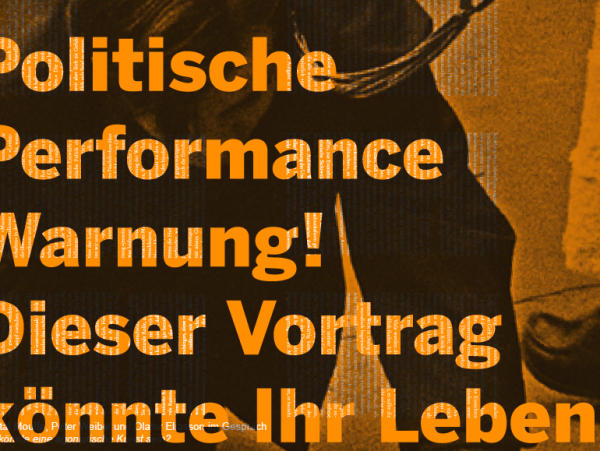
Peter Weibel: Politische Performance: Warnung! Dieser Vortrag könnte Ihr Leben verändern
Public lecture and discussion with Peter Weibel
Peter Weibel: Politische Performance, Part I: Lecture
Peter Weibel: Politische Performance, Part II: Conversation
View poster
Öffentlicher Vortrag und Gespräch mit Peter Weibel
Peter Weibel: Politische Performance, Teil I: Vortrag
Peter Weibel: Politische Performance, Teil II: Diskussion
Plakat ansehen
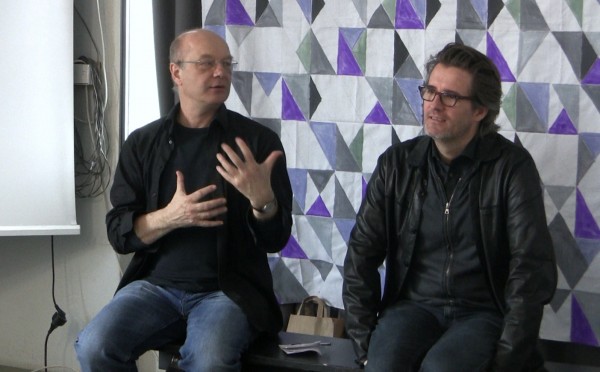
Tor Nørretranders: Empathie und soziales Verhalten
Tor Nørretranders in conversation with Olafur Eliasson
Tor Nørretranders Part I
Tor Nørretranders Part II
Tor Nørretranders Part III
Tor Nørretranders Part IV
Tor Nørretranders im Gespräch mit Olafur Eliasson
Tor Nørretranders Teil I
Tor Nørretranders Teil II
Tor Nørretranders Teil III
Tor Nørretranders Teil IV
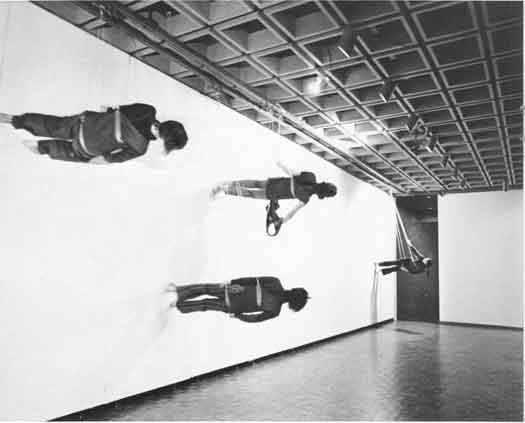
Using What’s Out There For Now, Teil 2
Co-taught seminar by Eric Ellingsen and Berhanu Ashagrie Deribew
Using online archives, particularly UbuWeb, build a class where everyone can take turns curating content and generating critique about art and research methods.
Some examples are: Joseph Beuys – JA JA JA JA JA, NEE NEE NEE NEE NEE (1968), Gordon Matta Clark (Tree Dance), Art Safari – Relational Art: Is It An Ism? (2004), Trisha Brown (Walking on the Wall, Leaning Duets, Accumulation), Ant Farm (Inflatables), Yvonne Rainer (Hand Movie)
Gemeinsames Seminar von Eric Ellingsen und Berhanu Ashagrie Deribew
Seminar zu kritischen Recherchemethoden unter mithilfe von Internet-Archiven, vor allem UbuWeb.
einige Beispiele: Joseph Beuys – JA JA JA JA JA, NEE NEE NEE NEE NEE (1968), Gordon Matta Clark (Tree Dance), Art Safari – Relational Art: Is It An Ism? (2004), Trisha Brown (Walking on the Wall, Leaning Duets, Accumulation), Ant Farm (Inflatables), Yvonne Rainer (Hand Movie)

Using What’s Out There For Now, Teil 1
Co-taught seminar by Eric Ellingsen and Berhanu Ashagrie Deribew
Using online archives, particularly UbuWeb, build a class where everyone can take turns curating content and generating critique about art and research methods.
Some examples are: Joseph Beuys (JA JA JA JA JA, NEE NEE NEE NEE NEE (1968), Gordon Matta Clark (Tree Dance), Art Safari – Relational Art: Is It An Ism? (2004), Trisha Brown (Walking on the Wall, Leaning Duets, Accumulation), Ant Farm (Inflatables), Yvonne Rainer (Hand Movie)
Gemeinsames Seminar von Eric Ellingsen und Berhanu Ashagrie Deribew
Seminar zu kritischen Recherchemethoden mithilfe von Internet-Archiven, vor allem UbuWeb.
einige Beispiele: Joseph Beuys (JA JA JA JA JA, NEE NEE NEE NEE NEE (1968), Gordon Matta Clark (Tree Dance), Art Safari – Relational Art: Is It An Ism? (2004), Trisha Brown (Walking on the Wall, Leaning Duets, Accumulation), Ant Farm (Inflatables), Yvonne Rainer (Hand Movie)

Filmabend: Haile Gerima – Teza
Film screening and discussion of Teza by Haile Gerima (2008)
Moderation by Olafur Eliasson and introduction by Tamrat Gezahegne
still image from Teza
Filmvorführung und Diskussion: Teza von Haile Gerima (2008)
moderiert von Olafur Eliasson und mit einer Einführung von Tamrat Gezahegne
Filmstill aus Teza

Otto’s Impossible Talks / Let’s Start to Implement Little Errors
Book presentation and conversation with Otto E. Rössler during the Rundgang 2010 at UdK Berlin.
Otto’s Impossible Talks / Let’s Start to Implement Little Errors
Edited by Institut für Raumexperimente, Universität der Künste Berlin
Berlin: Verlag der Universität der Künste Berlin, 2010
ISBN 978-3-89462-190-2
On the occasion of the open conversation series Otto’s Impossible Talks: Impossible Topics / Rescued Futures with Otto E. Rössler during the annual exhibition at the UDK 2009 and the related exhibition Let’s Start to Implement Little Errors by the Institut für Raumexperimente, 22-29 May 2010.
Are there connections between the artworks of the participants and the far-reaching topics presented by the controversial chaos researcher Otto Rössler? If there are connections, can they be identified and made visible? Can they lead to interesting, dynamic relationships rather than merely formal relationships between art and science or space and perception?
The publication Otto’s Impossible Talks / Let’s Start to Implement Little Errors answers in the affirmative and offers various attempts to realize these connections. However, these relationships are controversial and reveal tensions. They do not have clearly defined borders or edges; they are striated, not smooth. Images and text overlap each other, complement and limit themselves.
Otto’s Impossible Talks / Let’s Start to Implement Little Errors refracts the dialogue to the exhibition experiment in order to understand relationships and connections as well as different processes that emerged between Rössler’s lecture Otto’s Impossible Talks: Impossible Topics / Rescued Futures and the exhibition Let’s Start to Implement Little Errors.
View publication extract
Buchpräsentation und Gespräch mit Otto E. Rössler während des Rundganges der UdK Berlin.
Otto’s Impossible Talks / Let’s Start to Implement Little Errors
Herausgeber: Institut für Raumexperimente, Berlin University of the Arts (UdK)
Berlin: Verlag der Universität der Künste Berlin, 2010
ISBN 978-3-89462-190-2
Die Teilnehmer des Instituts für Raumexperimente luden den Wissenschaftler Otto E. Rössler zu einem dreitägigen, öffentlichen Gespräch anlässlich des Rundgangs der UdK im Sommer 2009 ein.
Gibt es Bezüge zwischen den Arbeiten der Studenten und den weit greifenden Themen mit denen der umstrittende Chaos-Forscher Rössler sich beschäftigt? Kann solch ein Bezug identifiziert und sichtbar gemacht werden? Können interessante und dynamische Beziehungen entstehen, die über rein formale Bezüge zwischen Kunst und Wissenschaft, Raum und Wahrnehmung hinausreichen?
Die Publikation Otto’s Impossible Talks / Let’s Start to Implement Little Errors zeigt Bespiele wie diese gelingen kann und setzt Otto E. Rösslers Vorträge und die Arbeiten der Studierenden in Beziehung zu einander. Jedoch ist diese Beziehung umstritten und nicht reibungslos. Der Dialog ist mitunter kontrovers und kennt keine starren Regeln. Bilder und Text überlagern einander, ergänzen und begrenzen sich.
Otto’s Impossible Talks / Let’s Start to Implement Little Errors reflektiert in seiner Form den Versuch, mögliche Zusammenhänge und Beziehungen als auch die unterschiedliche Prozesse nachzuvollziehen, die zwischen Rösslers Vortragsreihe Otto’s Impossible Talks: Impossible Topics / Rescued Futures und der darauf Bezug nehmenden Ausstellung Let’s Start to Implement Little Errors entstanden.
Publikationsausschnitt ansehen
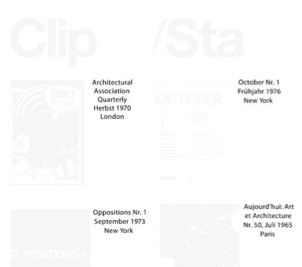
Beatriz Colomina: The Radical Architecture of Little Magazines, 196x-197x
Clip/Stamp/Fold: the Radical Architecture of Little Magazines, 196x-197xPublic lecture and conversation with Beatriz Colomina and Olafur Eliasson
watch lecture by Beatriz Colomina
View poster
Clip/Stamp/Fold: the Radical Architecture of Little Magazines, 196x-197xÖffentlicher Vortrag und Gespräch mit Beatriz Colomina und Olafur Eliasson
Vortrag von Beatriz Colomina anschauen
Poster ansehen
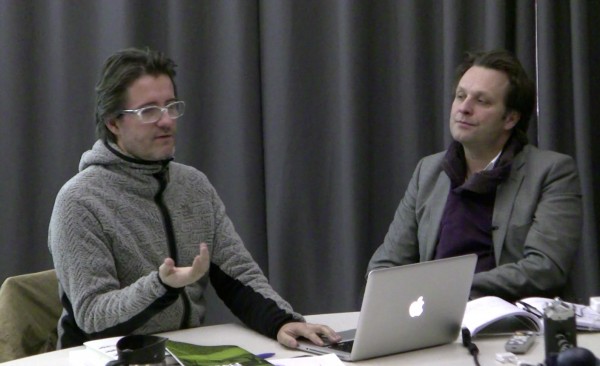
Daniel Birnbaum und Olafur Eliasson: Innen Stadt Aussen
Innen Stadt AussenDaniel Birnbaum and Olafur Eliasson in conversation on their collaboration and exhibition
watch video of the conversation
Innen Stadt AussenDaniel Birnbaum and Olafur Eliasson im Gespräch über ihre Zusammenarbeit und die Ausstellung Innen Stadt Aussen
Video des Gesprächs ansehen
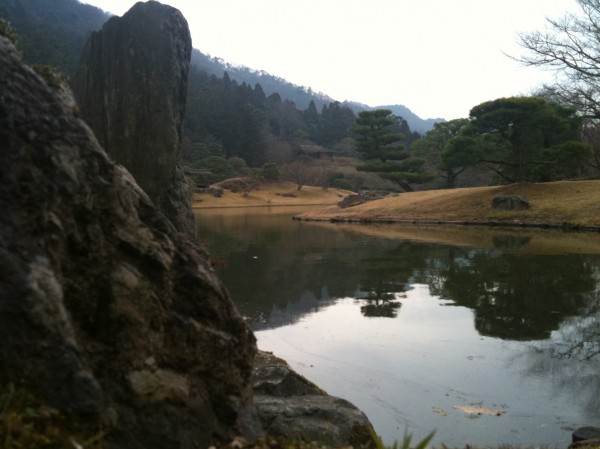
Eric Ellingsen: Phenomenal Narratives in Japanese Gardens
Phenomenal Narratives in Japanese GardensLecture by Eric Ellingsen
Eric Ellingsen: Phenomenal Narratives in Japanese Gardens, Part I
Eric Ellingsen: Phenomenal Narratives in Japanese Gardens, Part II
Eric Ellingsen: Phenomenal Narratives in Japanese Gardens, Part III
Phenomenal Narratives in Japanese GardensVortrag von Eric Ellingsen
Eric Ellingsen: Phenomenal Narratives in Japanese Gardens, Teil I
Eric Ellingsen: Phenomenal Narratives in Japanese Gardens, Teil II
Eric Ellingsen: Phenomenal Narratives in Japanese Gardens, Teil III
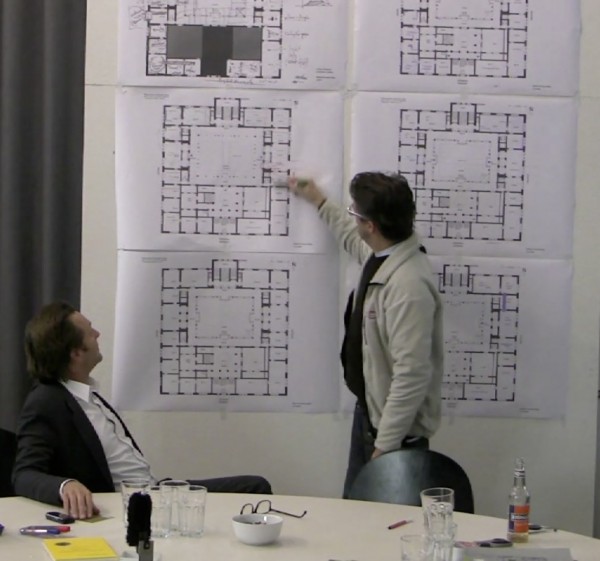
Daniel Birnbaum und Olafur Eliasson
Daniel Birnbaum in conversation with Olafur Eliasson about the exhibition „Innen Stadt Aussen“ at Martin-Gropius-Bau Berlin
watch conversation
Daniel Birnbaum und Olafur Eliasson im Gespräch über die Ausstellung „Innen Stadt Aussen“ im Martin-Gropius-Bau Berlin.
Gespräch anschauen
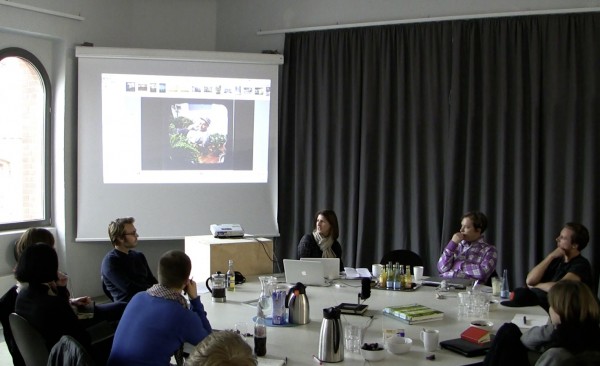
Ariane Beyn
Ariane Beyn and Olafur EliassonPresentation and conversation followed by artist talks with Cyprien Gaillard and Phil Collins
watch lecture by Ariane Beyn
Ariane Beyn und Olafur EliassonVortrag und Gespräch, anschließende Künstlergespräche mit Cyprien Gaillard und Phil Collins
Vortrag von Ariane Beyn anschauen
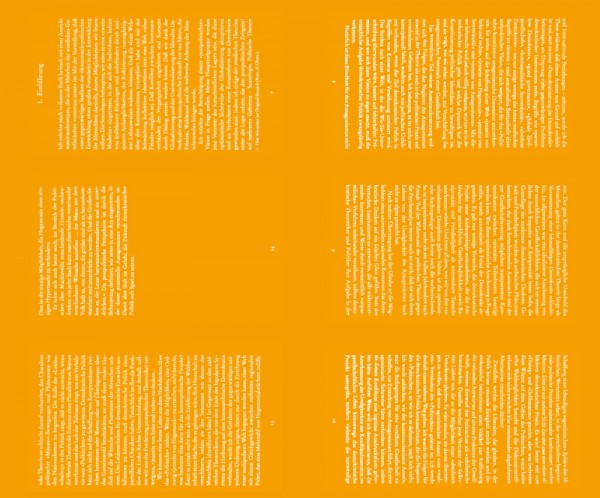
Chantal Mouffe: Was könnte eine agonistische Kunst sein?
What could be agonistic art?Chantal Mouffe and Olafur Eliasson in conversation, with guests Ariane Müller and Andreas Siekmann
watch the conversation
View flyer
Was könnte eine agonistische Kunst sein?Chantal Mouffe und Olafur Eliasson im Gespräch mit den Gästen Ariane Müller und Andreas Siekmann
das Gespräch anschauen
Flyer ansehen
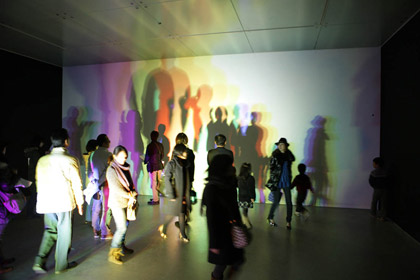
Olafur Eliasson: Your chance encounter & Innen Stadt Aussen
Lecture on the exhibitions Your chance encounter, 21st Century Museum of Contemporary Art, Kanazawa, and Innen Stadt Außen, Martin-Gropius-Bau, Berlin
Vortrag über die Ausstellungen Your chance encounter, 21st Century Museum of Contemporary Art, Kanazawa, und Innen Stadt Außen, Martin-Gropius-Bau, Berlin
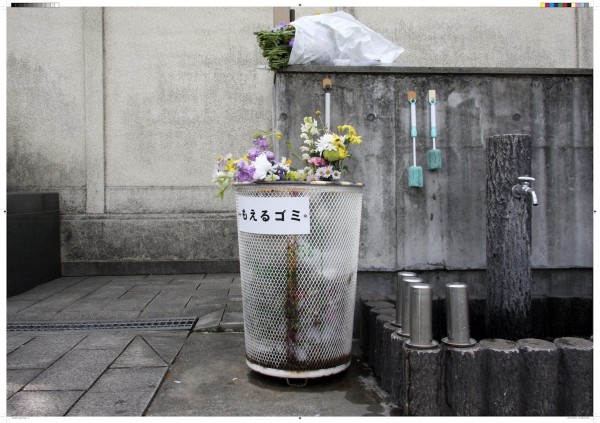
Workshop und Gespräch: Ideas are Motion
Ideas are motion, the Poster as Travel ExperimentWorkshop and conversation for the poster project with Markús pór Andrésson
Participants of Institut für Raumexperimente
Ideas Are Motion: The Poster as an Experiment in Travel is prismatically structured to reflect the making of a class excursion, within the making of an individual art project, within the making of a collective project, within the feeling of a place, within an exhibition in that place.
Ideas Are Motion takes place in(1) Zagreb, Croatia (2) Japan (3) Iceland.
The Institut für Raumexperimente traveled to Kanazawa, Kyoto and Tokyo in February and March 2010 and brings back Ideas Are Motion as part of the exhibition Berlin 2000-2011: Playing amongst the Ruins at the MOT, Museum of Contemporary Art Tokyo from 29.10.2011 – 9.1.2012.
Some posters are sketches of ideas, some finished statements, others dreams, or personal distortions. They are autonomous projects soon to be realized, parts realized in other places, and pitches for projects to come. In a real way, each poster is a still from a moving stream.
Every place is a mangle of spatial relationships involving motions and emotions of scale, speed, perception, attention span, directionality, and distance. Posters are vehicles of urban communication, which materialize these spatial relationships. Posters mobilize populations of perception. We behave differently because of the promiscuity of these kinds of signs in public space. We slow down, think about, read, reflect on, change plans. Urban signs are coordinated around the rhythms of our movement but they also help to coordinate that movement.
Posters are mirrors, which confirm an approach, a direction of arrival, a route of passing through. Posters reflect the population’s psychological relationship to things we personally feel we want or need, and the things we go out of way for. Posters offer a phenomenal vehicle to hitchhike an encounter with art, a formal opportunity to subvert the complete commodification of our public space, while materializing diverse art projects without predetermining an artistic content.
The poster project makes the concept act the art. The act demonstrates a process of how thinking feedbacks into a transformed thought and that thought feeds back into a transformed action of change in the world.
Ideas are motion, the Poster as Travel ExperimentWorkshop und Gespräch zum Posterprojekt mit Markús pór Andrésson
Teilnehmer des Instituts für Raumexperimente
Ideas Are Motion: The Poster as an Experiment in Travel ist ein prismatisch strukturiertes Projekt, das die Erfahrungen einer Klassenreise reflektiert: Prozesse eines individuellen künstlerischen Projektes, Prozesse kollektiven Arbeitens, Prozesse des Erspürens eines Ortes, Prozesse des Ausstellungsmachens an diesem Ort.
Ideas Are Motion findet statt in:(1) Zagreb, Kroatien (2) Japan (3) Island.
Das Institut für Raumexperimente reiste Februar bis März 2010 nach Kanazawa, Kyoto und Tokyo. Ideas Are Motion bringt die Erfahrungen dieser Reise als Teil der Ausstellung Berlin 2000-2011: Playing amongst the Ruins im MOT, Museum of Contemporary Art Tokyo vom 29.10.2011 – 9.1.2012 nach Japan zurück.
Einige Poster sind Skizzen, einige präzise Statements, andere sind Träume oder persönliche Verformungen. Sie sind autonome Projekte, die in Bälde realisieren werden, an anderen Orten bereits realisiert sind oder Vorschläge für die Zukunft. Metaphorisch und tatsächlich ist jedes Poster eine Momentaufnahme eines Ideenstromes.
Jeder Ort ist durchzogen von räumlichen Verhältnissen, die Bewegungen von und Gefühle für Maßstab, Geschwindigkeit, Wahrnehmung, Aufmerksamkeitsspanne, Richtung und Entfernung einschließen. Poster sind Vehikel urbaner Kommunikation, in denen sich diese Verhältnisse materialisieren. Poster mobilisieren vielfältige Wahrnehmungsräume. Die Promiskuität dieser Zeichen im öffentlichen Raum beeinflusst unser Verhalten. Wir halten an, lesen, denken nach, reflektieren und ändern unsere Pläne. Urbane Zeichen werden choreographiert entsprechend unserer Bewegungsmuster, können aber andererseits auch helfen, jene Bewegungen zu koordinieren.
Poster sind Spiegel, die eine Annäherung, eine Ankunft, ein Passieren markieren. Poster reflektieren die psychologischen Beziehungsmuster unserer Gesellschaften zu Dingen, die wir persönlich attraktiv finden, mögen oder auch meiden. Poster bieten sich an als Medium einer unkonventionelleren Begegnung mit Kunst und als formale Möglichkeit, die vollständige Kommerzialisierung unserer öffentlichen Räume zu unterlaufen. Dabei können die unterschiedlichsten Kunstprojekte entstehen, ohne dass der künstlerische Inhalt festgelegt wäre.
Das Posterprojekt macht den konzeptuellen Akt zur Kunst. Dieser Akt der Umsetzung demonstriert wie Denkprozesse mit sich verändernden Ideen rückgekoppelt sind und diese Ideen Handlungen beeinflussen, die Veränderungen in der Welt bewirken.
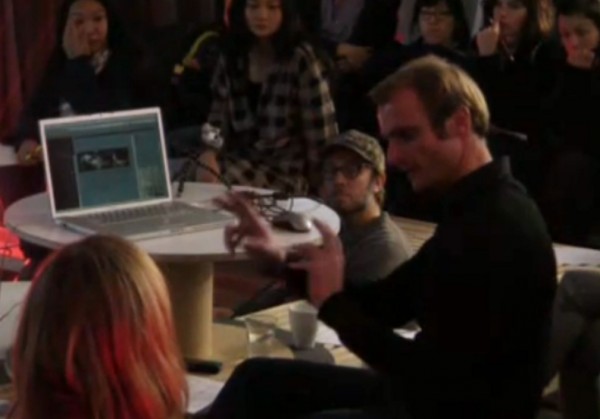
Florian Wüst: In the Face of Nature
In the Face of NatureFilm-based lecture by Florian Wüst
watch lecture In the Face of Nature, Part 1 by Florian Wüst
watch lecture In the Face of Nature, Part 2 by Florian Wüst
watch lecture In the Face of Nature, Part 3 by Florian Wüst
Excerpts and film sequences from:
Kuzu (Junk)
Takahiko Iimura, JP 1962, 12′
La Région Centrale
Michael Snow, CA 1971, 180′
Sky Light
Chris Welsby, UK 1988, 26′
I. E. [site 01 – isole eolie]
Lotte Schreiber, A 2004, 8′
OKAY OKAY. Der moderne Tanz
Christoph Dreher & Heiner Mühlenbrock, BRD 1980, 90′
Blight
John Smith, UK 1996, 14′
Apple Grown in Wind Tunnel
Steven Matheson, USA 2000, 26′
In the Face of NatureVortrag von Florian Wüst anhand von Filmen
Vortrag von Florian Wüst anschauen
Vortrag In the Face of Nature, Part 1 von Florian Wüst anschauen
Vortrag In the Face of Nature, Part 2 von Florian Wüst anschauen
Vortrag In the Face of Nature, Part 3 von Florian Wüst anschauen
Auszüge und Filmsequenzen aus:
Kuzu (Junk)
Takahiko Iimura, JP 1962, 12′
La Région Centrale
Michael Snow, CA 1971, 180′
Sky Light
Chris Welsby, UK 1988, 26′
I. E. [site 01 – isole eolie]
Lotte Schreiber, A 2004, 8′
OKAY OKAY. Der moderne Tanz
Christoph Dreher & Heiner Mühlenbrock, BRD 1980, 90′
Blight
John Smith, UK 1996, 14′
Apple Grown in Wind Tunnel
Steven Matheson, USA 2000, 26′
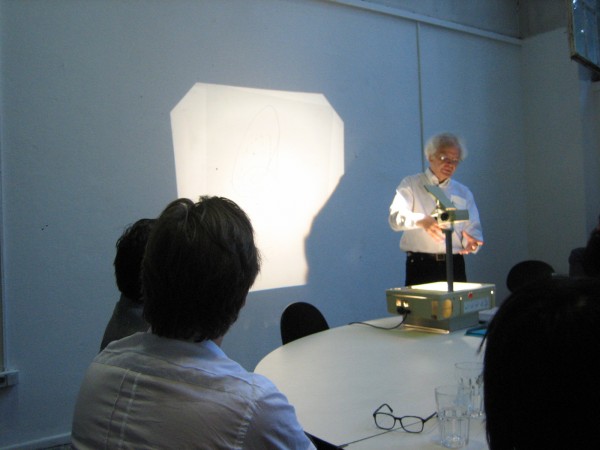
Otto’s Impossible Talks: Impossible Topics / Rescued Futures
Otto’s Impossible Talks: Impossible Topics / Rescued Futures
public conversation with Otto E. Rössler on invitation of Institut für Raumexperimente’s participants
Ottos unmögliche Gespräche: Unmögliche Themen / Gerettete Zukünfte
Öffentliches Gespräch mit Otto E. Rössler auf Einladung der Teilnehmer des Instituts für Raumexperimente im Rahmen des UdK Rundgang
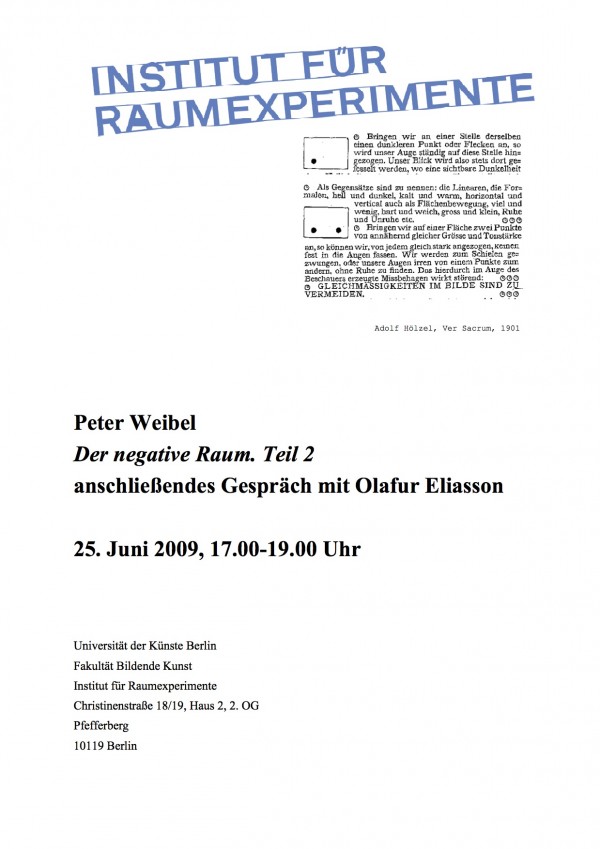
Peter Weibel: Der Negative Raum, Teil II
The Negative Space, Part II Peter Weibel in conversation with Otto E. Rössler and
Olafur Eliasson, public lecture
Peter Weibel, The Negative Space, Part II
Peter Weibel and Otto E. Rössler
Otto E. Rössler
Poster
Der Negative Raum, Teil II Peter Weibel im Gespräch mit Otto E. Rössler und
Olafur Eliasson, öffentlicher Vortrag
Peter Weibel: Der Negative Raum, Teil II
Peter Weibel und Otto E. Rössler
Otto E. Rössler
Poster
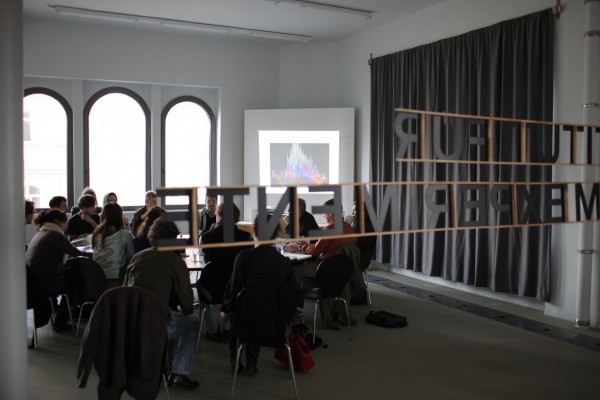
Peter Coles und Matthew Ritchie im Gespräch mit Caroline A. Jones und Olafur Eliasson
Peter Coles and Matthew Ritchie in conversation with Caroline A. Jones and Olafur Eliasson
Peter Coles and Matthew Ritchie, Part 1
Peter Coles and Matthew Ritchie, Part 2
Peter Coles und Matthew Ritchie im Gespräch mit Caroline A. Jones und Olafur Eliasson
Peter Coles and Matthew Ritchie, Teil 1
Peter Coles and Matthew Ritchie, Teil 2
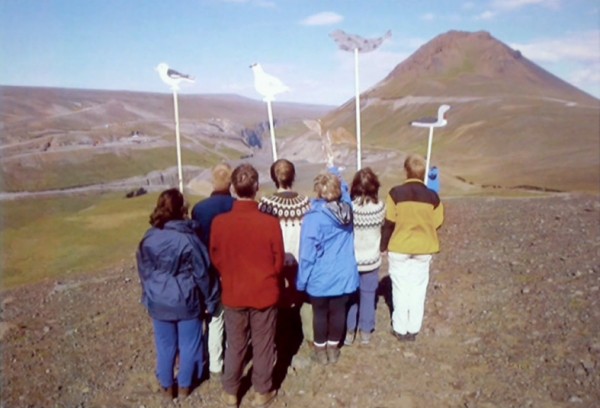
Ósk Vilhjálmsdóttir: WanderLust und ökologischer Aktivismus in Island
WanderLust and Ecological Activism in IcelandArtist talk by Ósk Vilhjálmsdóttir
Ósk Vilhjálmsdóttir: WanderLust and Ecological Activism in Iceland
WanderLust und ökologischer Aktivismus in IslandKünstlergespräch mit Ósk Vilhjálmsdóttir
Ósk Vilhjálmsdóttir: WanderLust und ökologischer Aktivismus in Island
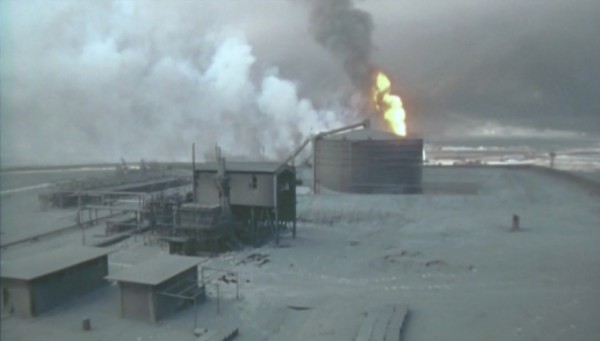
Eric Ellingsen: We are a History of Nature
We are a History of Naturelecture by Eric Ellingsen
Eric Ellingsen: We are a History of Nature, Part I
Eric Ellingsen: We are a History of Nature, Part II
Eric Ellingsen: We are a History of Nature, Part III
We are a History of NatureVortrag von Eric Ellingsen
Eric Ellingsen: We are a History of Nature, Teil I
Eric Ellingsen: We are a History of Nature, Teil II
Eric Ellingsen: We are a History of Nature, Teil III
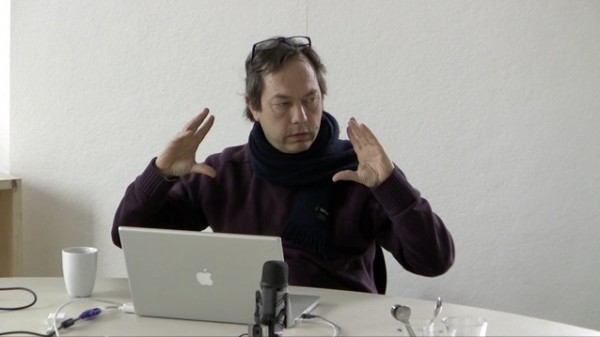
Luc Steels und Olafur Eliasson: Robotic Experiments
Robotic Experiments: Experience of Space in Relation to Language
Workshop with Luc Steels and Olafur Eliasson
Workshop with Luc Steels and Olafur Eliasson
Robotic Experiments: Experience of Space in Relation to Language
Workshop mit Luc Steels und Olafur Eliasson
Workshop mit Luc Steels und Olafur Eliasson
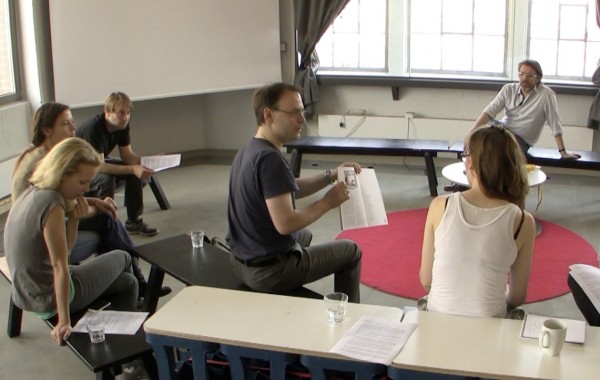
Olafur Eliasson & Guido Brendgens
Conversation with Olafur Eliasson & Guido Brendgens
Olafur Eliasson & Guido Brendgens in conversation, Part I
Olafur Eliasson & Guido Brendgens in conversation, Part II
Gespräch mit Olafur Eliasson & Guido Brendgens
Olafur Eliasson & Guido Brendgens im Gespräch, Teil I
Olafur Eliasson & Guido Brendgens im Gespräch, Teil II
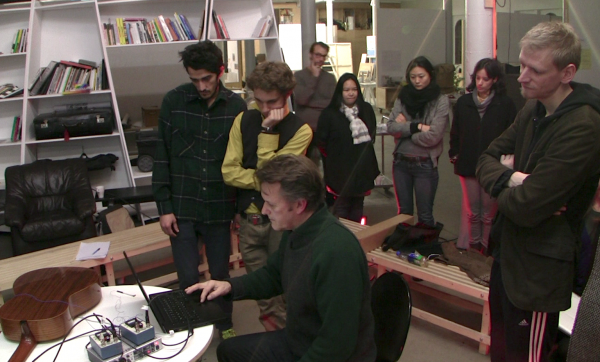
Hans Johansson & Susan Philipsz: On Sound
On Sound - Artist talk with Susan Philipsz
Susan Philipsz Part 1
Susan Philipsz Part 2
On Sound - Artist talk and experiments with Hans Johannsson
Hans Johannsson
On Sound - Künstlergespräch mit Susan Philipsz
Künstlergespräche und Experimente: „On Sound“ mit Hans Johannsson & Susan Philipsz
Susan Philipsz Teil 1
Susan Philipsz Teil 2
On Sound - Künstlergespräch und Experimente mit Hans Johannsson
Hans Johannsson
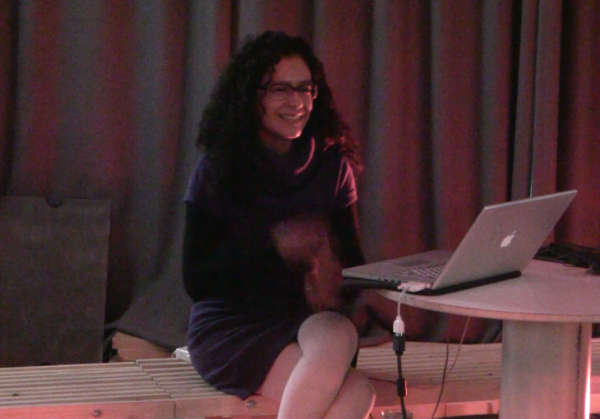
Künstlergespräche mit Mariana C. Deball und Christoph Keller
Artist talks with Mariana C. Deball and Christoph Keller
Mariana C. Deball
Christoph Keller
RELATED READING MATERIAL
Heidenreich, Stefan und Christoph Keller, „Verbal / Nonverbal“, in: Christoph Keller. Verbal / Nonverbal, October 5 – November 13, hrsg. von Esther Schipper, Ausst.-Kat. Galerie Esther Schipper, Berlin 2010.
Vogl, Joseph, „Über das Sammeln. Aus einem Gespräch mit Christoph Keller“, in: Christoph Keller. Verbal / Nonverbal, October 5 – November 13, hrsg. von Esther Schipper, Ausst.-Kat. Galerie Esther Schipper, Berlin 2010.
Künstlergespräche mit Mariana C. Deball und Christoph Keller
Mariana C. Deball
Christoph Keller
LITERATURAUSWAHL
Heidenreich, Stefan und Christoph Keller, „Verbal / Nonverbal“, in: Christoph Keller. Verbal / Nonverbal, October 5 – November 13, hrsg. von Esther Schipper, Ausst.-Kat. Galerie Esther Schipper, Berlin 2010.
Vogl, Joseph, „Über das Sammeln. Aus einem Gespräch mit Christoph Keller“, in: Christoph Keller. Verbal / Nonverbal, October 5 – November 13, hrsg. von Esther Schipper, Ausst.-Kat. Galerie Esther Schipper, Berlin 2010.

Reading Group: Texte von Brian Massumi & Erin Manning
Reading group with Eric Ellingsen & Christina Werner
SELECTED READING MATERIAL
Manning, Erin und Brian Massumi, Coming Alive in a World of Texture: For Neurodiversity, Vortrag, Justus-Liebig- Universität Giessen, 02.11.2010.
Massumi, Brian, „The Diagram as Technique of Existence. Ovum of the Universe Segmented“, in: Semblance and Event: Arts of Experience, Politics of Expression, Cambridge 2011., o. S.
Lektüreseminar mit Eric Ellingsen & Christina Werner
LITERATURAUSWAHL
Manning, Erin und Brian Massumi, Coming Alive in a World of Texture: For Neurodiversity, Vortrag, Justus-Liebig- Universität Giessen, 02.11.2010.
Massumi, Brian, „The Diagram as Technique of Existence. Ovum of the Universe Segmented“, in: Semblance and Event: Arts of Experience, Politics of Expression, Cambridge 2011., o. S.
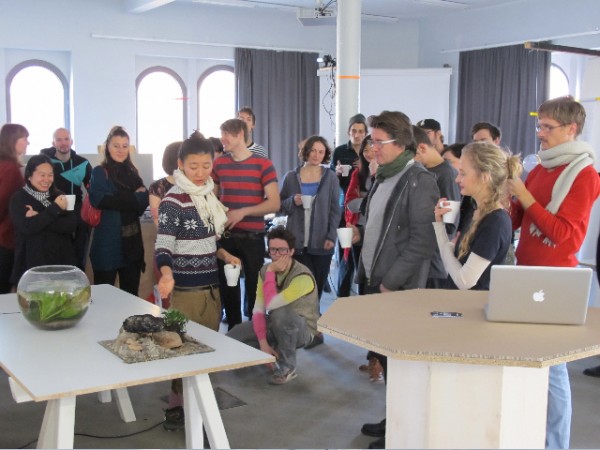
Roadtrip Präsentation und Arbeitsgespräch mit Olafur Eliasson
Road trip presentations and critiques with Olafur Eliasson, Eric Ellingsen and Christina Werner
Bing Bang Road Trip:
Like the Big Bang, the group of participants explodes in all directions through and outside of Berlin. The road trips are intended to produce an experimental work of art creatively incorporating the constraints of travel, space, a limited budget, and a small fixed frame of time in a trajectory centered on Berlin.
The destination of the travel is the movement rather than a place. The speed of getting to a place is crucial. How the body moves; what moves the body. What you see, hear, smell, taste, feel as you travel, each sense stretched at different speeds.
How are space and time and body consciously engaged interior to a project rather than exterior to a work? Why decide to move one way rather than another? What is distance and how is distance measured, documented, recorded, and re-communicated? What instruments are used to record or narrate the trajectory? Can the body be incorporated in this instrument as an instrument of feelings and measure? How can constraints of distance, time, budget, and measure be used as a web of interrelationships to design an experiment? How is the making of the project done simultaneously with the documentation of the project? How can the structuring of a road trip be used to inform the structuring of an artistic experiment?
Examples of road trips, movements and measures are discussed before the trip starts, including texts and projects by Robert Smithson and Gordon Matta Clark, Wim Wenders’ Kings of the Road, to Dennis Hoppers Easy Rider, Cynthia Beatt’s Cycling the Frame and The Invisible Frame, Olafur Eliasson and Hans Ulrich Obrist road trip interviews, or readings from Georges Perec’s The Street: Practical Exercise, among others.
After everyone returns, encounters and experiences are shared and discussed. Each participant presents how he or she measured, documented, recorded, and re-communicate their experiment, their trip, their work.
Roadtrip Präsentation und Gespräche mit Olafur Eliasson, Eric Ellingsen und Christina Werner
Bing Bang Road Trip:
Like the Big Bang, the group of participants explodes in all directions through and outside of Berlin. The road trips are intended to produce an experimental work of art creatively incorporating the constraints of travel, space, a limited budget, and a small fixed frame of time in a trajectory centered on Berlin.
The destination of the travel is the movement rather than a place. The speed of getting to a place is crucial. How the body moves; what moves the body. What you see, hear, smell, taste, feel as you travel, each sense stretched at different speeds.
How are space and time and body consciously engaged interior to a project rather than exterior to a work? Why decide to move one way rather than another? What is distance and how is distance measured, documented, recorded, and re-communicated? What instruments are used to record or narrate the trajectory? Can the body be incorporated in this instrument as an instrument of feelings and measure? How can constraints of distance, time, budget, and measure be used as a web of interrelationships to design an experiment? How is the making of the project done simultaneously with the documentation of the project? How can the structuring of a road trip be used to inform the structuring of an artistic experiment?
Examples of road trips, movements and measures are discussed before the trip starts, including texts and projects by Robert Smithson and Gordon Matta Clark, Wim Wenders’ Kings of the Road, to Dennis Hoppers Easy Rider, Cynthia Beatt’s Cycling the Frame and The Invisible Frame, Olafur Eliasson and Hans Ulrich Obrist road trip interviews, or readings from Georges Perec’s The Street: Practical Exercise, among others.
After everyone returns, encounters and experiences are shared and discussed. Each participant presents how he or she measured, documented, recorded, and re-communicate their experiment, their trip, their work.

Gespräch mit Erin Manning und Brian Massumi
Conversation with Erin Manning and Brian Massumi
Erin Manning and Brian Massumi Part I
Erin Manning and Brian Massumi Part II
Erin Manning and Brian Massumi Part III
Gespräch mit Erin Manning und Brian Massumi
Erin Manning und Brian Massumi Teil I
Erin Manning und Brian Massumi Teil II
Erin Manning und Brian Massumi Teil III
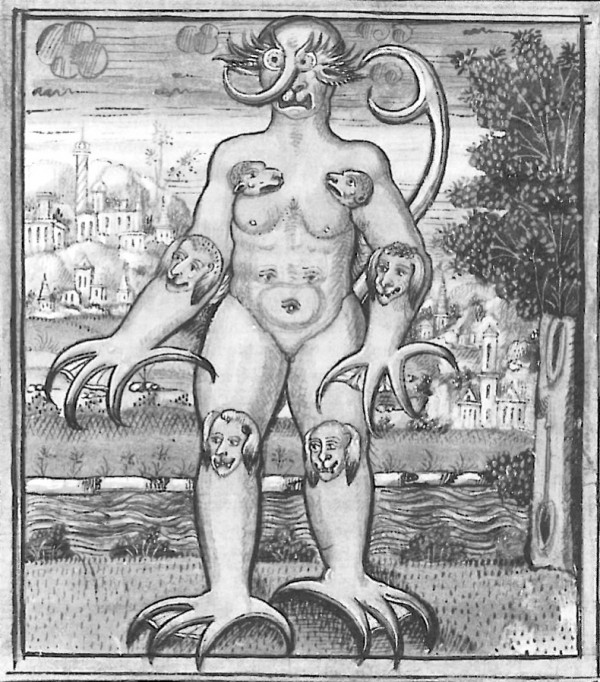
Lorraine Daston: The Passions in Which Time Stands Still: Horror, Terror, and Wonder
Lorraine Daston in conversation with Olafur Eliasson and Mohsen Mostafavi
„The passions in which time stands still: horror, terror, and wonder“
Winter solstice; shortest day of the year workshop
Lorraine Daston Part I
Lorraine Daston Part II
Lorraine Daston im Gespräch mit Olafur Eliasson und Mohsen Mostafavi
„The passions in which time stands still: horror, terror, and wonder“
Wintersonnenwende; Workshop am kürzesten Tag des Jahres
Lorraine Daston Teil I
Lorraine Daston Teil II
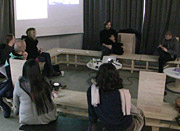
Elie During: Ahead of Time
Elie During: Ahead of TimeLecture and conversation on concepts of Time developed by Bergson and Einstein and their dispute
Elie During Part I
Elie During Part II
Elie During Part III
Elie During Part IV
Elie During Part V
Elie During: Ahead of TimeVortrag und Seminar zur Konzeption von Zeit bei Bergson und Einstein und deren Debatte
Elie During Teil I
Elie During Teil II
Elie During Teil III
Elie During Teil IV
Elie During Teil V
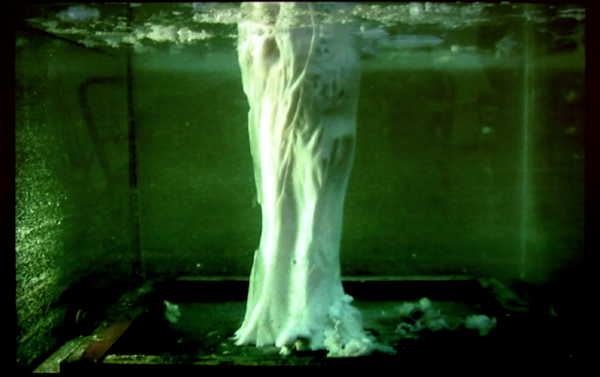
Marta Malé-Alemany: Modellierung und Prototypenerstellung
Conversation with Marta Malé-Alemany and Eric Ellingsen
Guests: Katrin Schamun and the class of Wiel Arets
Marta Malé-Alemany
Vortrag und Gespräch mit Marta Malé-Alemany und Eric Ellingsen
Gäste: Katrin Schamun und Klasse Wiel Arets
Marta Malé-Alemany
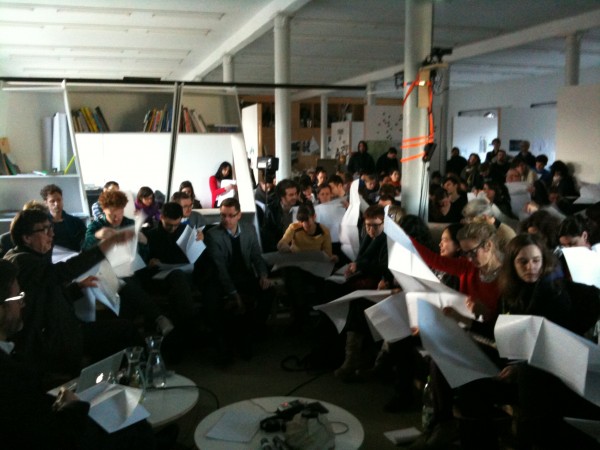
Three Days of Making Time: Revisiting the Debate between Bergson and Einstein
Three Days of Making Time: Revisiting the Debate between Bergson and EinsteinWith Bruno Latour and Olafur Eliasson. Collaboration between Master of Experimentation on Arts and Politics, Sciences Po, Paris, and Institut für Raumexperimente, UdK Berlin.
Day 1One-minute Experiments. Presentation by the participants from Institut für Raumexperimente and the Master of Experimentation on Arts and Politics. Workshop and conversation with Eric Ellingsen, Valerie Pihet, Christina Werner and guests Armin Linke, Nina Fischer and Maroan el Sani
One-minute experiments from both classes
Day 2Reenactments, Catastrophes, and Gaia: Lecture by Bruno Latour. Guided tour of Studio Olafur Eliasson. Making Time: Conversation with Bruno Latour and Olafur Eliasson.
Bruno Latour: Reenactments, Catastrophes, and Gaia, part 1
Bruno Latour: Reenactments, Catastrophes, and Gaia, part 2
Day 3Revisiting the debate between Bergson and Einstein: Public lecture by Olafur Eliasson and Bruno Latour and conversation about the public Bergson-Einstein reenactment experiment. One-minute closed-eye experiment with Eric Ellingsen
Bruno Latour and Olafur Eliasson: Making Time, part 1
Bruno Latour and Olafur Eliasson: Making Time, part 2
Bruno Latour and Olafur Eliasson: Making Time, part 3
View poster
SELECTED READING MATERIAL
Gunter, Peter Addisson Y., „Henri Bergson, Albert Einstein and Henri Piéron. Remarks Concerning Relativity Theory“, in: ders., Bergson and the Evolution of Physics, Knoxville 1969, S. 123–135.
Latour, Bruno, „Some Experiments in Art and Politics“, in: E-Flux Journal, 23, New York 2011, http://www.e-flux.com/journal/some-experiments-in-art-and-politics/ (abgerufen 2011).
Latour, Bruno, „Spheres and Networks: Two Ways to Reinterpret Globalization“, in: Harvard Design Magazine, 30, Harvard 2009, S. 138–144.
Three Days of Making Time: Revisiting the Debate between Bergson and EinsteinMit Bruno Latour und Olafur Eliasson. Kollaboration zwischen Master of Experimentation on Arts and Politics, Sciences Po, Paris, und Institut für Raumexperimente, UdK Berlin.
Tag 1Ein-Minuten-Experimente der Teilnehmer des Instituts für Raumexperimente und des Master of Experimentation on Arts and Politics. Workshop und Gespräch mit Eric Ellingsen, Valerie Pihet, Christina Werner und Gästen Armin Linke, Nina Fischer und Maroan el Sani
Ein-Minuten-Experimente beider Klassen
Tag 2Reenactments, Katastrophen und Gaia: Vortrag von Bruno Latour. Führung durch das Studio Olafur Eliasson. Making Time: Gespräch mit Bruno Latour und Olafur Eliasson.
Bruno Latour: Reenactments, Katastrophen und Gaia, Teil 1
Bruno Latour: Reenactments, Katastrophen und Gaia, Teil 2
Tag 3Wiederaufnahme der Debatte zwischen Bergson und Einstein: Öffentlicher Vortrag von Olafur Eliasson und Bruno Latour und Gespräch über das Bergson-Einstein-Reenactment. Einminütiges Experiment mit geschlossenen Augen von Eric Ellingsen
Bruno Latour und Olafur Eliasson, Teil 1
Bruno Latour und Olafur Eliasson, Teil 2
Bruno Latour und Olafur Eliasson, Teil 3
Plakat ansehen
LITERATURAUSWAHL
Gunter, Peter Addisson Y., „Henri Bergson, Albert Einstein and Henri Piéron. Remarks Concerning Relativity Theory“, in: ders., Bergson and the Evolution of Physics, Knoxville 1969, S. 123–135.
Latour, Bruno, „Some Experiments in Art and Politics“, in: E-Flux Journal, 23, New York 2011, http://www.e-flux.com/journal/some-experiments-in-art-and-politics/ (abgerufen 2011).
Latour, Bruno, „Spheres and Networks: Two Ways to Reinterpret Globalization“, in: Harvard Design Magazine, 30, Harvard 2009, S. 138–144.
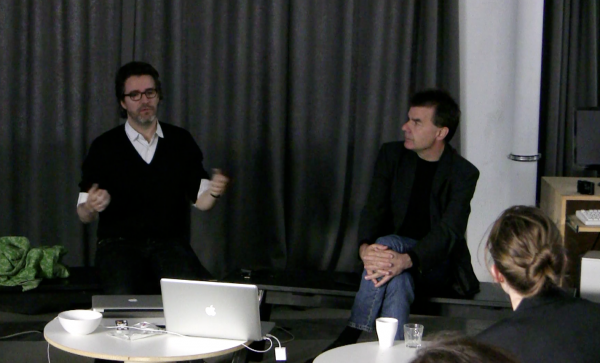
Einführung mit Günther Vogt & Olafur Eliasson: Mapping Everything
Talk and introduction to the collaboration project „Mapping Everything“ with Günther Vogt and Olafur Eliasson
Günther Vogt Part I
Günther Vogt Part II
Günther Vogt Part III
Gespräch und Einführung zum Kooperationsprojekt „Mapping Everything“ mit Günther Vogt und Olafur Eliasson
Günther Vogt Teil I
Günther Vogt Teil II
Günther Vogt Teil III
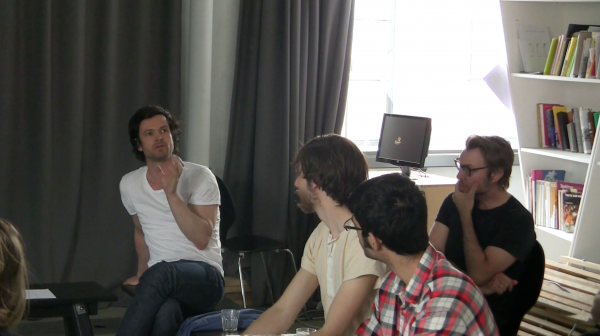
Arbeitspräsentationen mit Gastkritiker Jeroen Jacobs
Individual critiques with Jeroen JacobsWork presentations by Julian Charrière, Felix Kiessling & Pireeni Sundaralingam
Arbeitspräsentation: Julian Charrière & Felix Kiessling & Pireeni Sundaralingam
Arbeitspräsentationen mit Gastkritiker Jeroen JacobsPräsentationen von Julian Charrière & Felix Kiessling & Pireeni Sundaralingam
Gastkritiker: Jeroen Jacobs
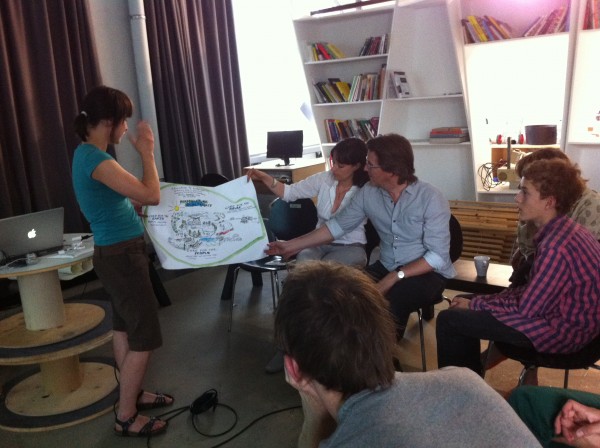
Arbeitsgespräche
Presentations by Elise Eeraerts, Gabrielle Mainguy, Alvaro Urbano and Merlin Carter
Gabrielle Mainguy
Merlin Carter
Elise Eeraerts
Alvaro Urbano
Arbeitsgespräche mit Elise Eeraerts, Gabrielle Mainguy, Alvaro Urbano und Merlin Carter
Gabrielle Mainguy
Merlin Carter
Elise Eeraerts
Alvaro Urbano

Projektbesprechung: Mapping Everything
Conversation and project preparation with Olafur Eliasson, Eric Ellingsen & Christina Werner
Presentation of interview project by Silke Feldhoff
Arbeitsgespräch zur Ausstellungs- und Projektvorbereitung mit Olafur Eliasson, Eric Ellingsen & Christina Werner
Vorstellung der Interviewprojektstudie von Silke Feldhoff
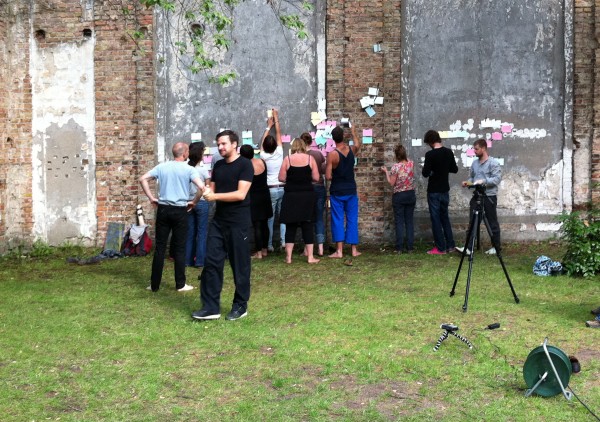
Mapping Everything
Mapping EverythingA collaborative, educational experiment between the Institut für Raumexperimente and the Institut für Landschaftsarchitektur (ETH Zürich), class of Günther Vogt, in the summer term of 2011.
Go to: Mapping Everything publication
Mapping EverythingEin kollaboratives, universitäres Experiment zwischen dem Institut für Raumexperimente und dem Institut für Landschaftsarchitektur (ETH Zürich), der Klasse von Günther Vogt, im Sommersemester 2011.
Zur Publikation

Semester- Abschlussgespräch mit Olafur Eliasson
Critique of „Rundgang Occupation“ and the collaboration and exhibition project „Mapping Everything“ with Olafur Eliasson
Semester-Abschlussgespräch zu „Rundgang Occupation“ und dem Ausstellungs- und Kooperationsprojekt „Mapping Everything“
mit Olafur Eliasson
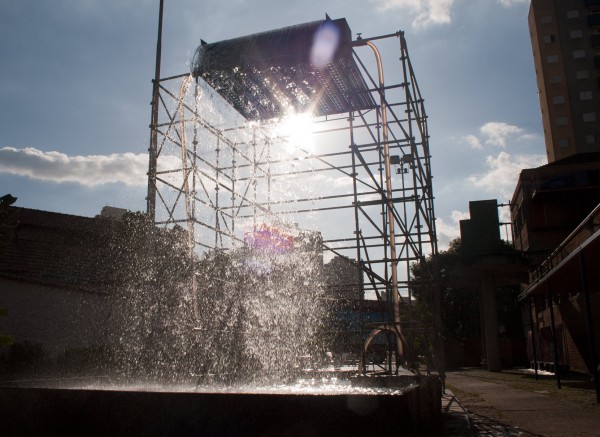
Olafur Eliasson & Caroline Eggel über die Ausstellung „Your body of work“
Presentation of „Your body of work“: exhibition at Pinacoteca do Estado de São Paulo, SESC Pompeia, and SESC Belenzinho, Sao Paulo by Olafur Eliasson & Caroline Eggel
Vortrag zur Ausstellung „Your body of work“: Pinacoteca do Estado de São Paulo, SESC Pompeia, and SESC Belenzinho, Sao Paulo, Arbeitsgespräch mit Olafur Eliasson & Caroline Eggel
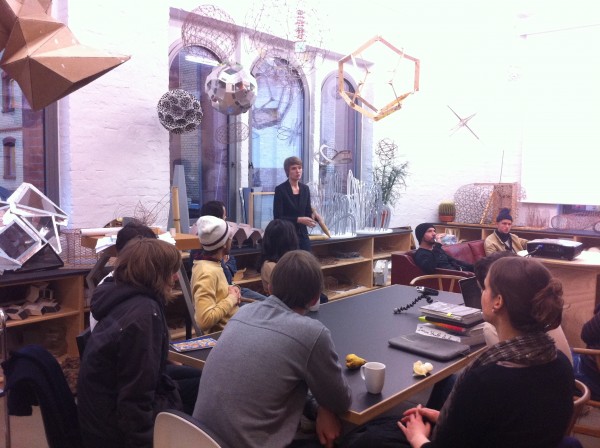
Archivierung & Archiv im Studio Olafur Eliasson
Conversation with Anna Engberg-Pedersen, Eric Ellingsen, Biljana Joksimovic, Anna Kreutzträger, and Christina Werner
Archiving & Archive at Studio Olafur Eliasson, part 1
Archiving & Archive at Studio Olafur Eliasson, part 2
Archiving & Archive at Studio Olafur Eliasson, part 3
Archiving & Archive at Studio Olafur Eliasson, part 4
Gespräch mit Anna Engberg-Pedersen, Eric Ellingsen, Biljana Joksimovic, Anna Kreutzträger und Christina Werner
Archivierung & Archiv im Studio Olafur Eliasson, Teil 1
Archivierung & Archiv im Studio Olafur Eliasson, Teil 2
Archivierung & Archiv im Studio Olafur Eliasson, Teil 3
Archivierung & Archiv im Studio Olafur Eliasson, Teil 4
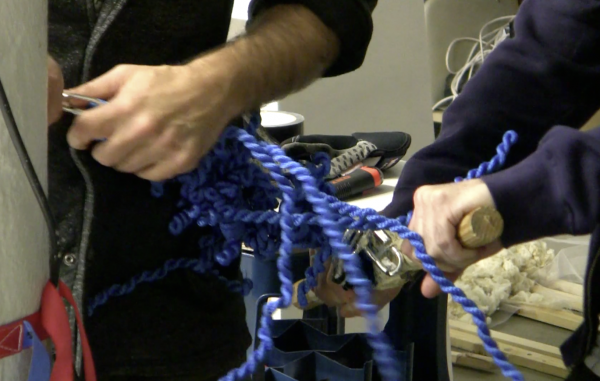
Eric Ellingsen: Twisted Futures and What Knots to Do
Presentation by Eric Ellingsen
Eric Ellingsen: Spontaneous Patterns, part 1
Eric Ellingsen: Spontaneous Patterns, part 2
Eric Ellingsen: Spontaneous Patterns, part 3
Vortrag von Eric Ellingsen
Eric Ellingsen: Spontaneous Patterns, Teil 1
Eric Ellingsen: Spontaneous Patterns, Teil 2
Eric Ellingsen: Spontaneous Patterns, Teil 3
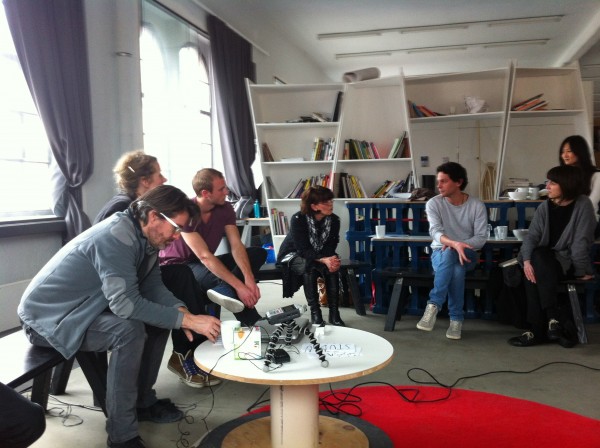
Angela Büchle: Träume
Semester introduction with Olafur Eliasson
Dream interpretation with Angela Büchle
Talk with Angela Büchle on dreams and dream interpretation, Part I
Talk with Angela Büchle on dreams and dream interpretation, Part II
Talk with Angela Büchle on dreams and dream interpretation, Part III
Semestereröffnung mit Olafur Eliasson
Traumdeutung mit Angela Büchle
Gespräch mitAngela Büchle über Träume und Traumdeutung, Teil I
Gespräch mitAngela Büchle über Träume und Traumdeutung, Teil II
Gespräch mitAngela Büchle über Träume und Traumdeutung, Teil III
